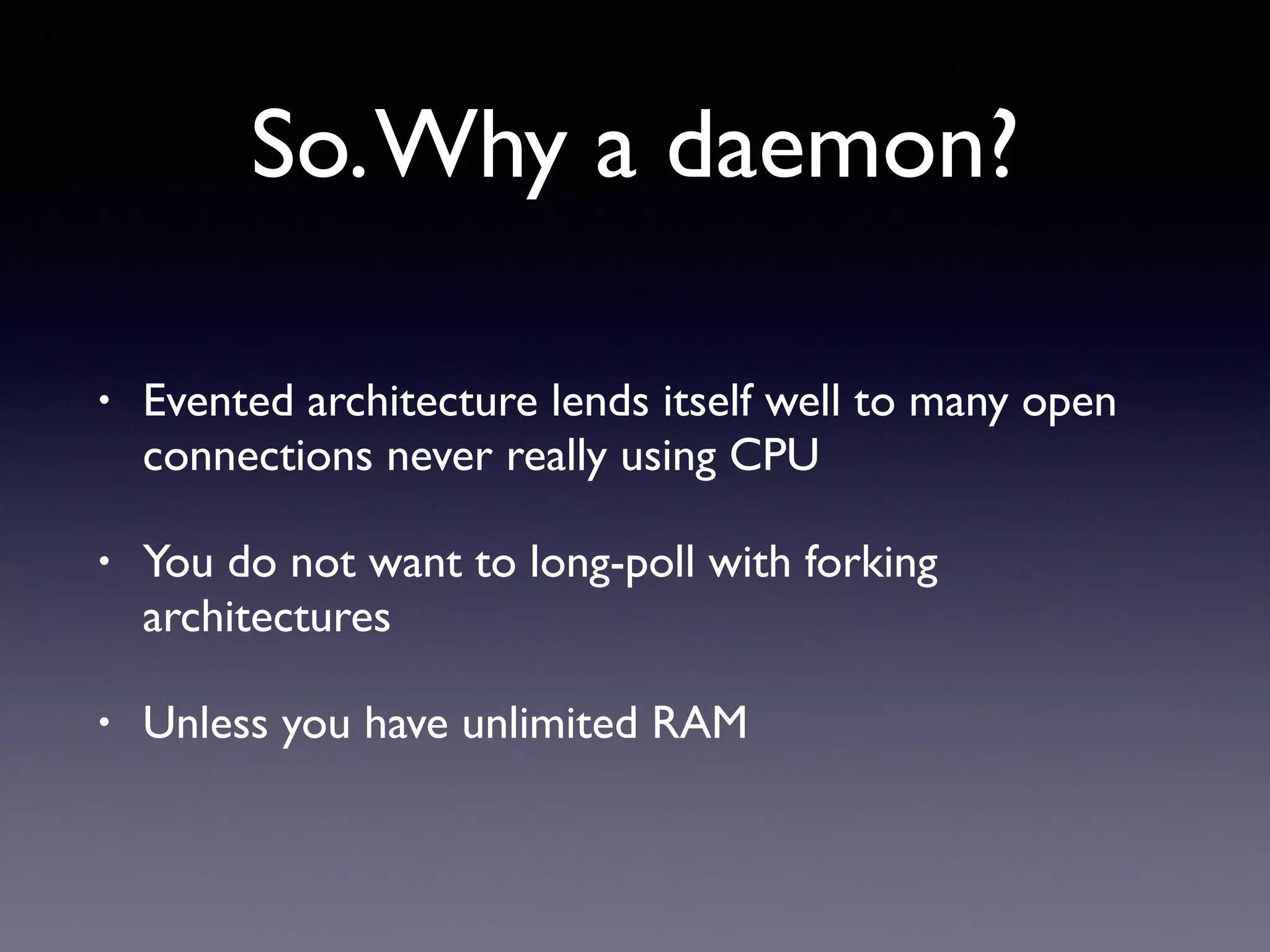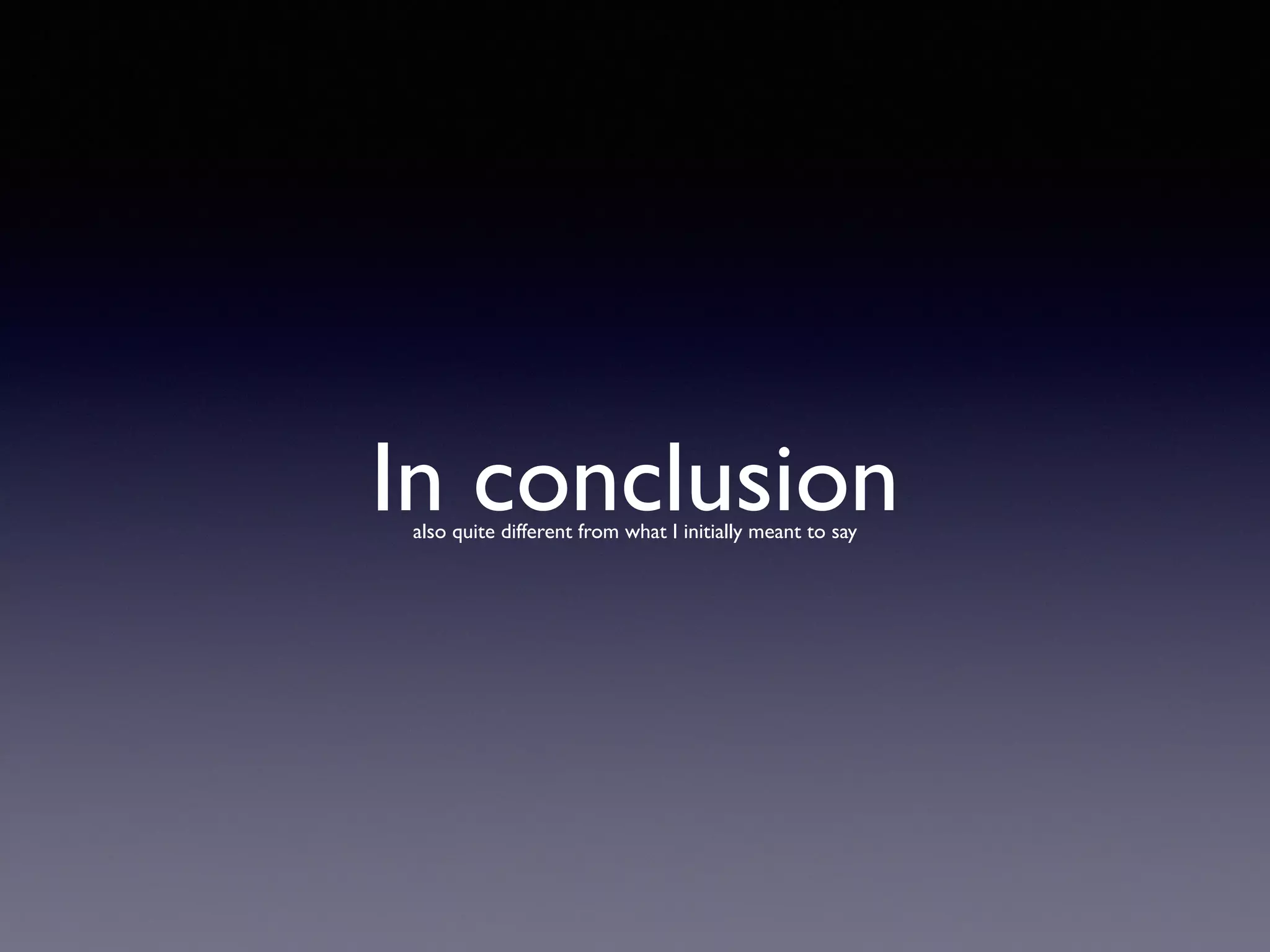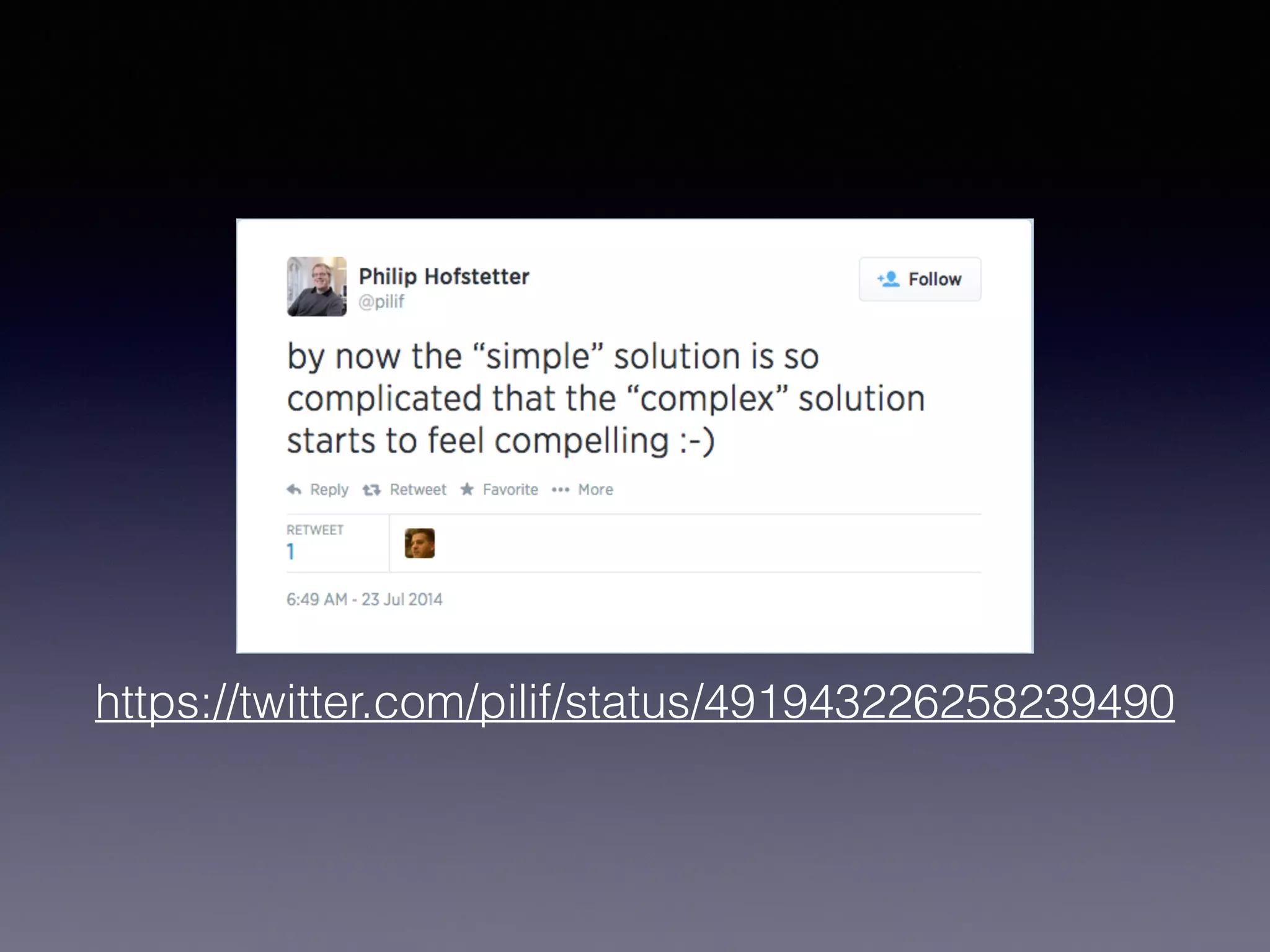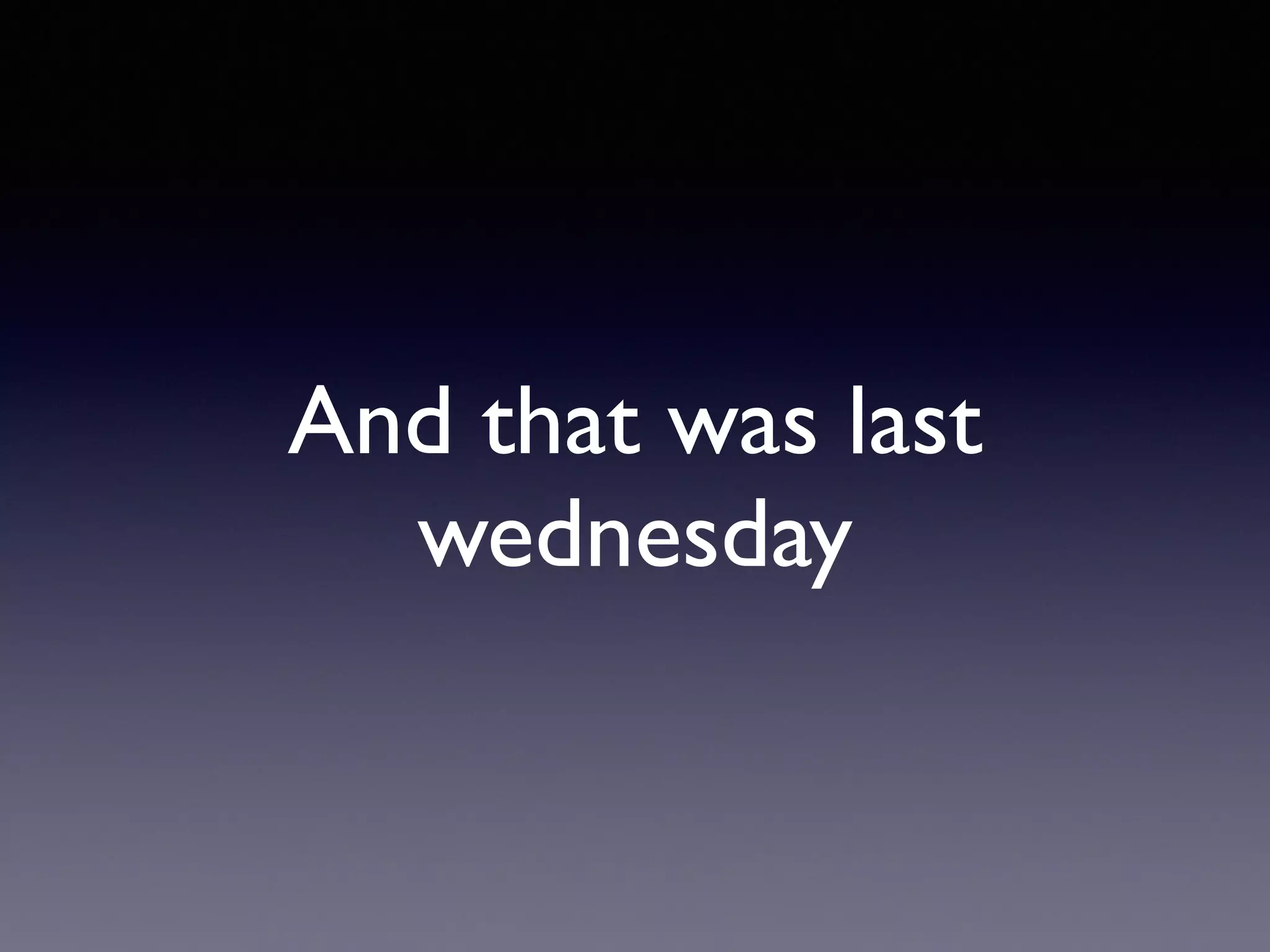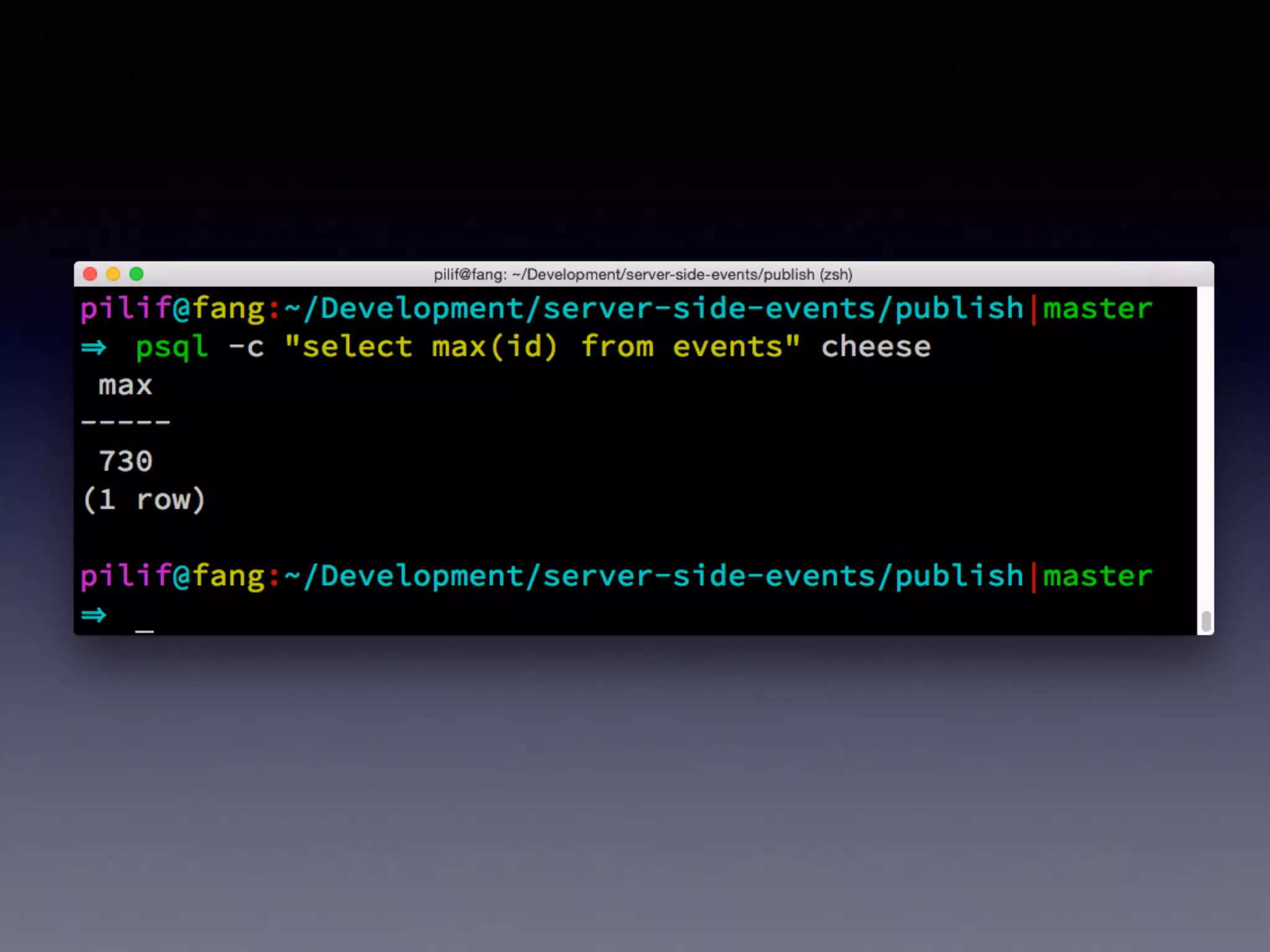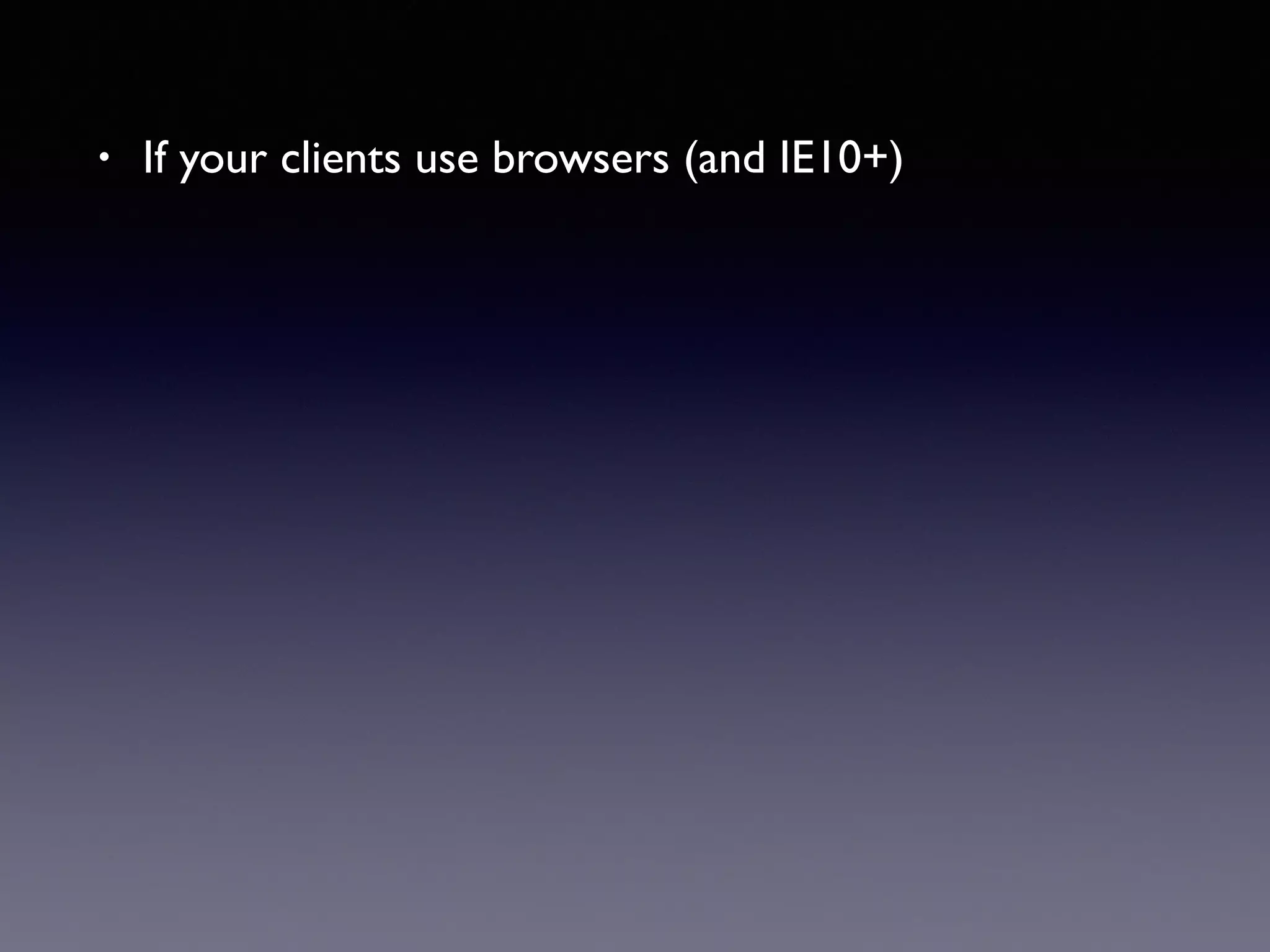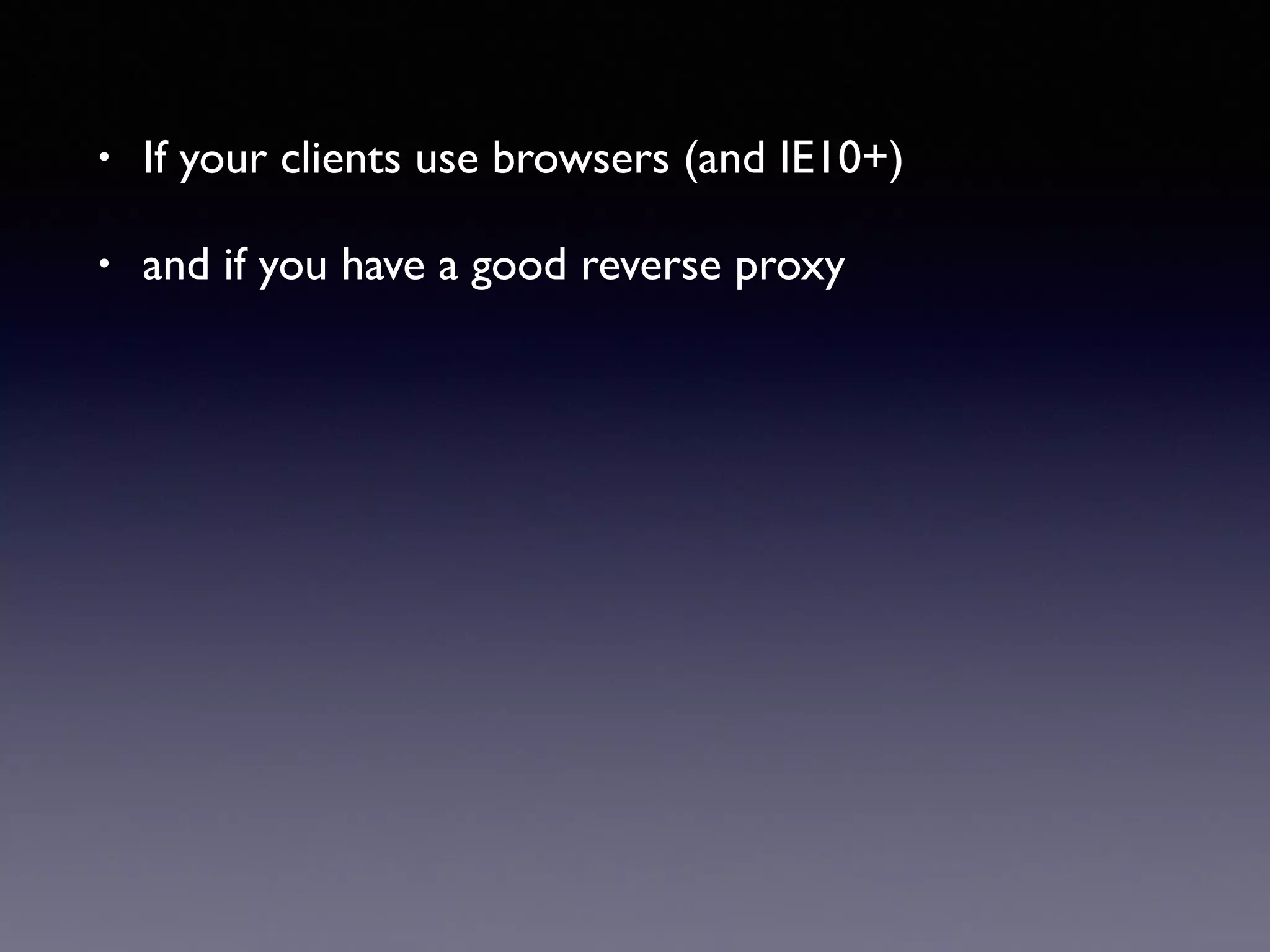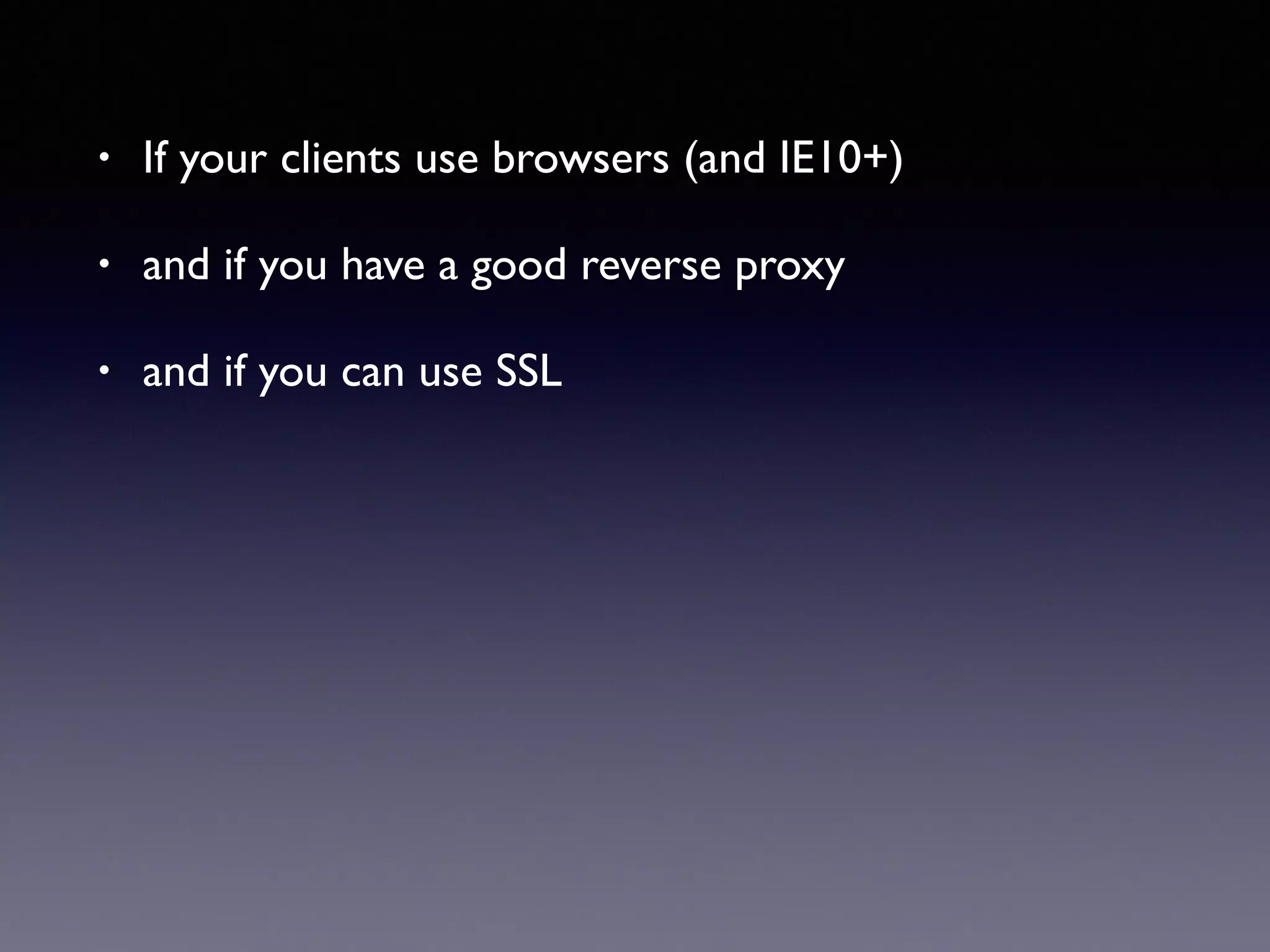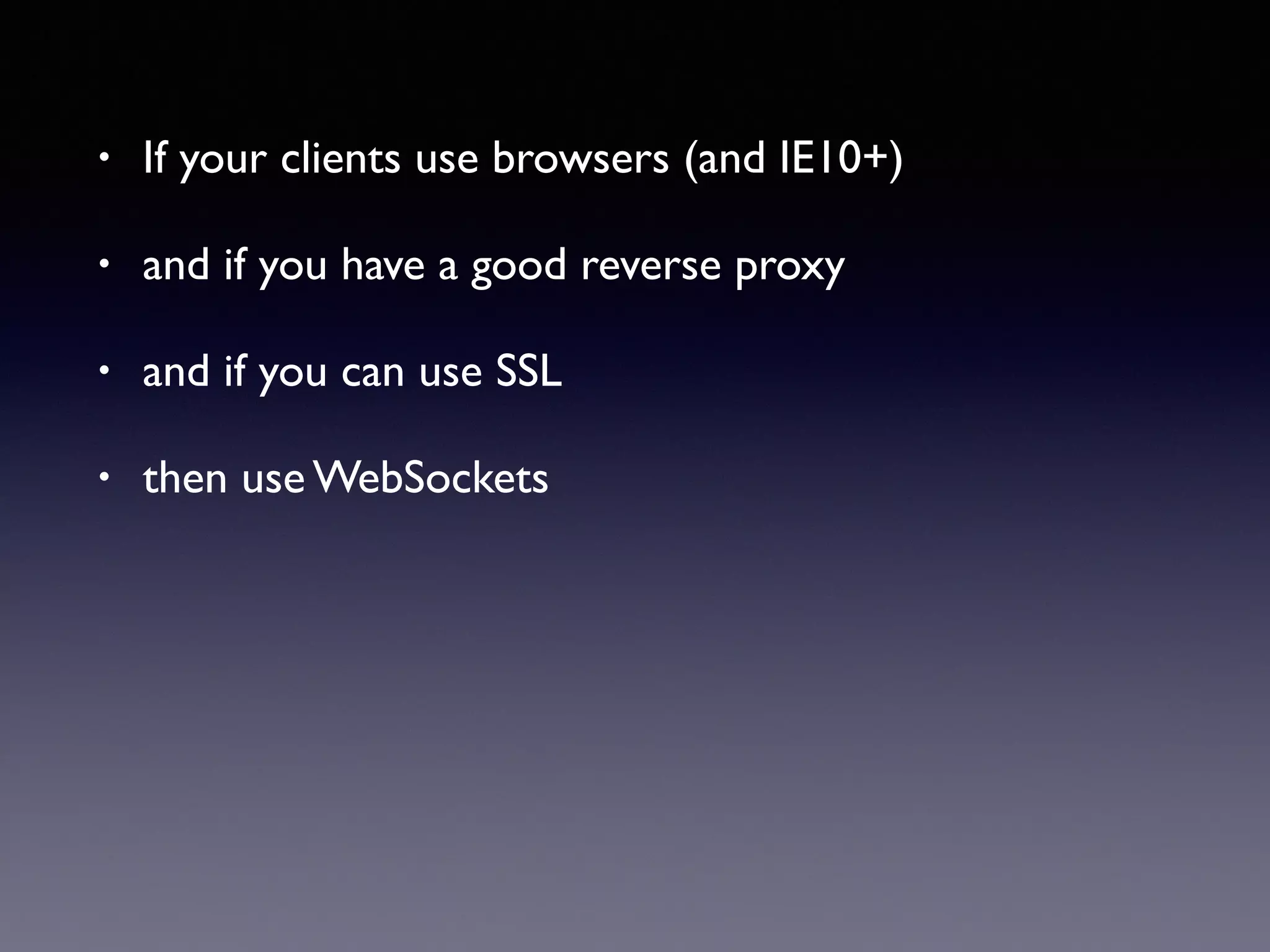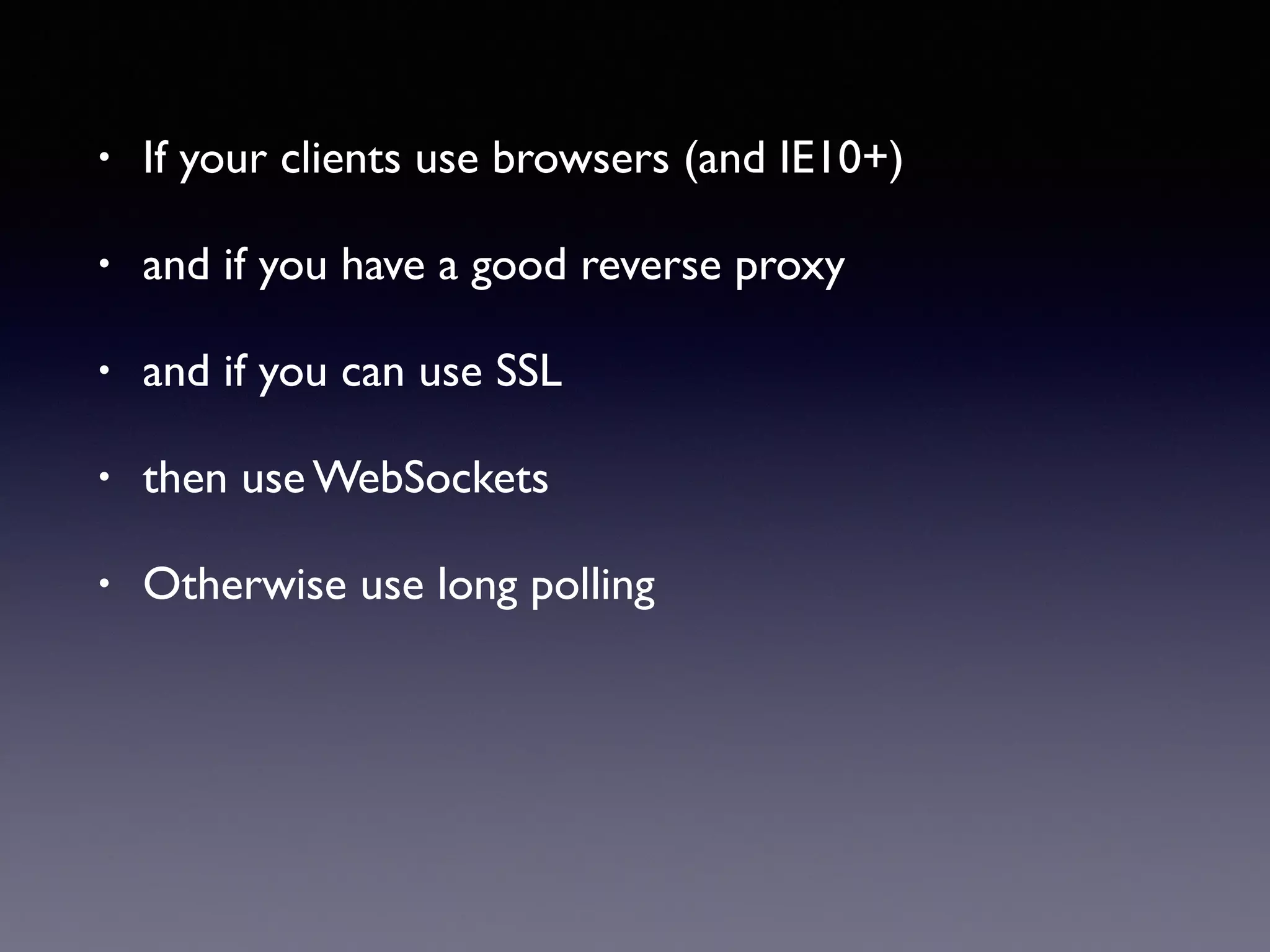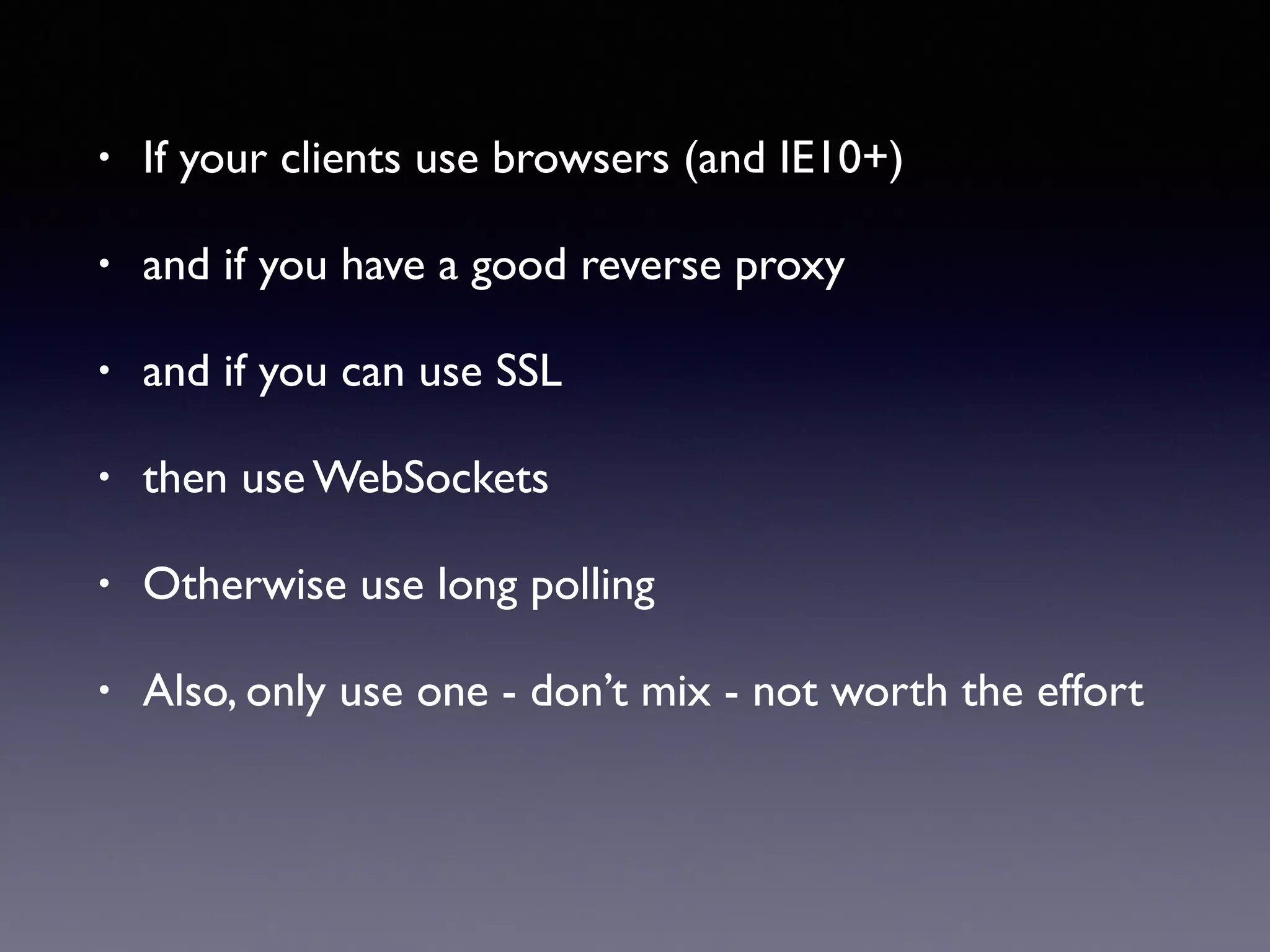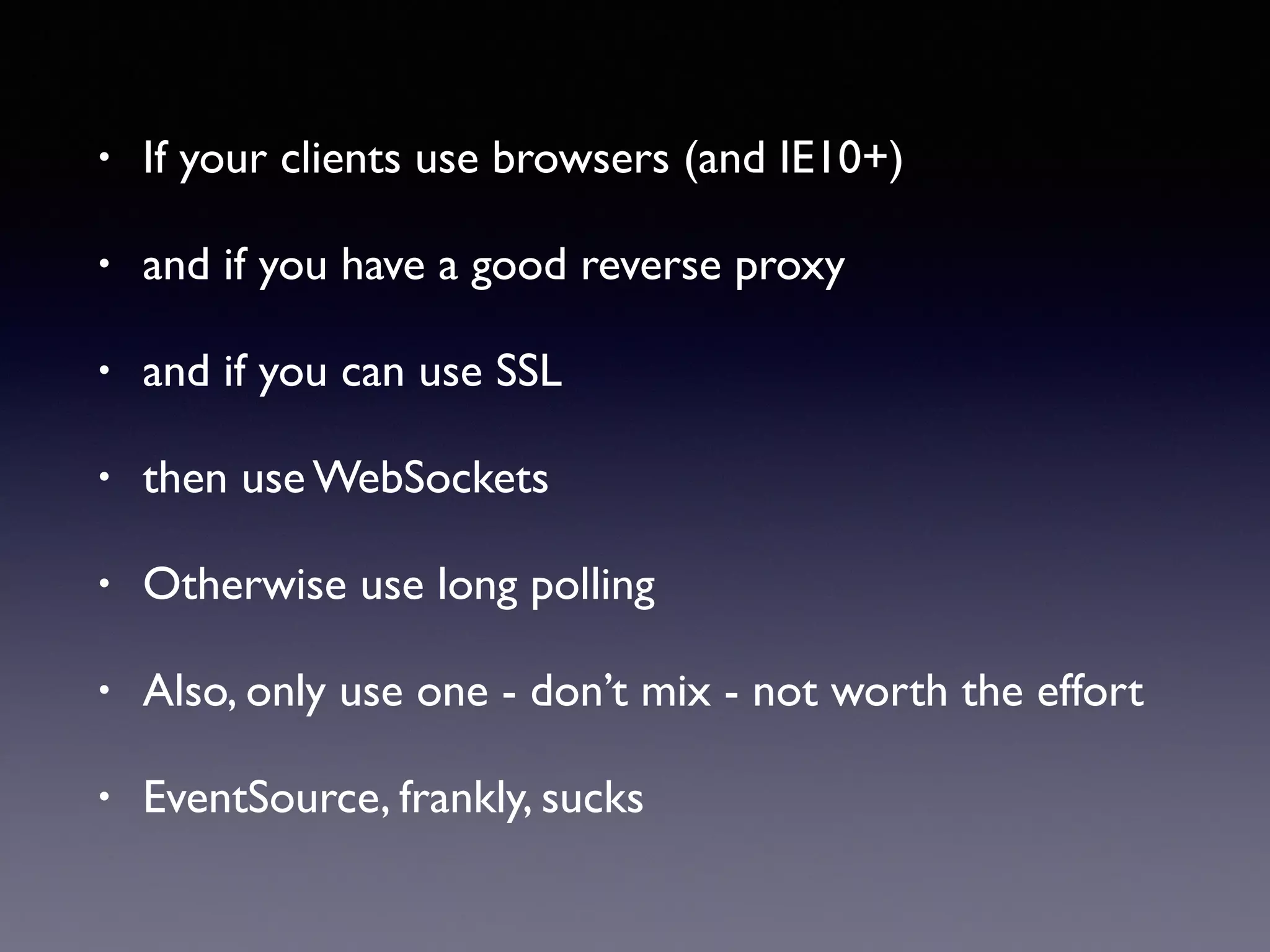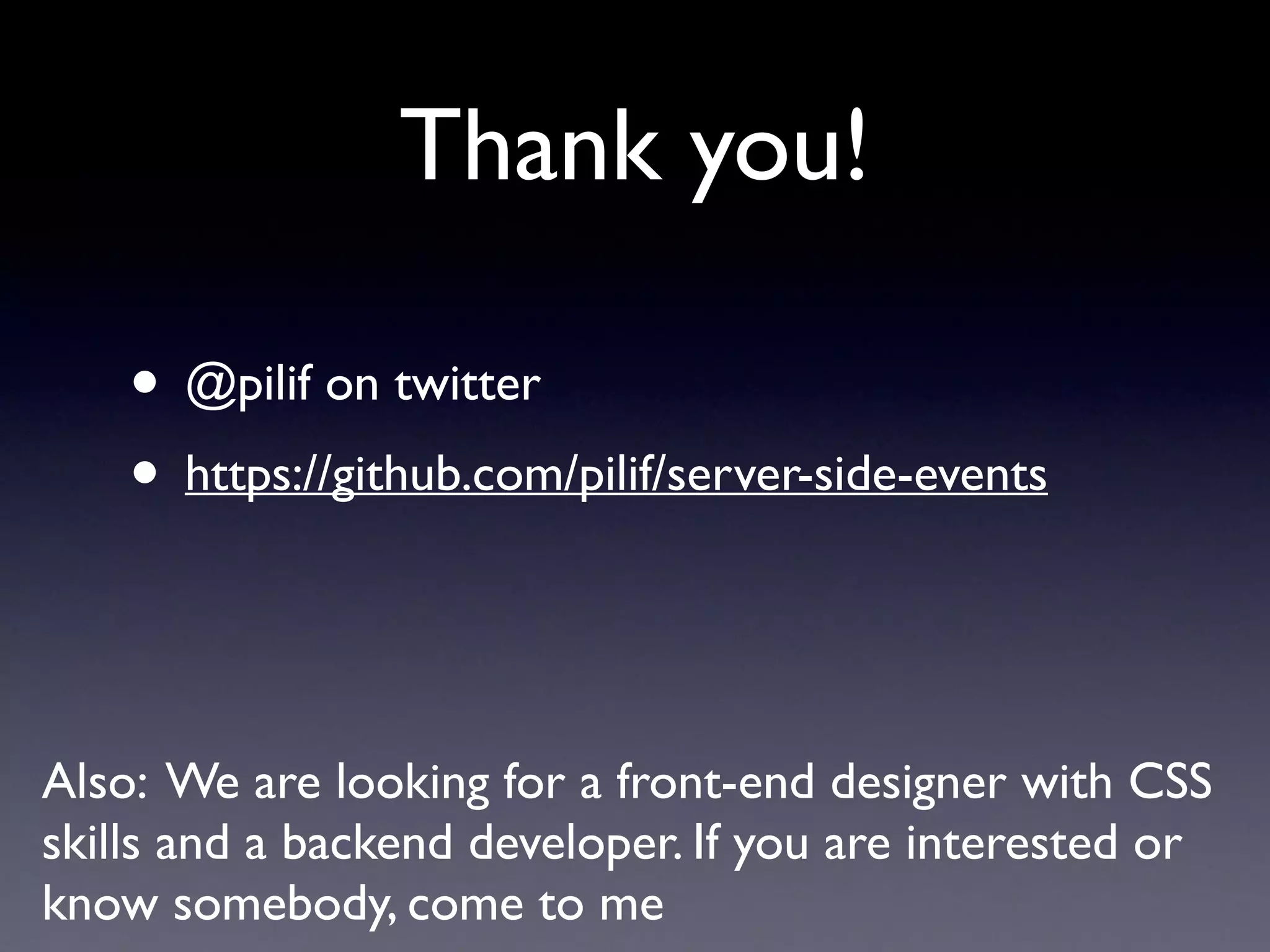The document discusses different techniques for implementing server-sent events, including short polling, long polling, Server-Sent Events, and WebSockets. Code examples are provided for implementing server-sent events using WebSockets, Server-Sent Events, and long polling with Redis pub/sub. Fallback techniques are also described to handle events if the main infrastructure is not available.
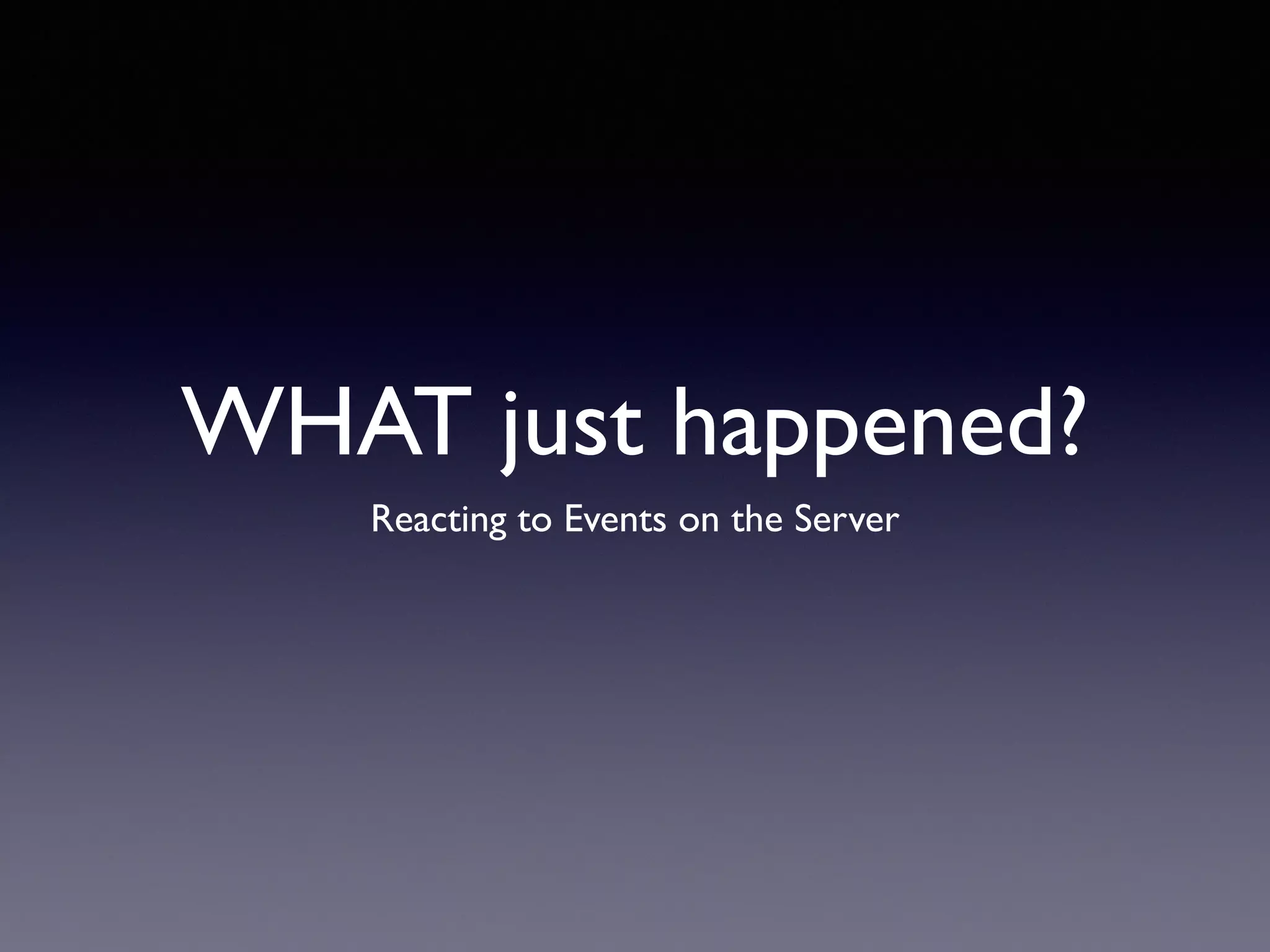
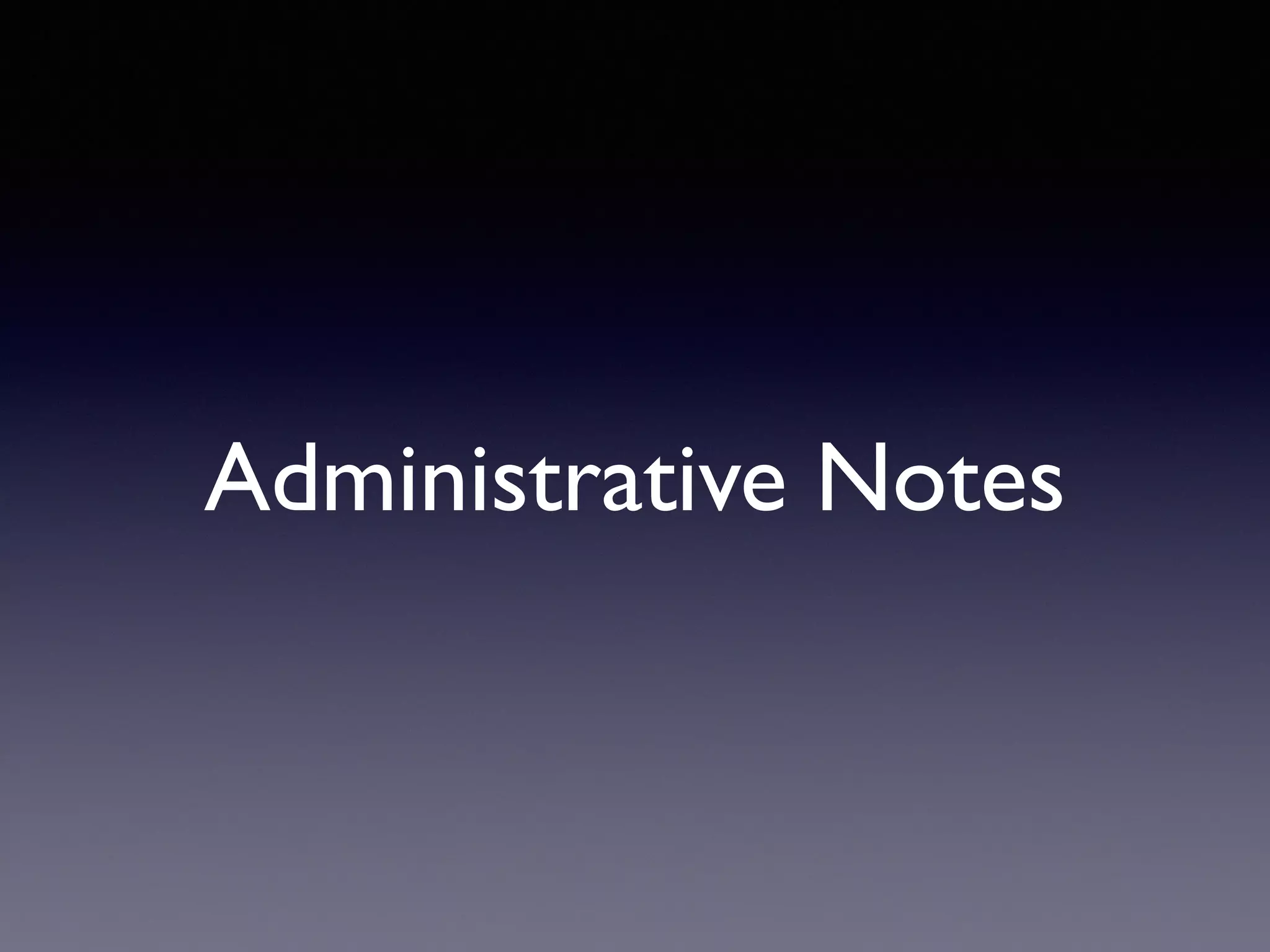
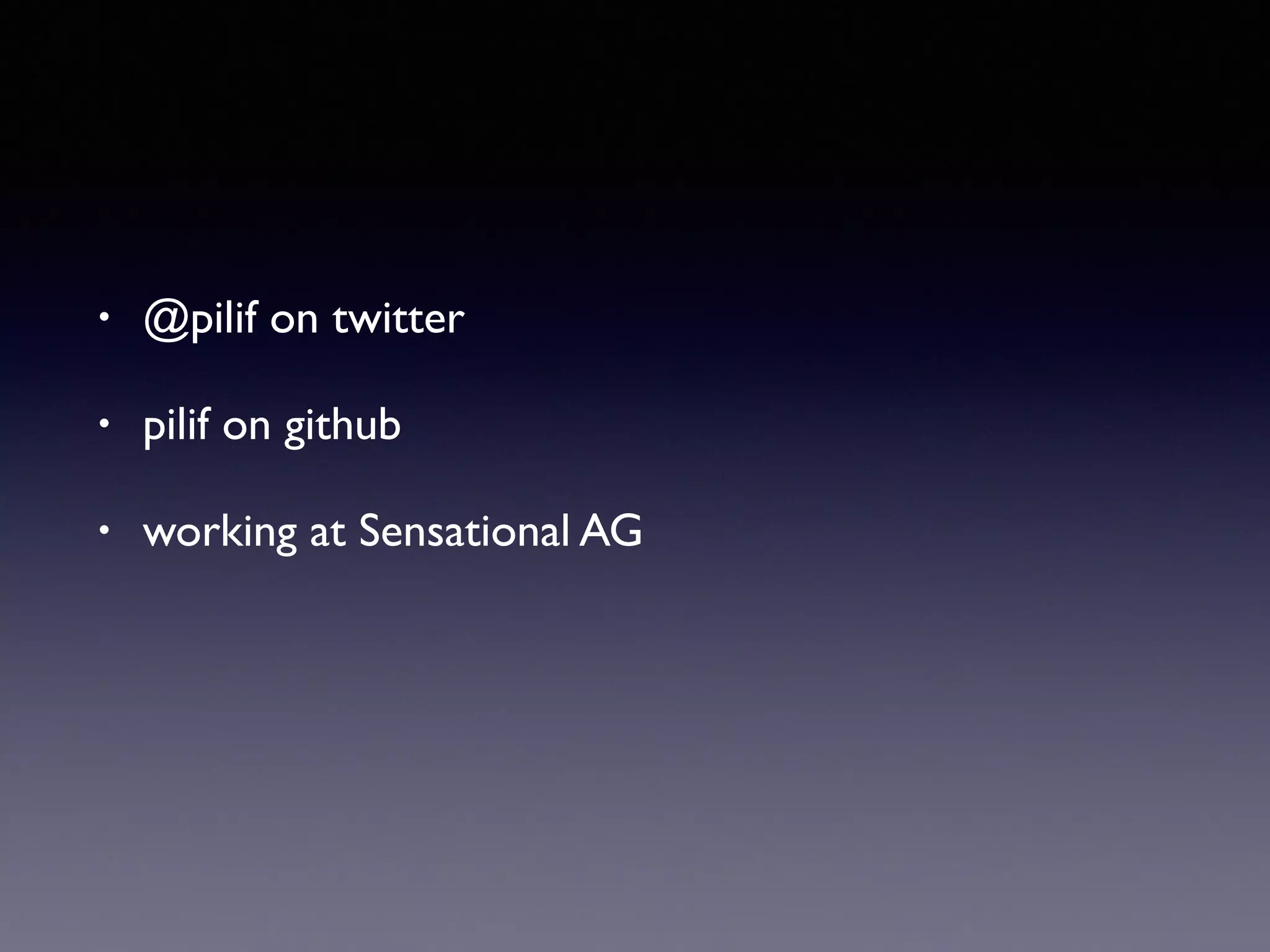
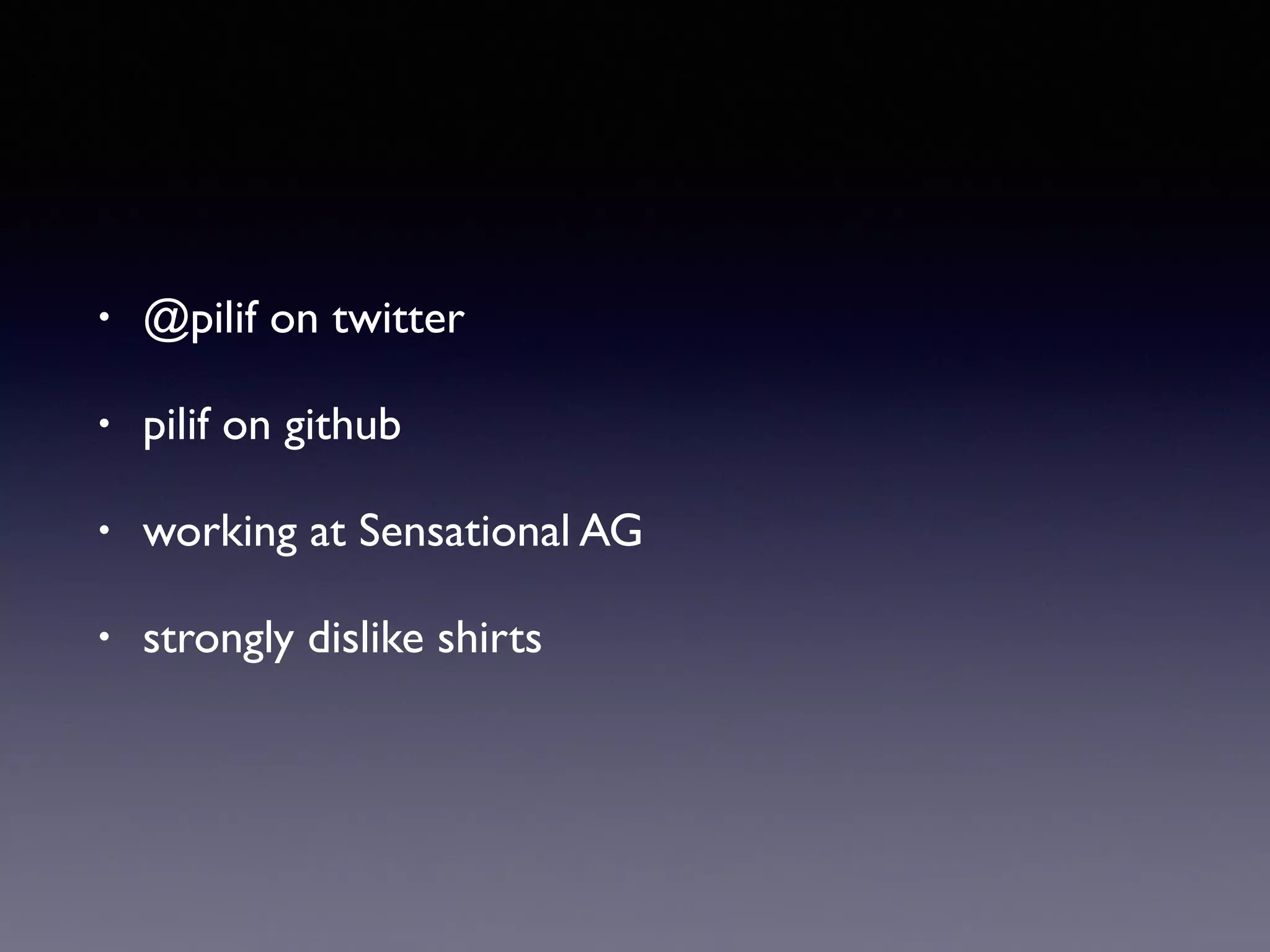
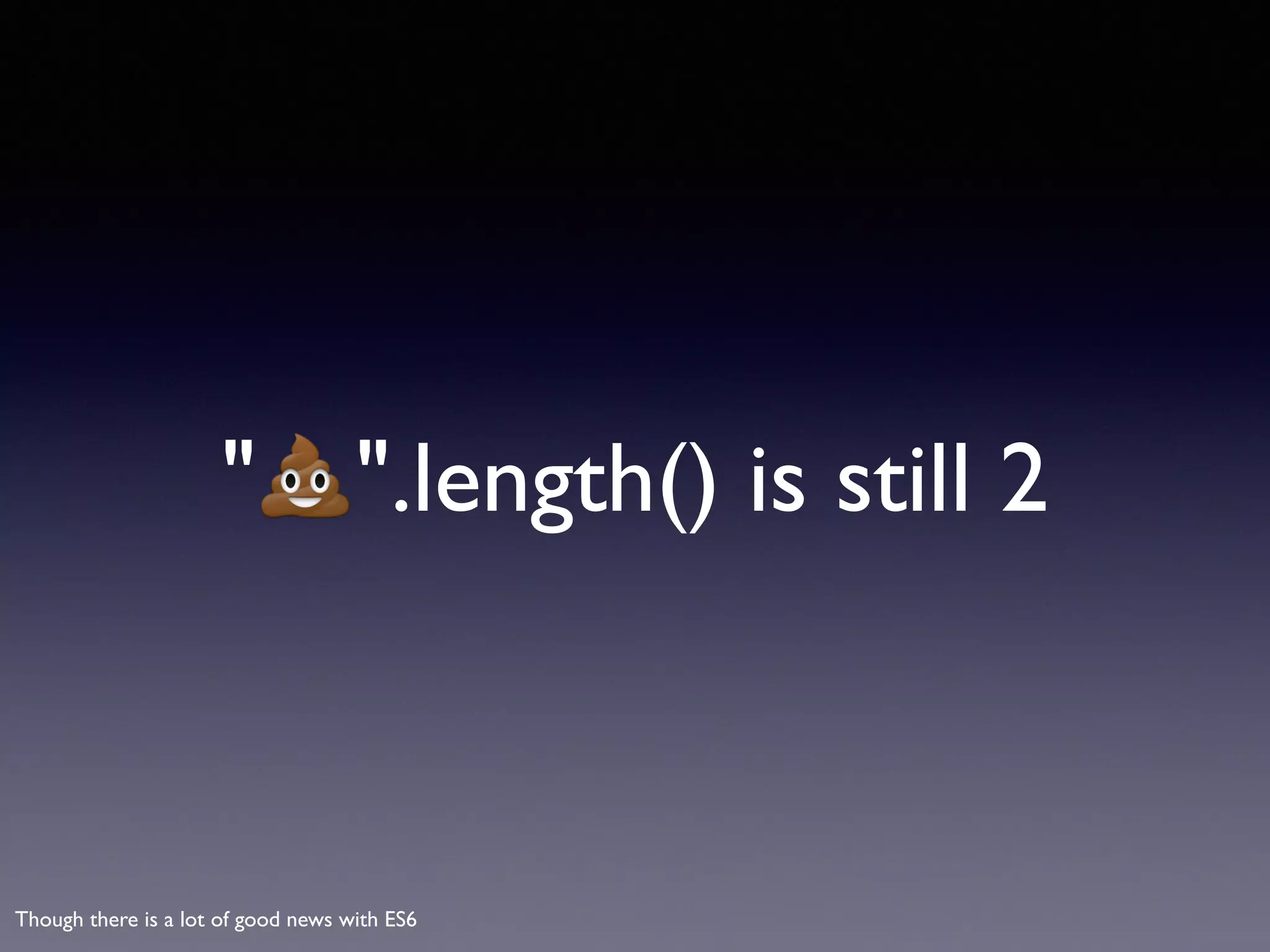
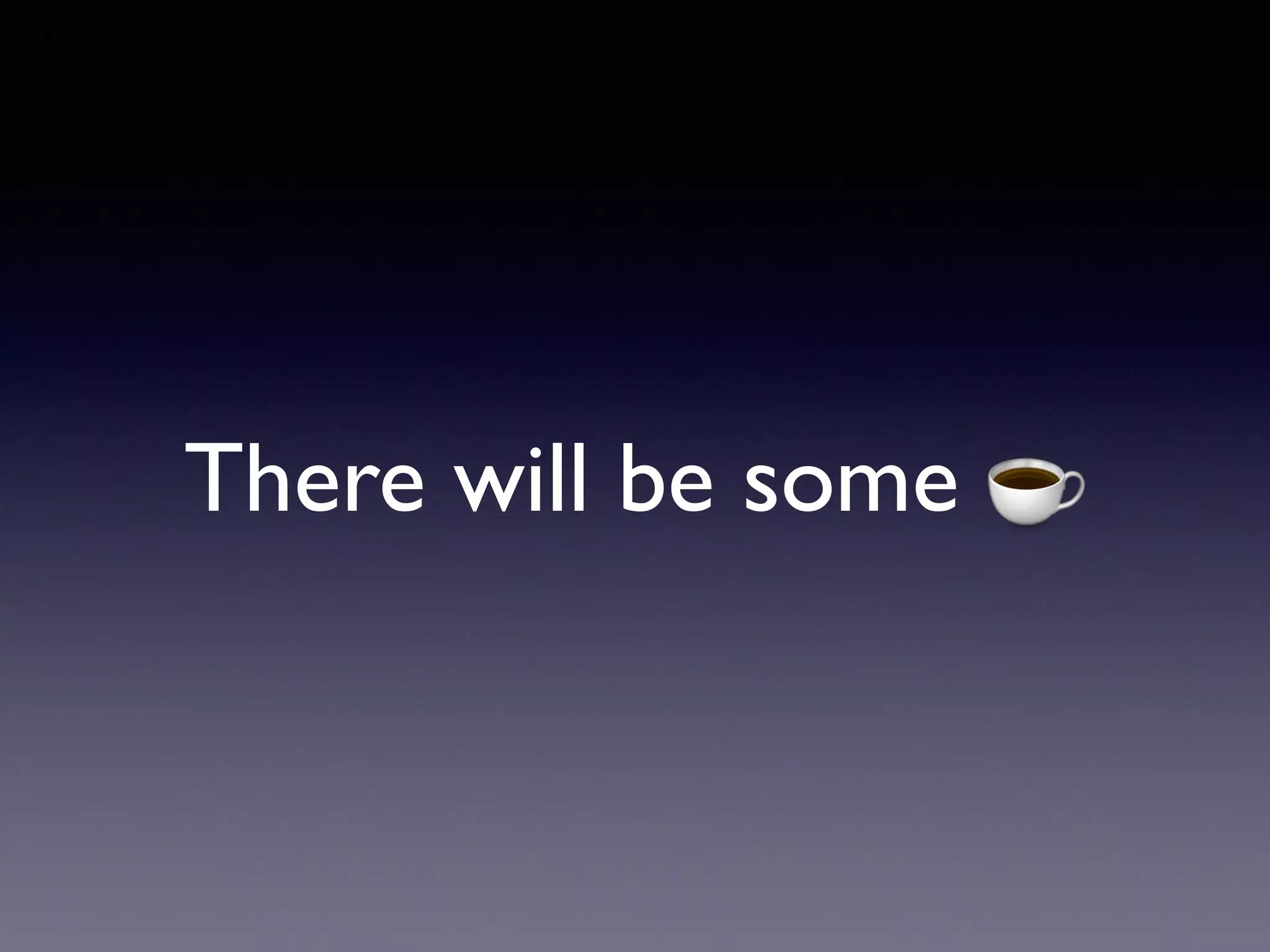
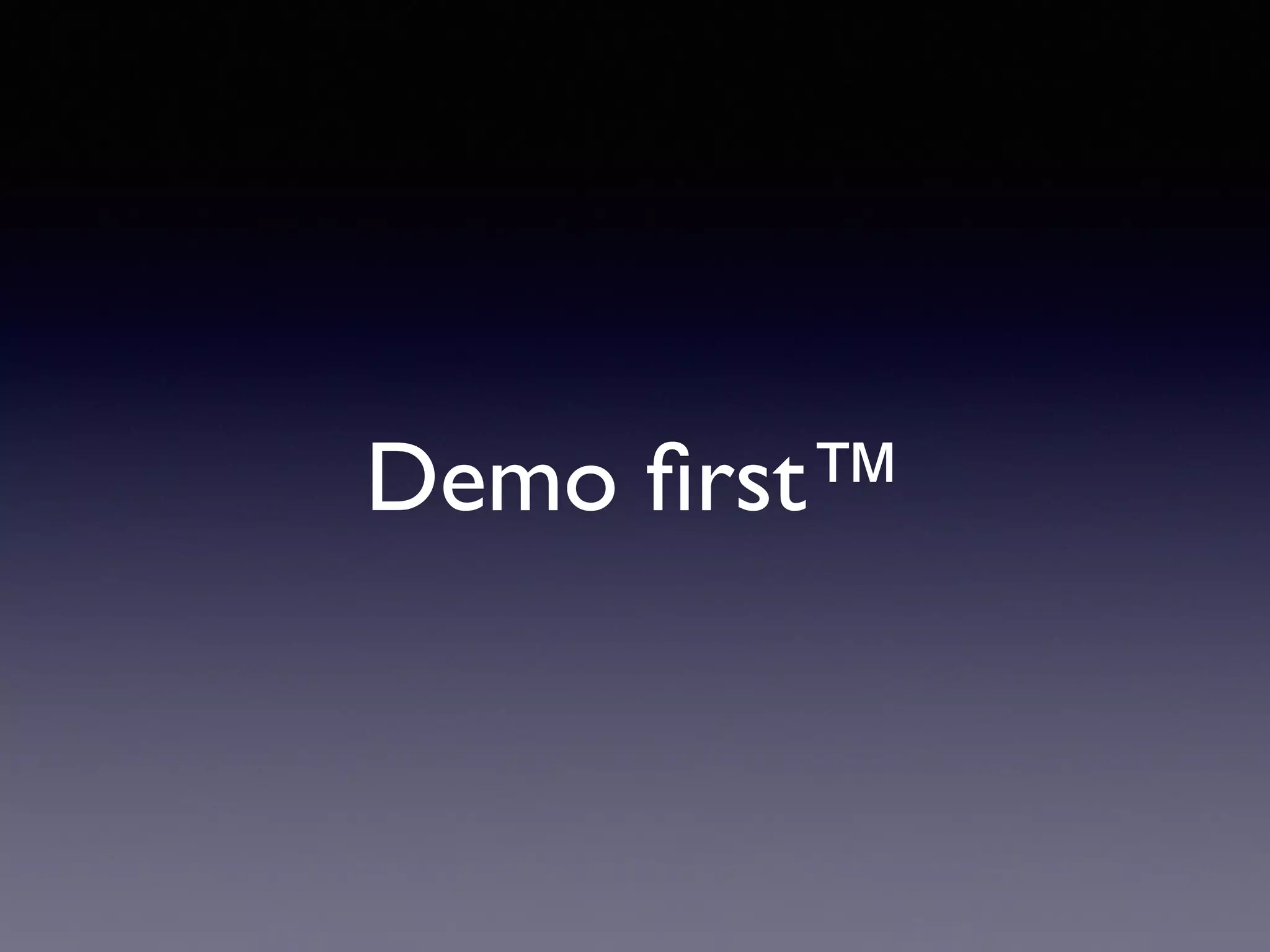
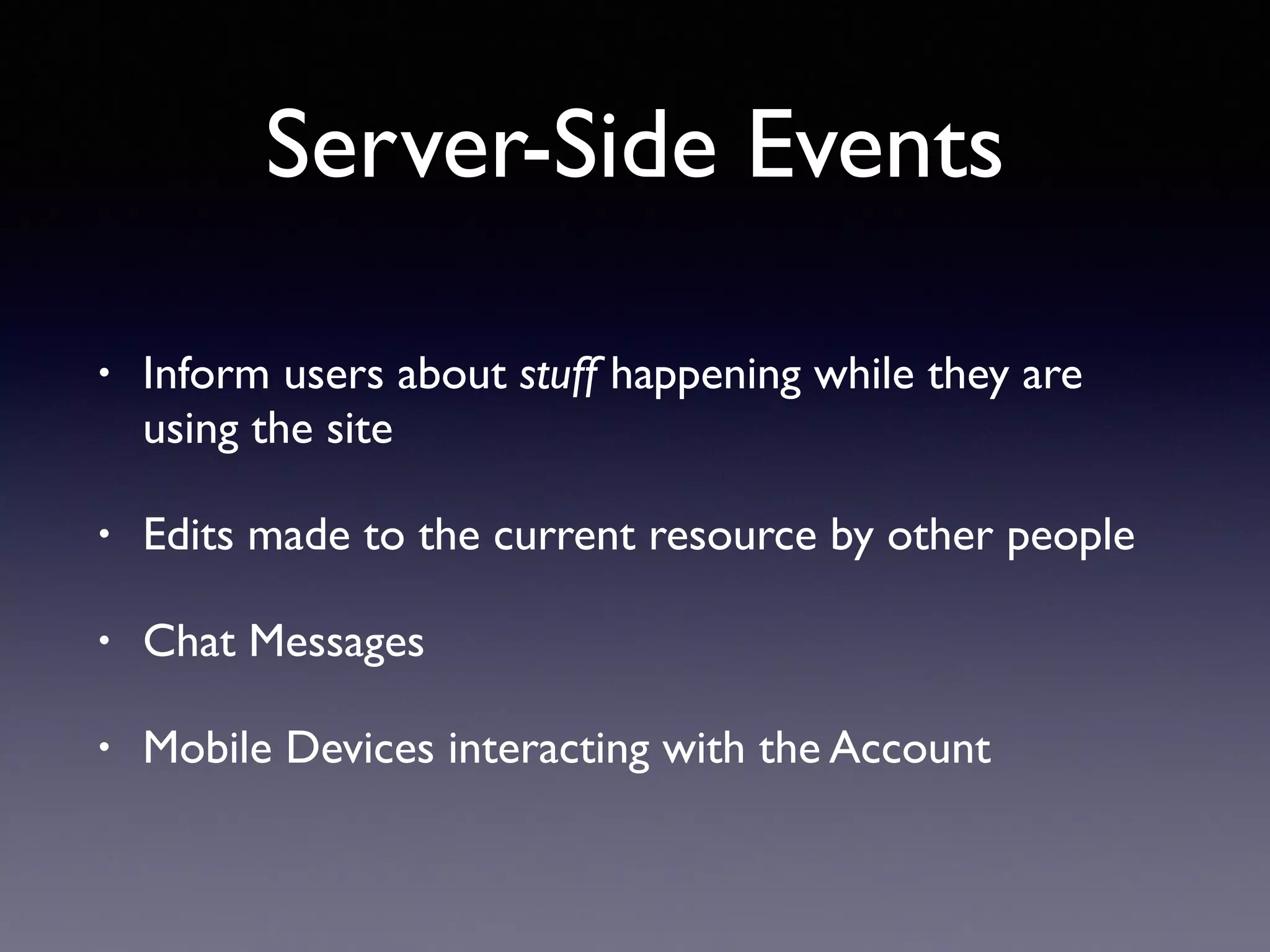
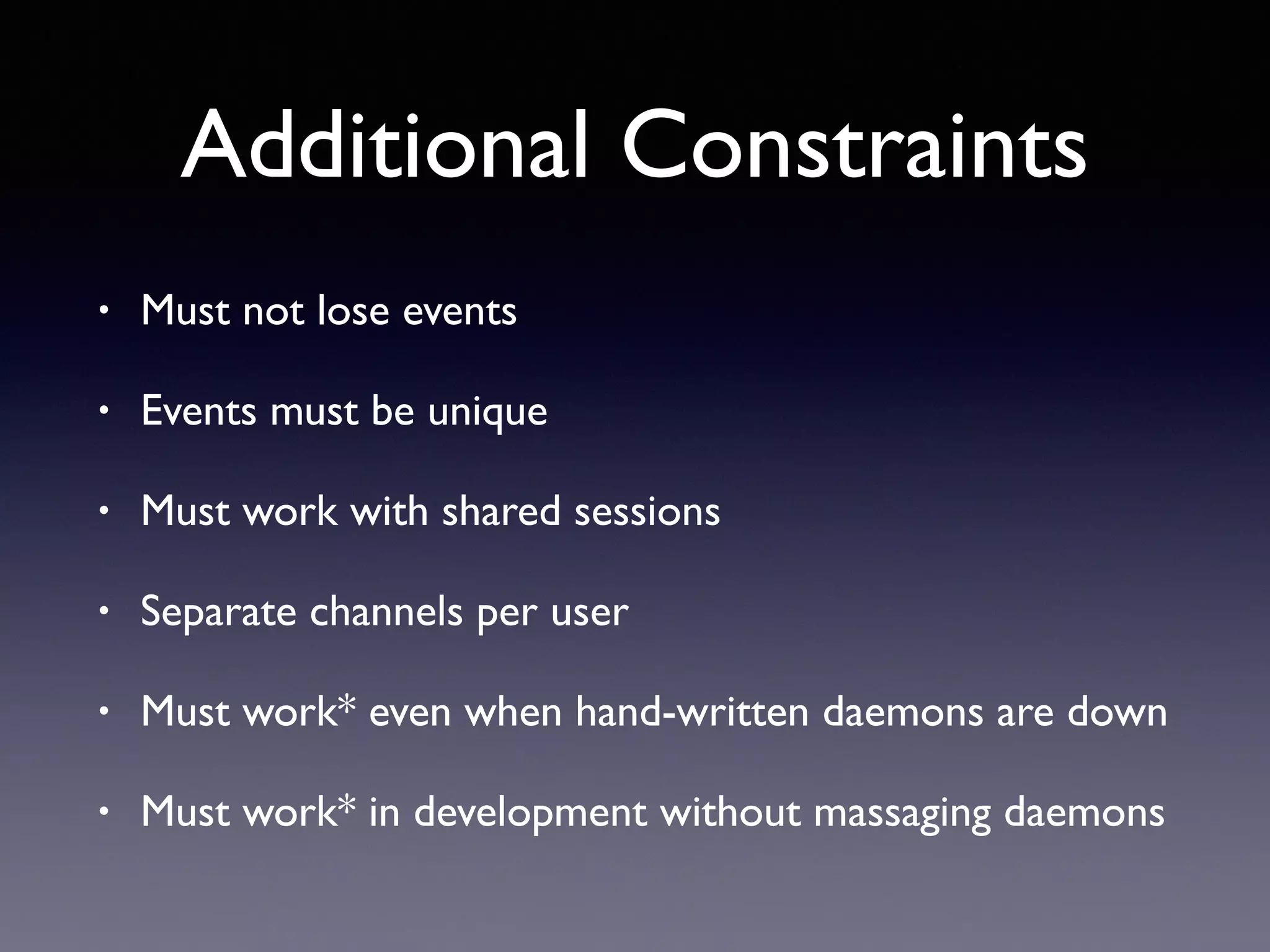
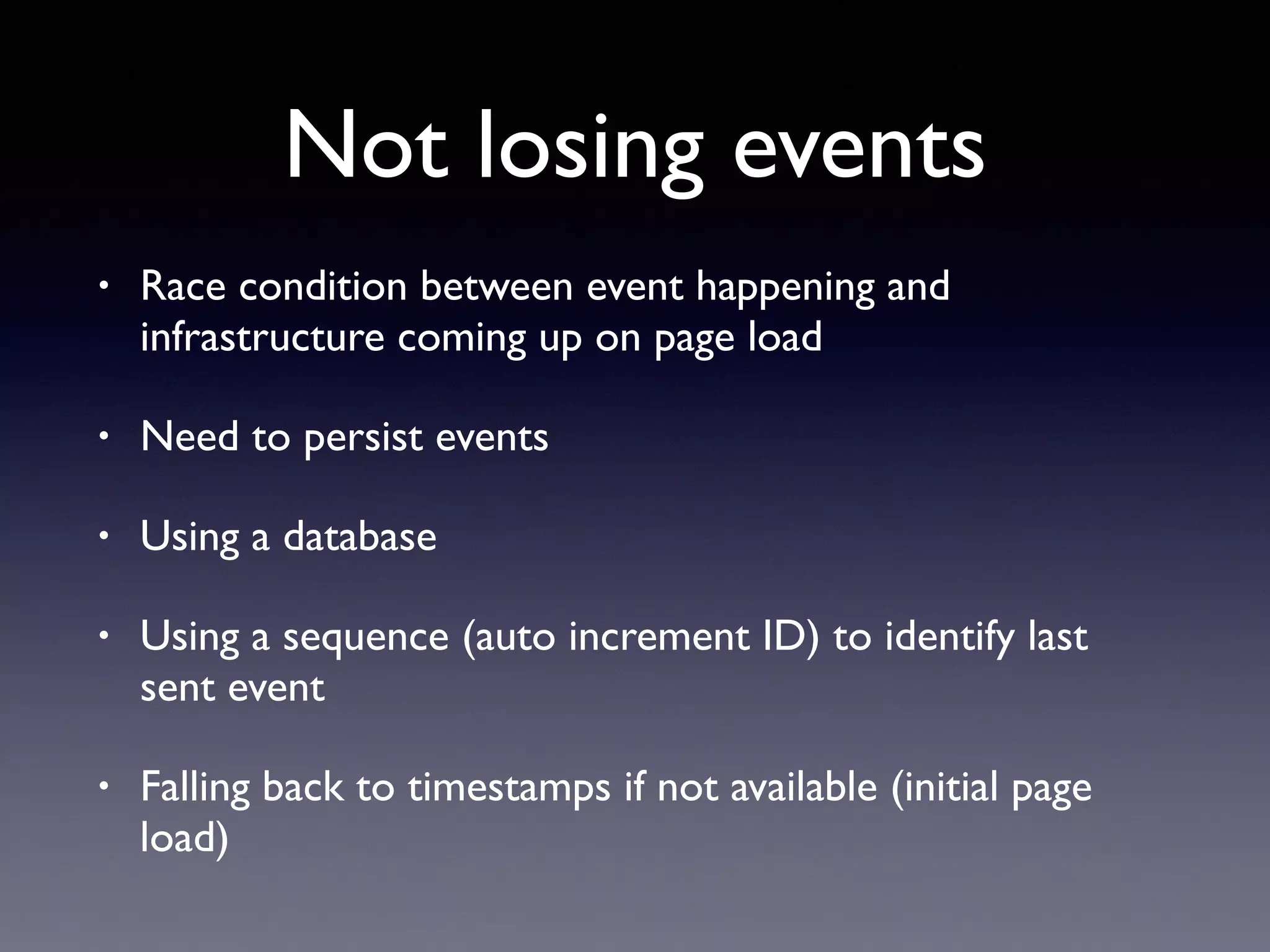
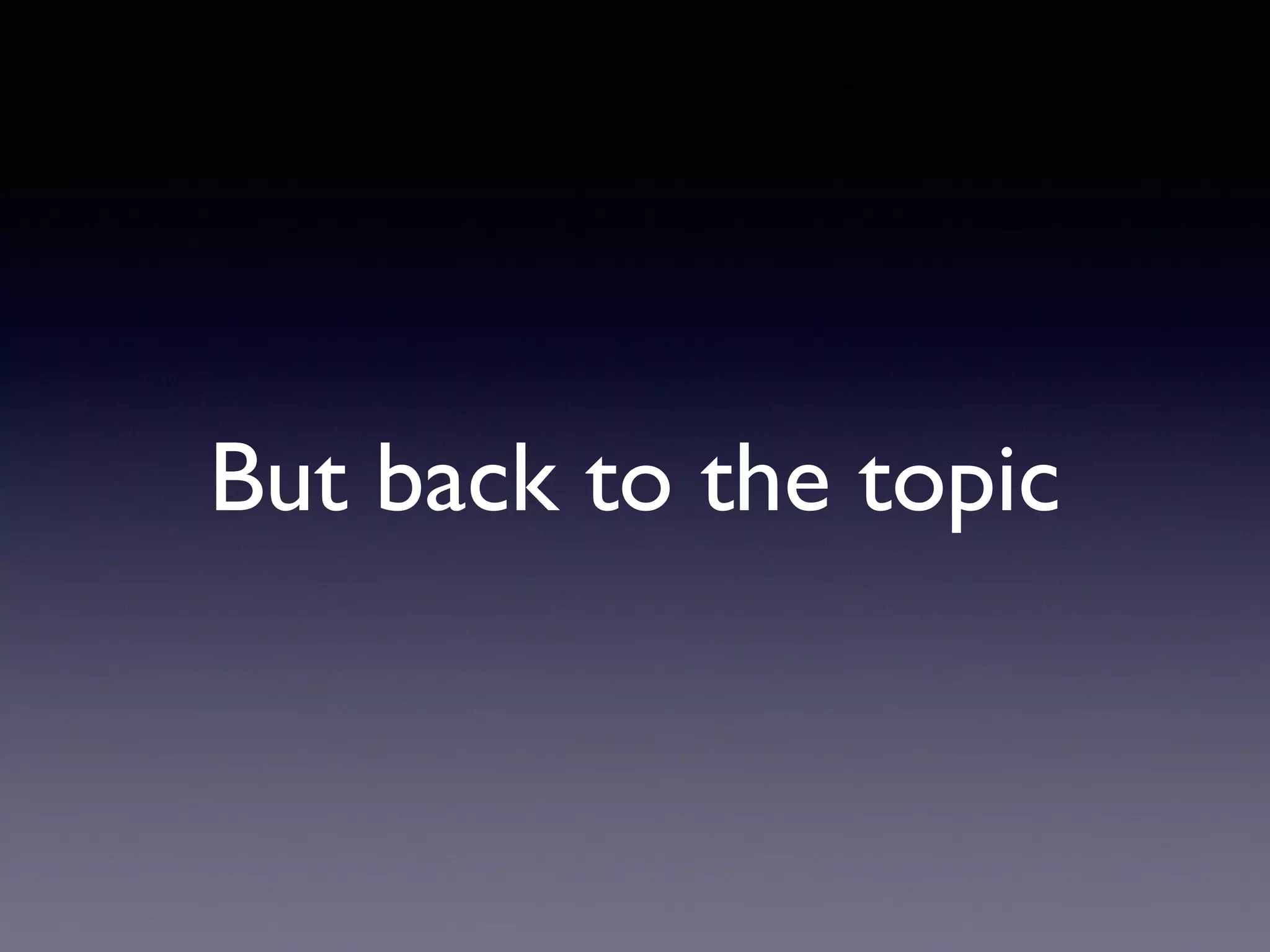
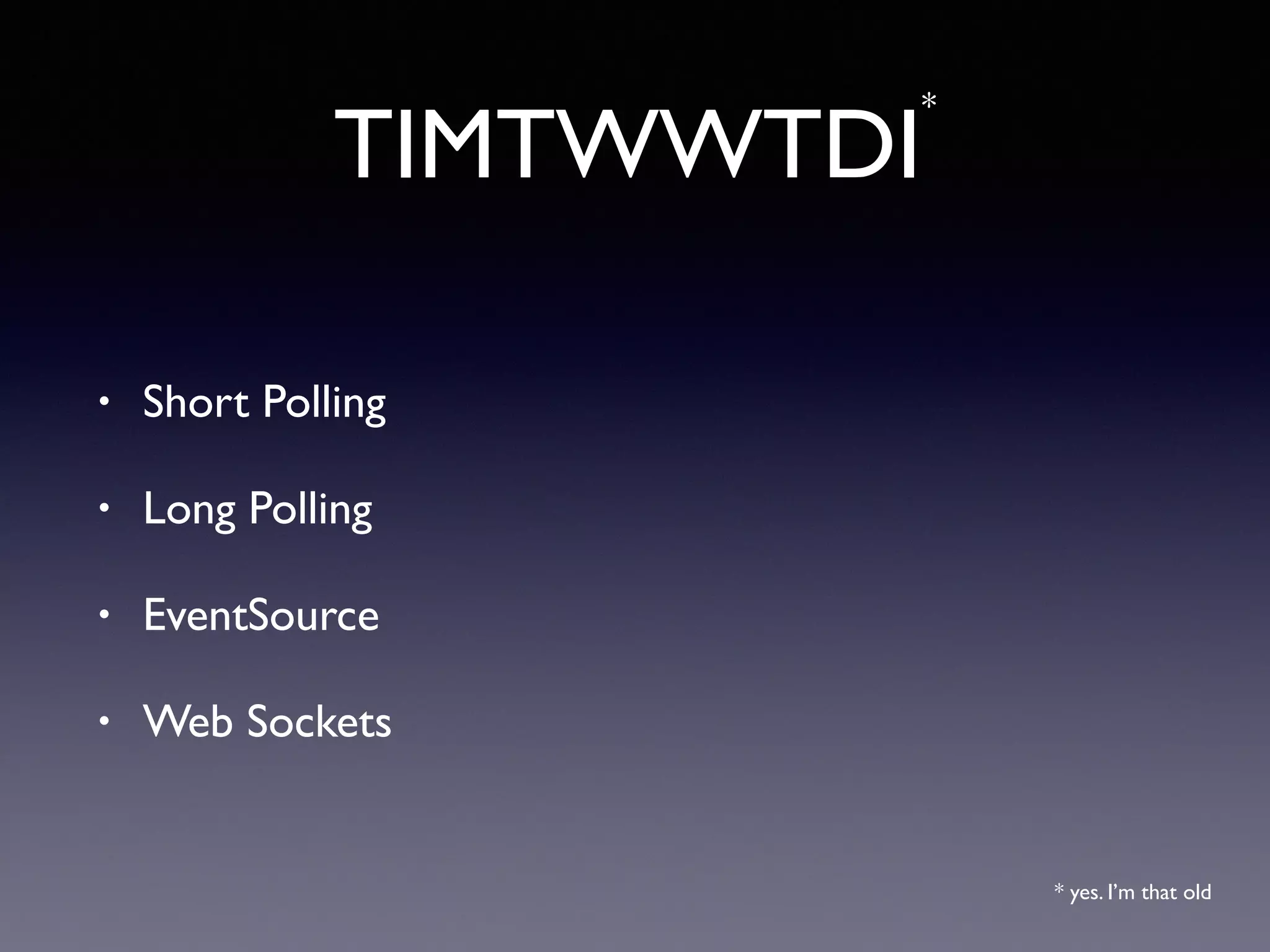
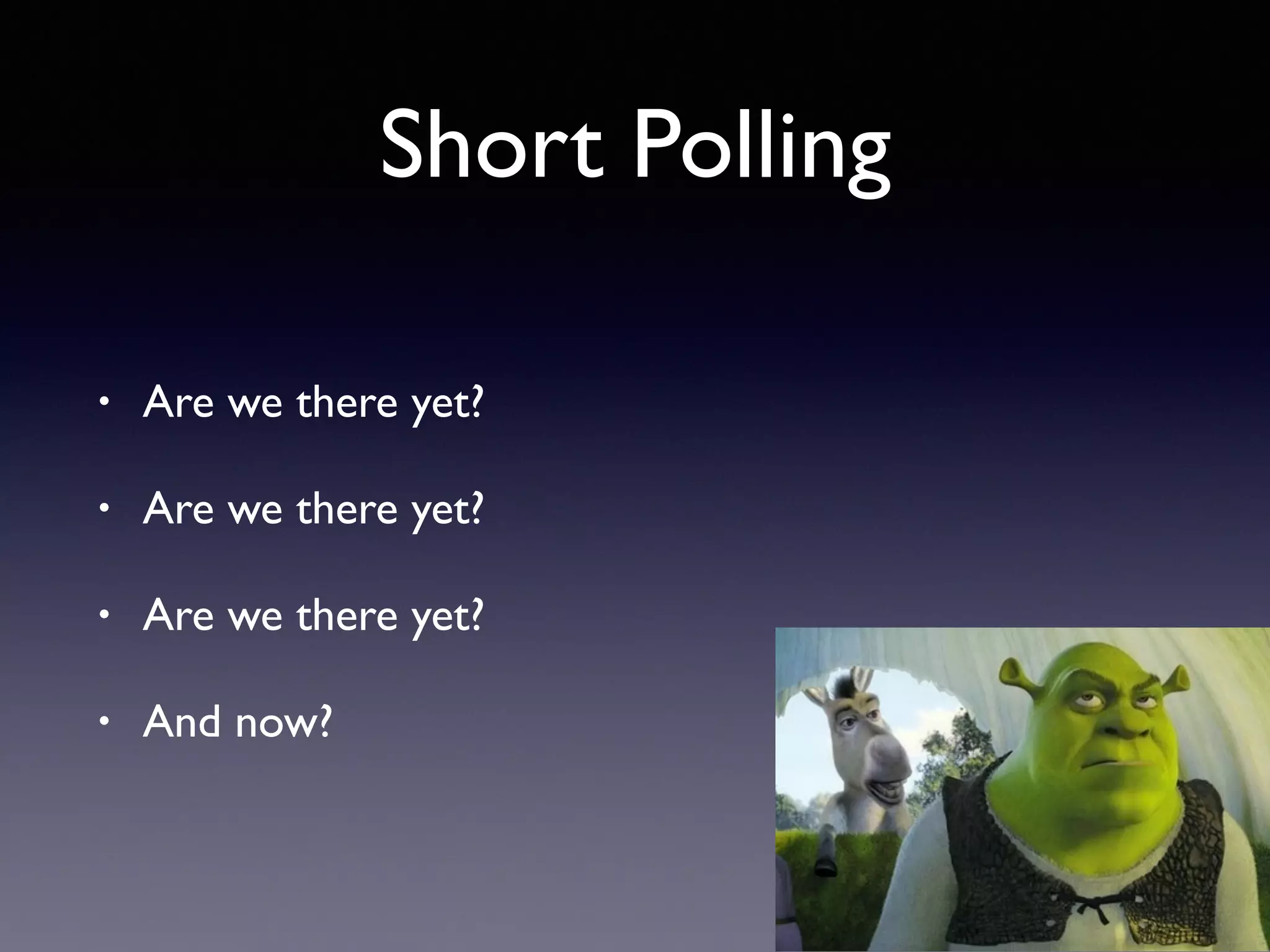
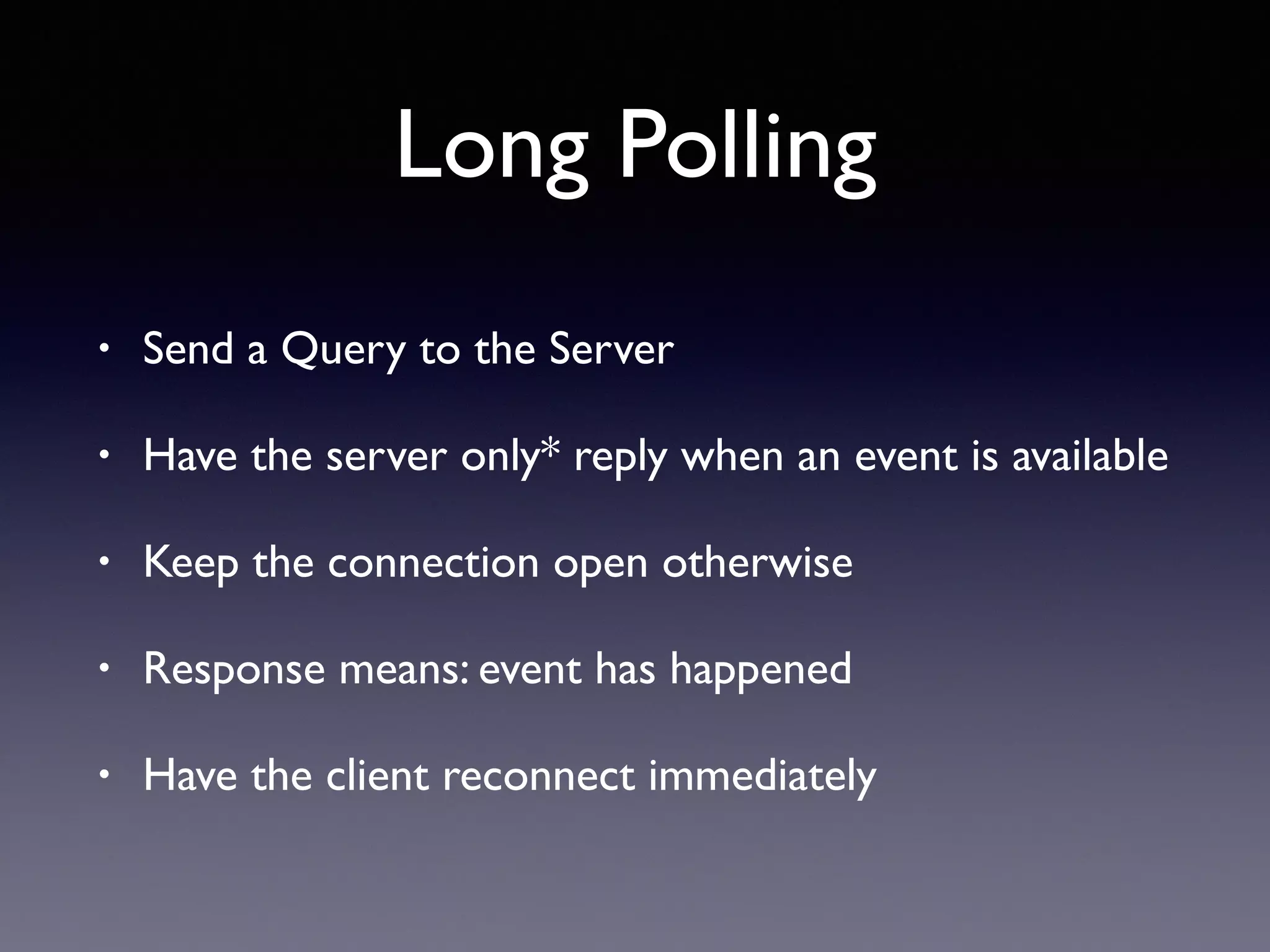
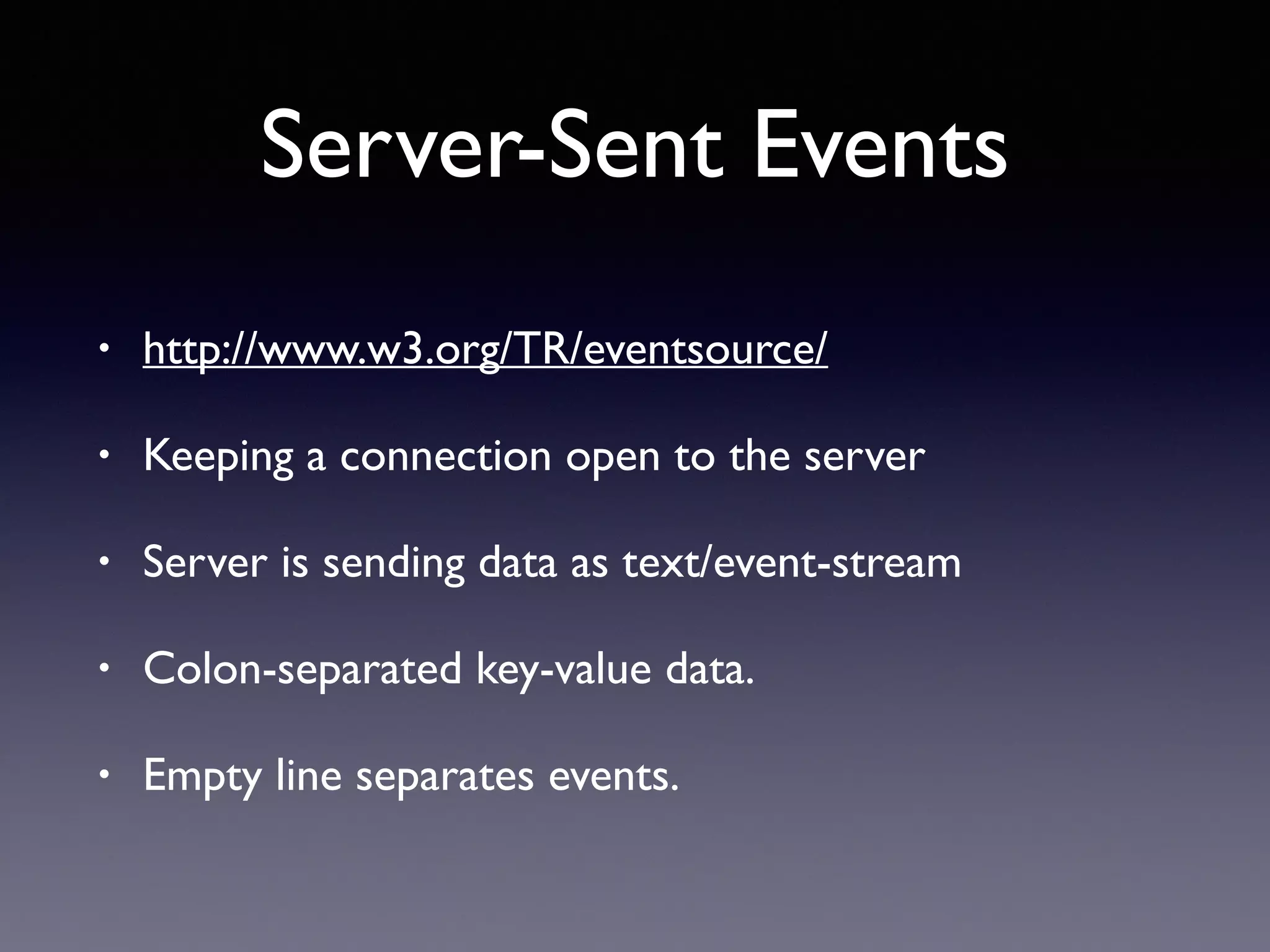
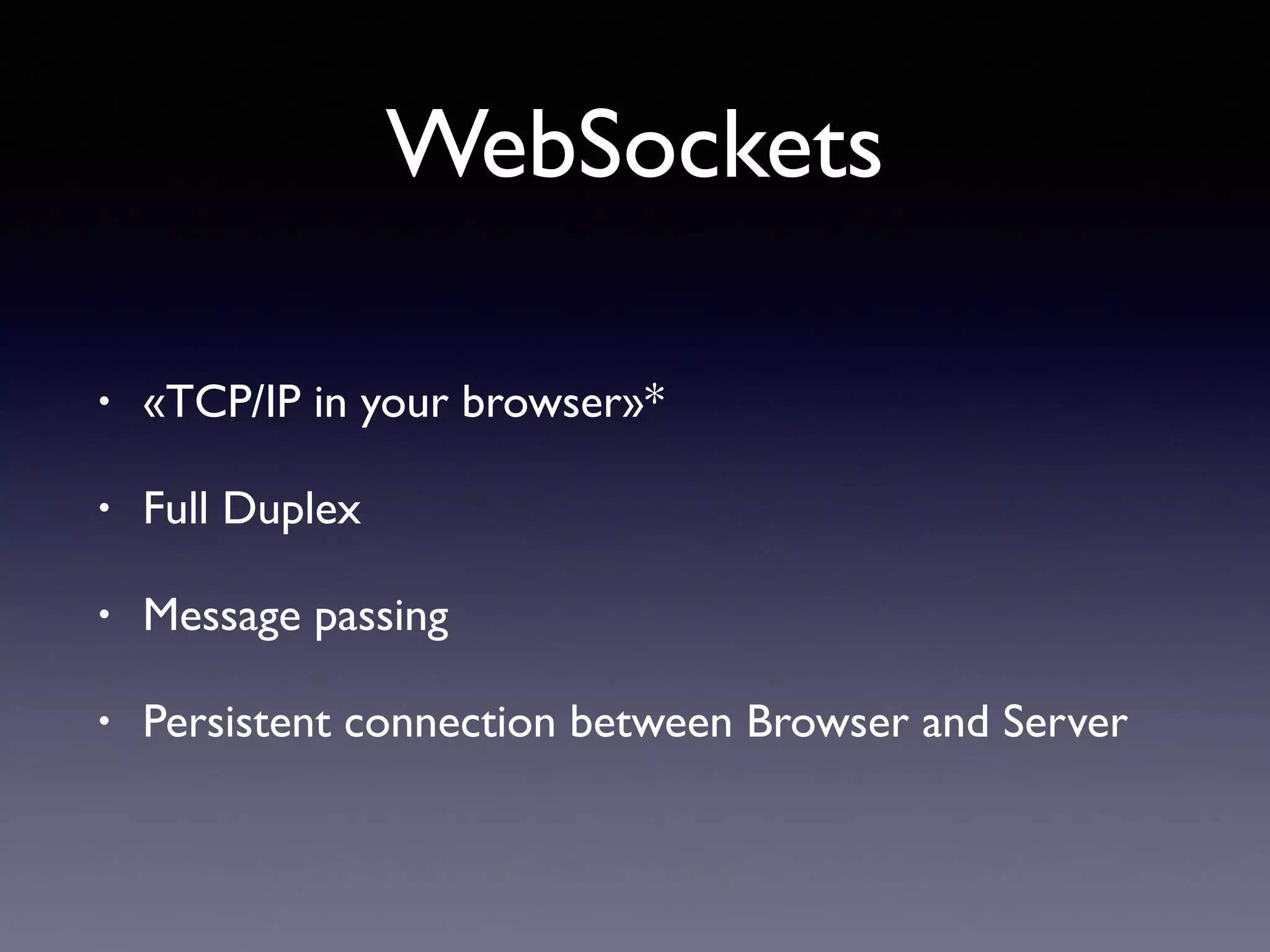
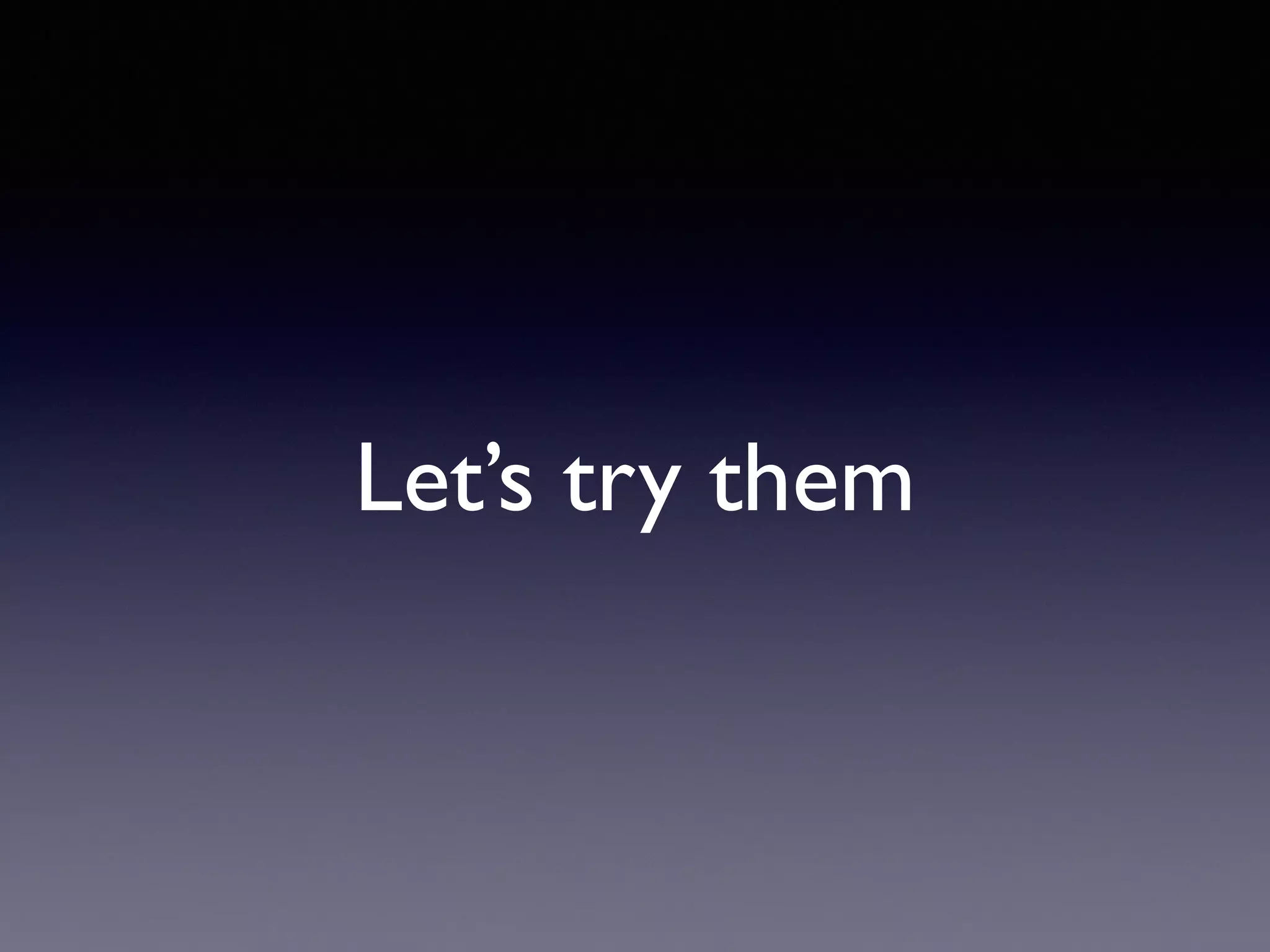

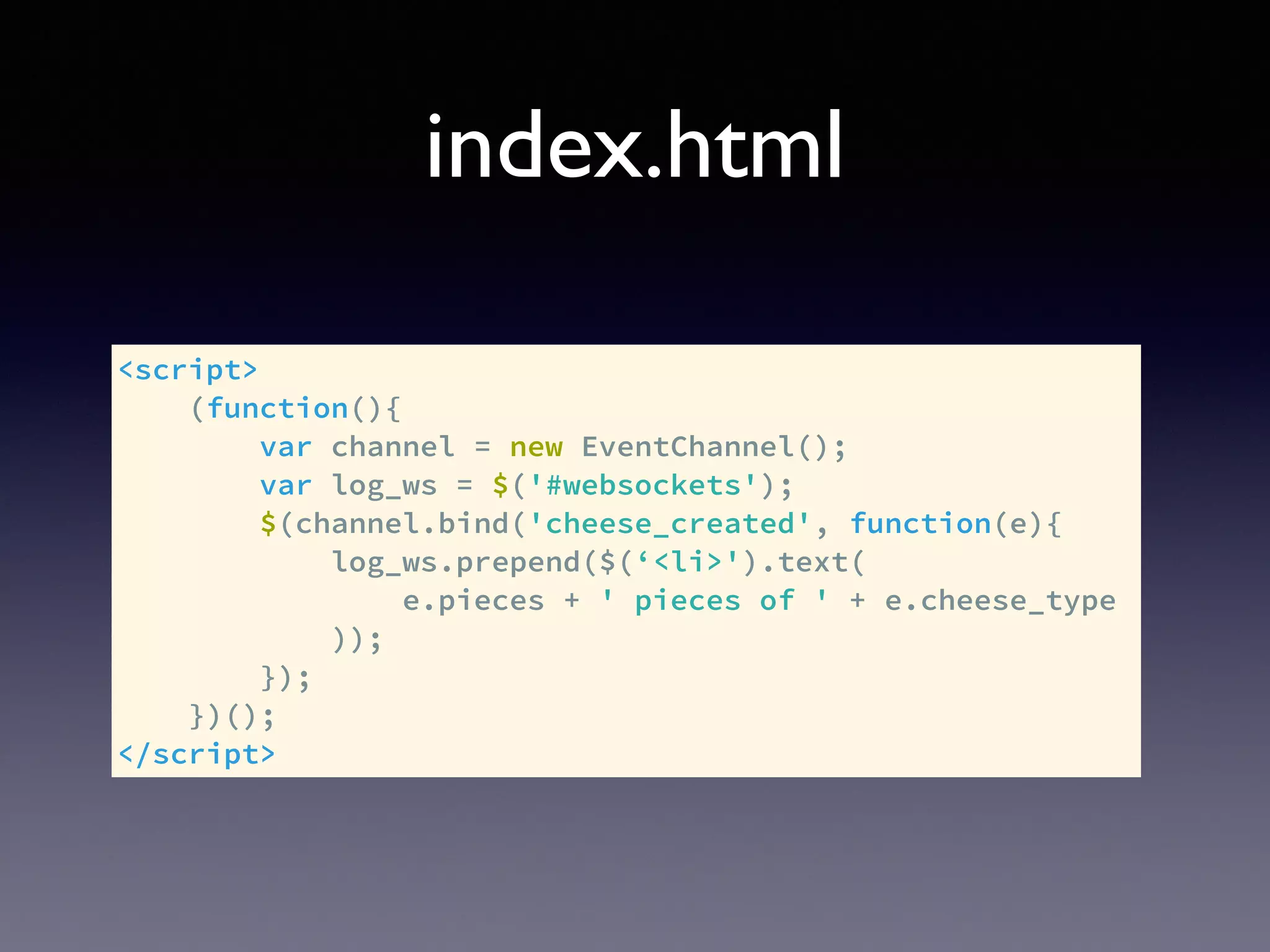
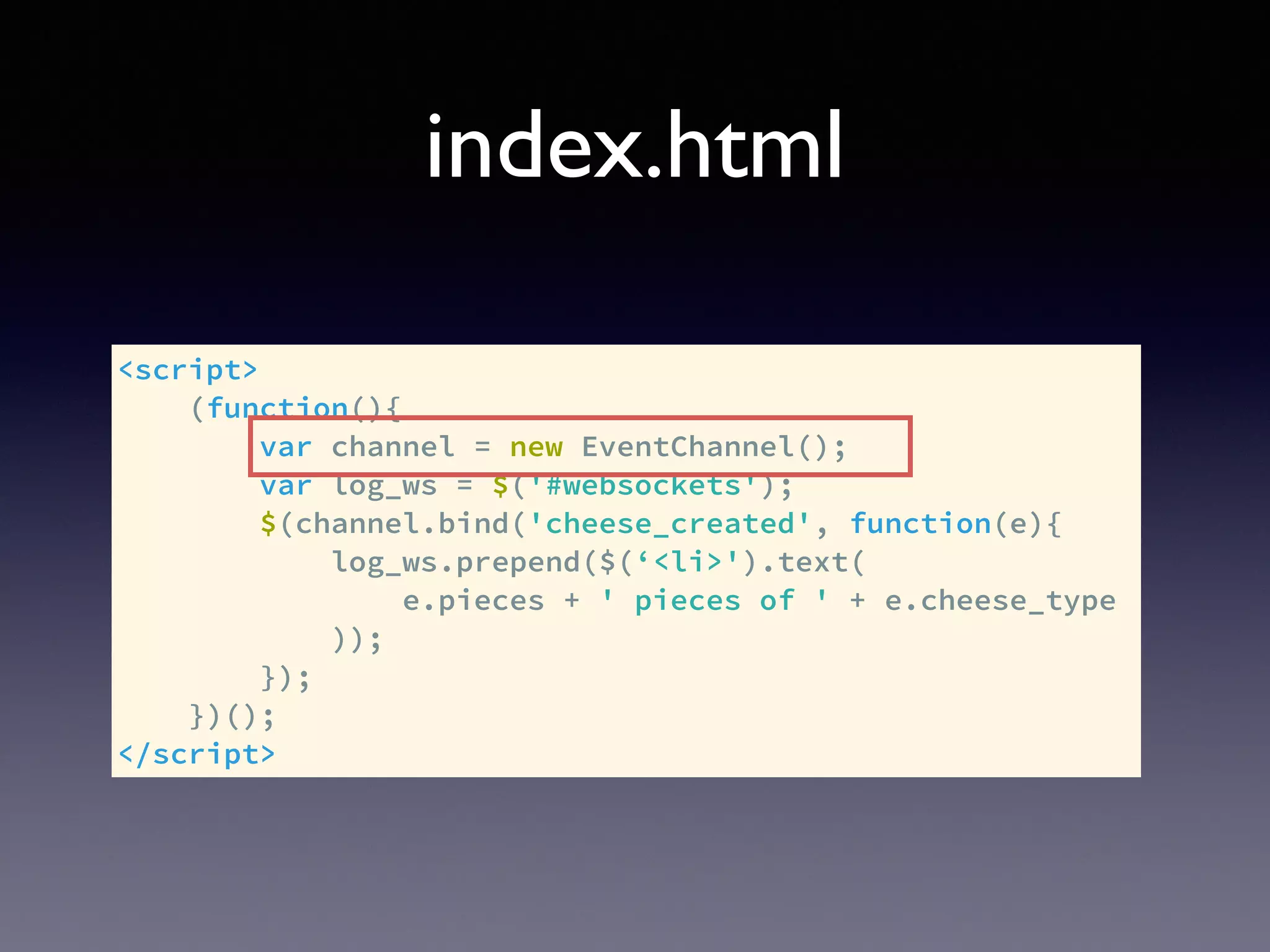
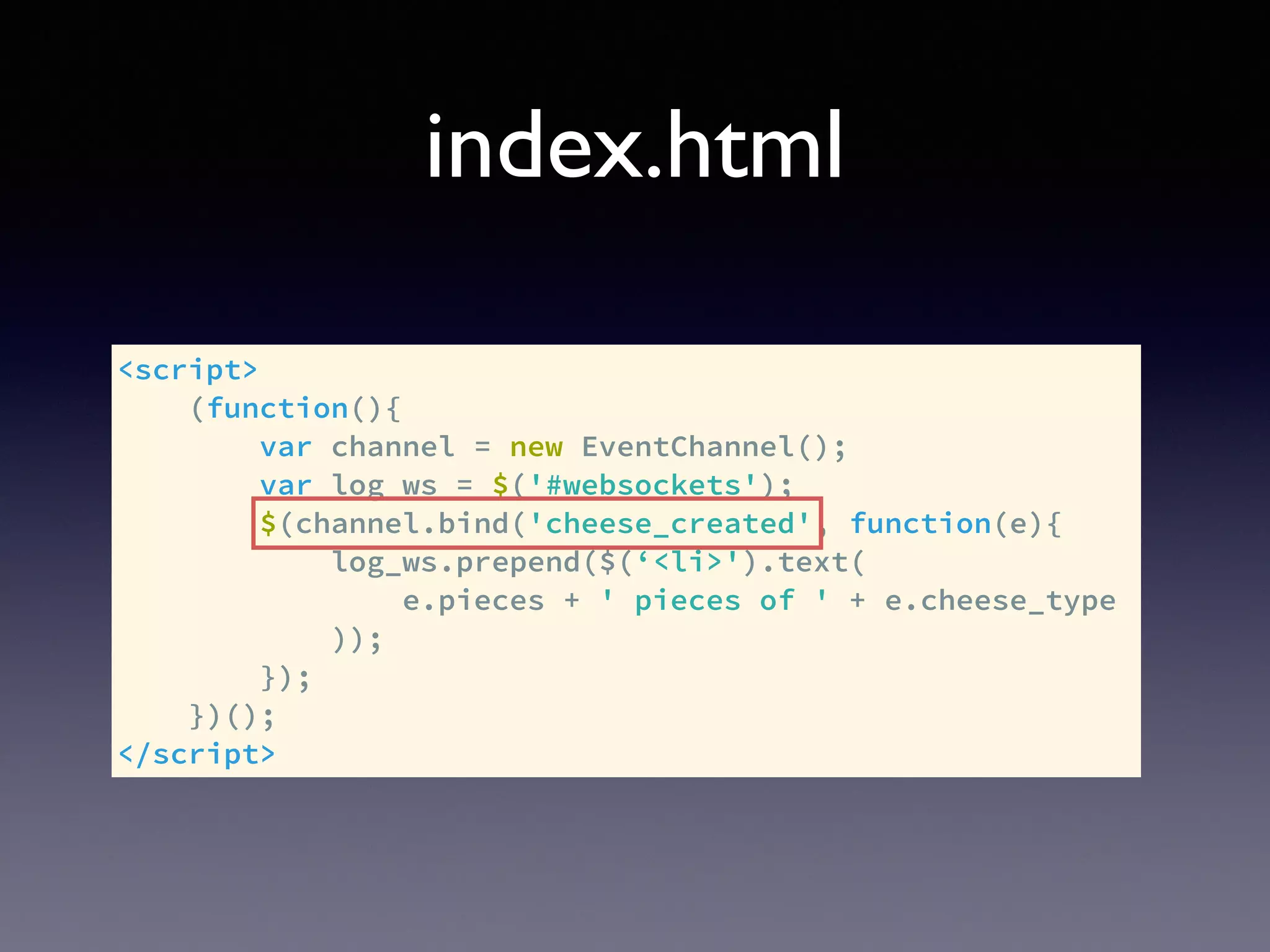
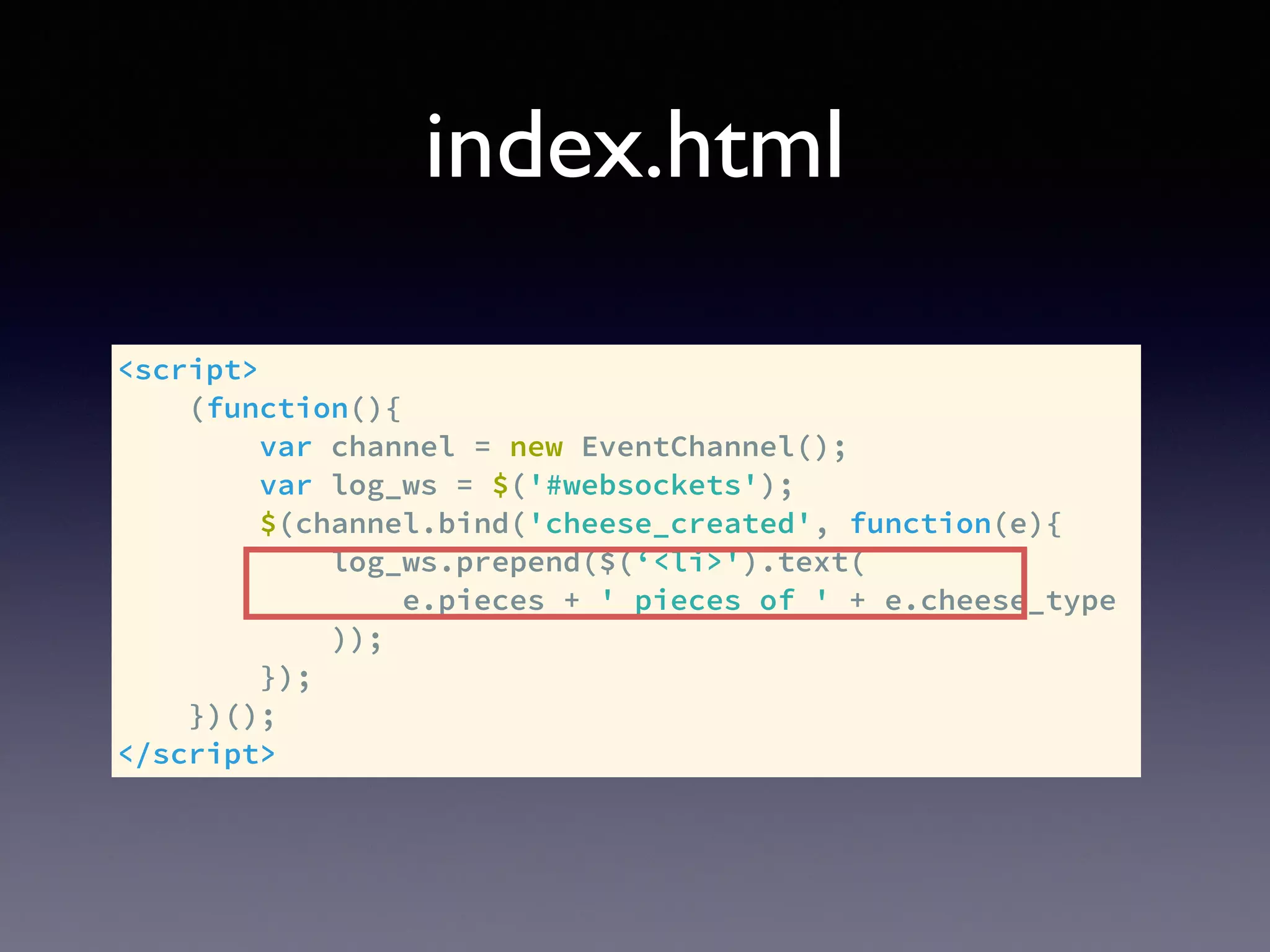
![publish.js
• Creates between 5 and 120
pieces of random Swiss cheese
• Publishes an event about this
• We’re using redis as our Pub/Sub
mechanism, but you could use
other solutions too
• Sorry for the indentation, but
code had to fit the slide
var cheese_types = ['Emmentaler',
'Appenzeller', 'Gruyère',
'Vacherin', ‘Sprinz'
];
function create_cheese(){
return {
pieces: Math.floor(Math.random()
* 115) + 5,
cheese_type:
cheese_types[Math.floor(
Math.random()
*cheese_types.length
)]
}
}
var cheese_delivery =
create_cheese();
publish(cheese_delivery);](https://image.slidesharecdn.com/server-side-events-140727092852-phpapp01/75/Server-Side-Events-23-2048.jpg)
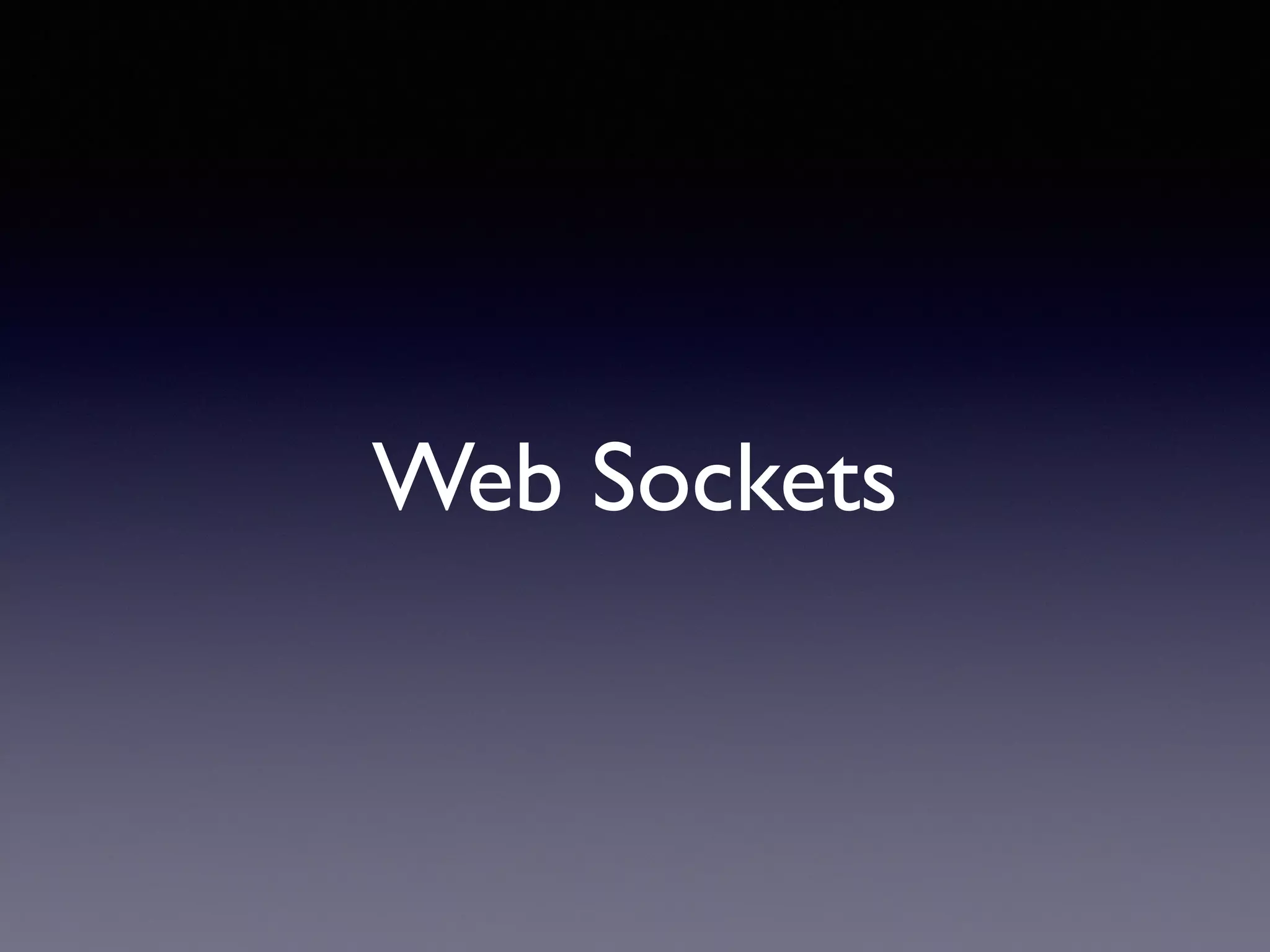
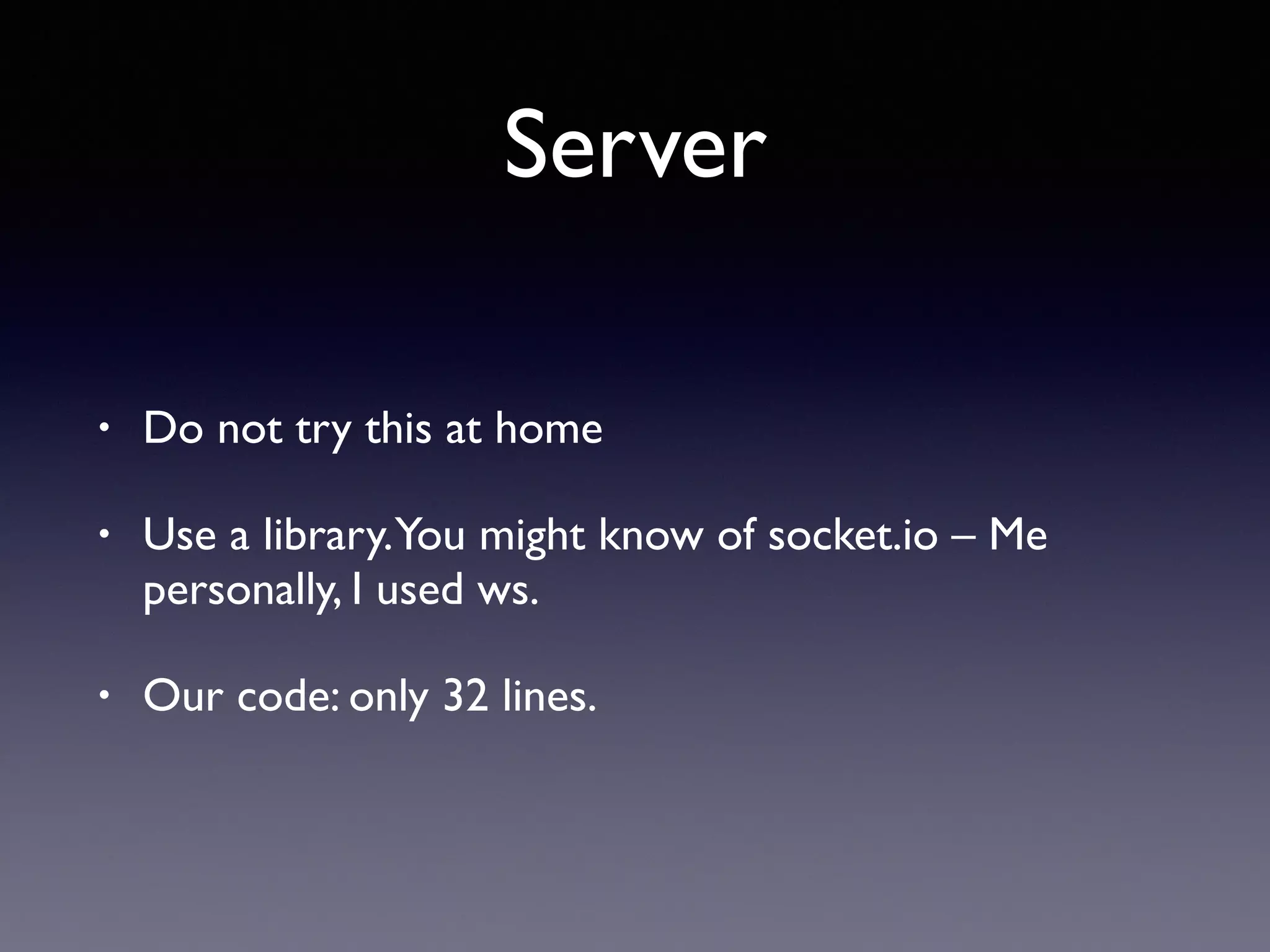
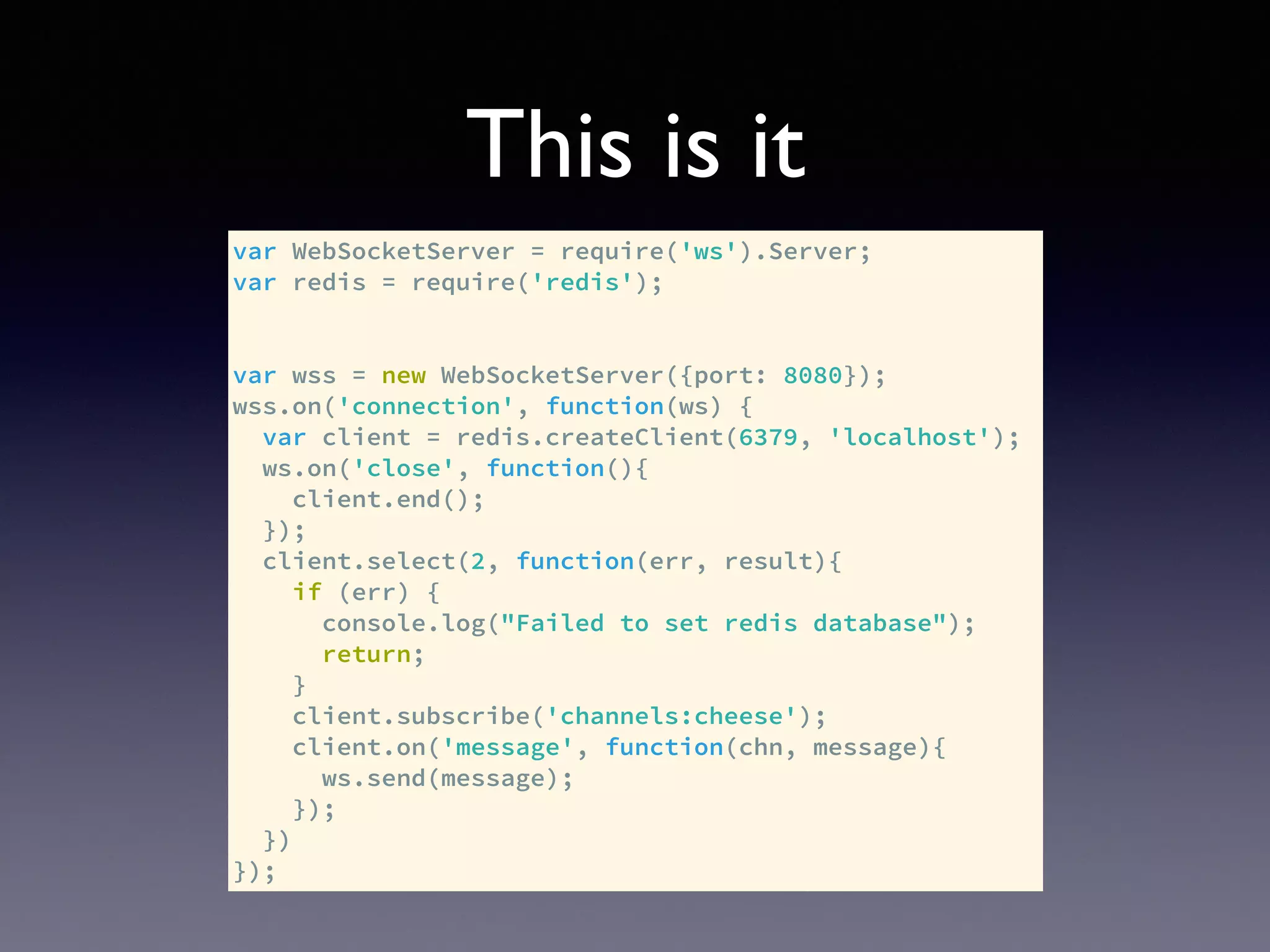
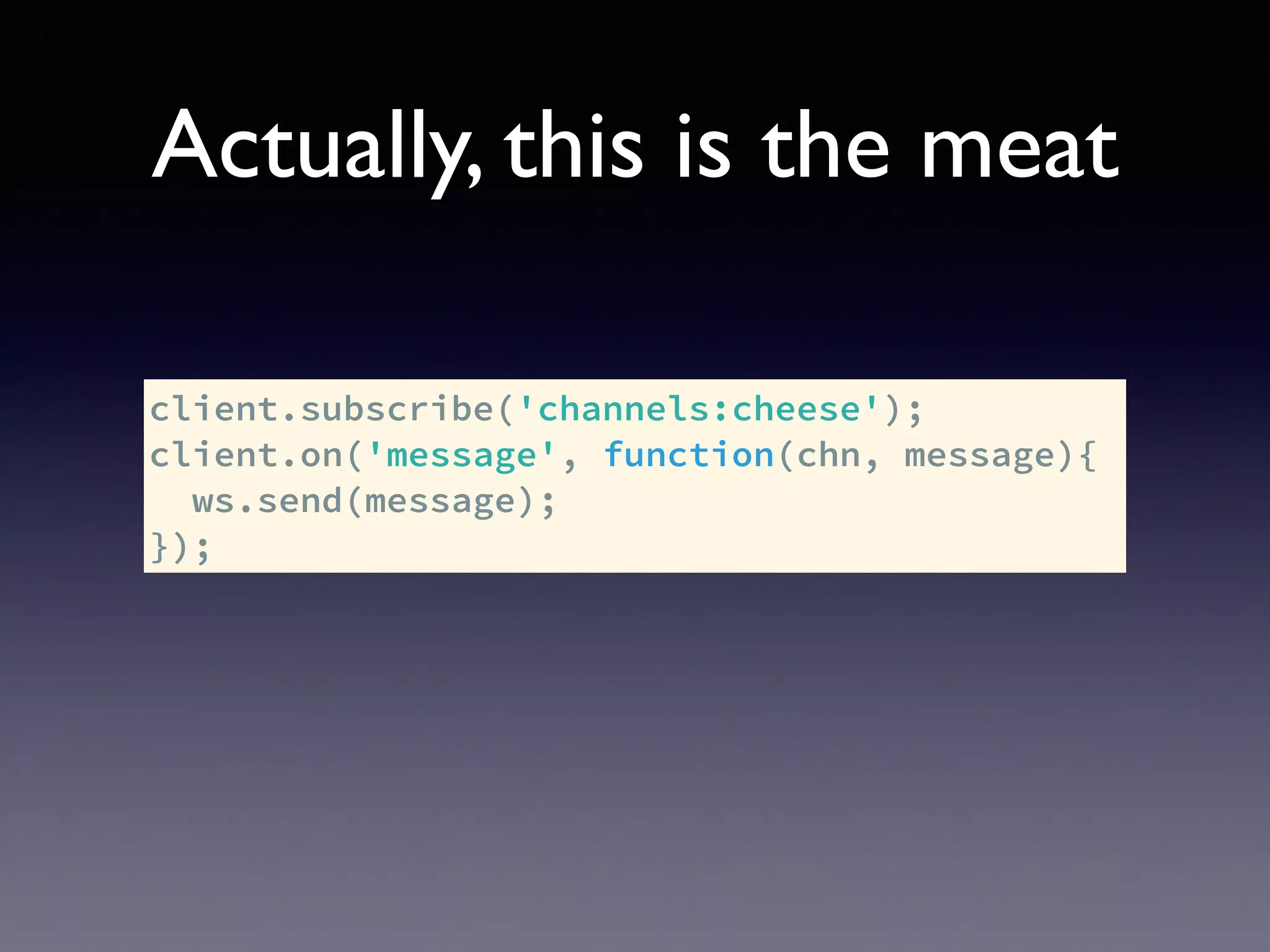
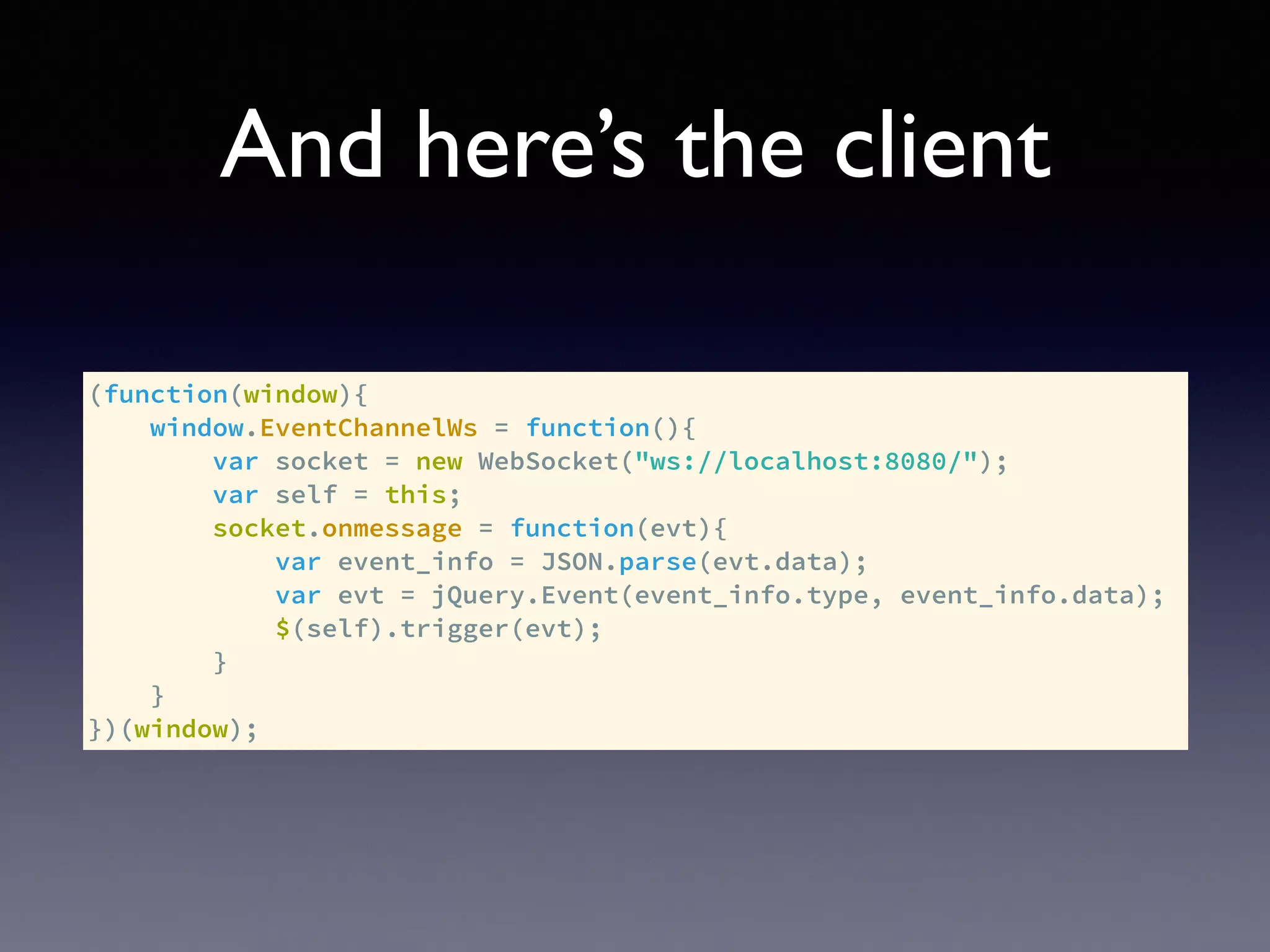
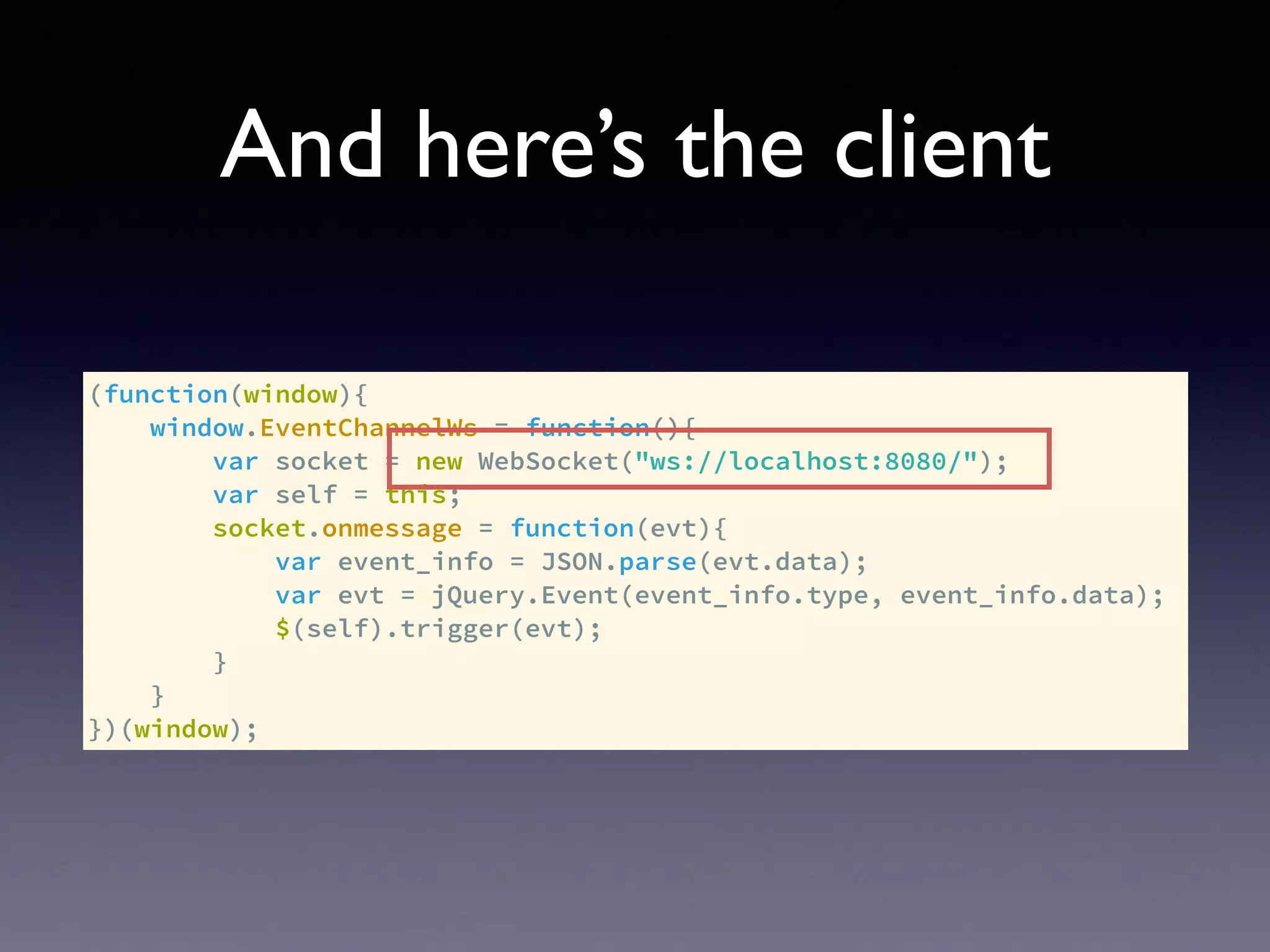
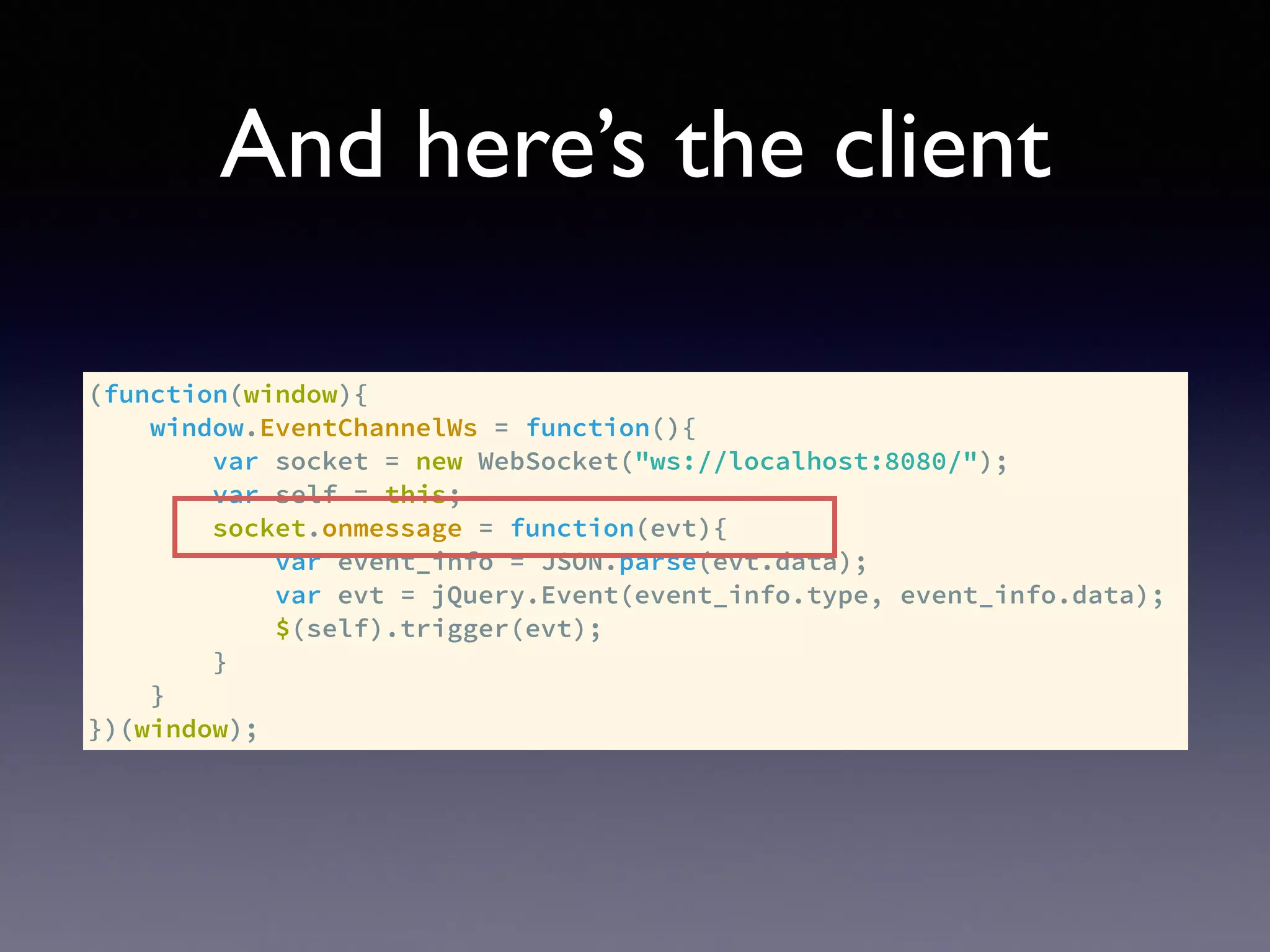
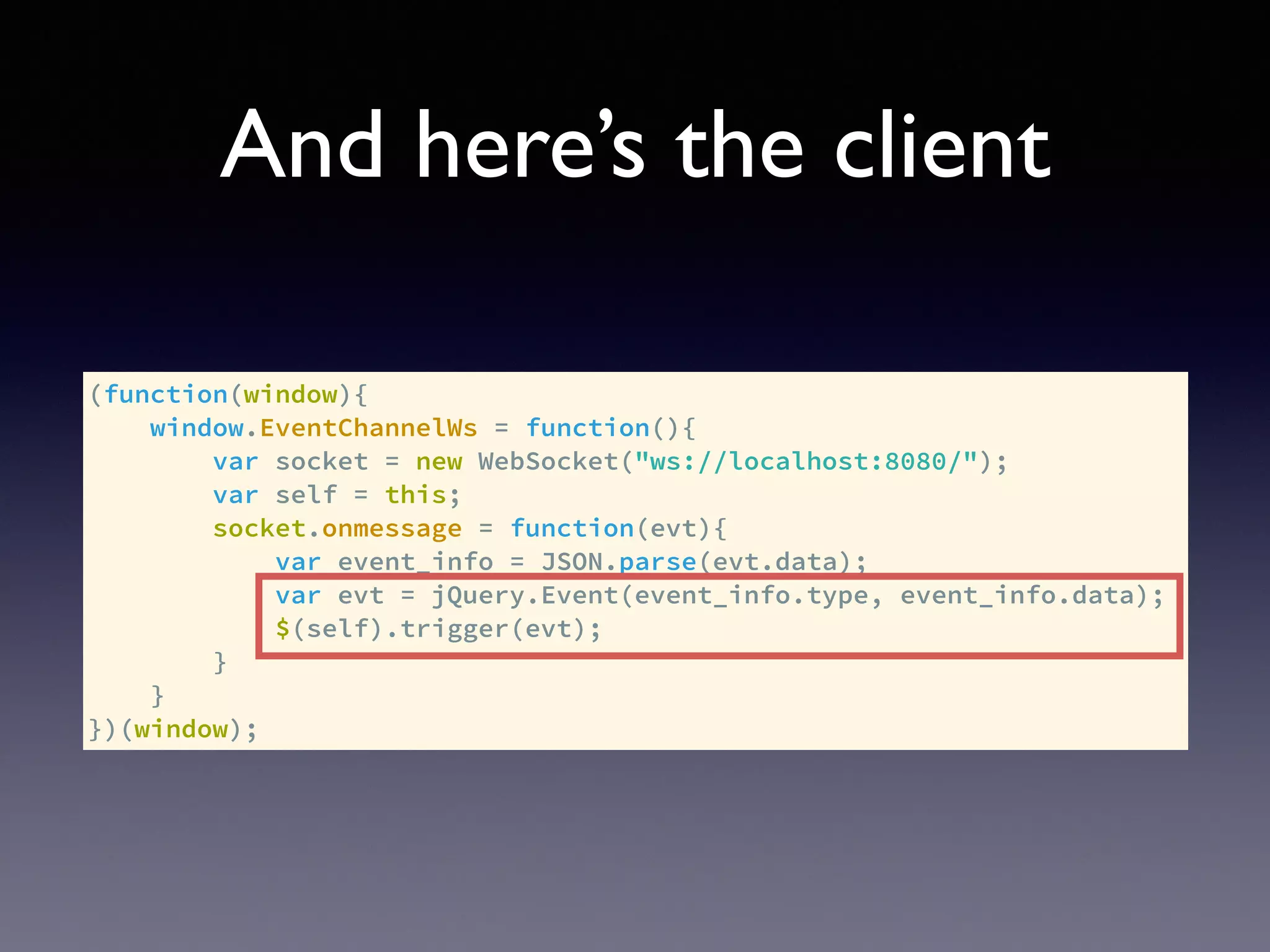
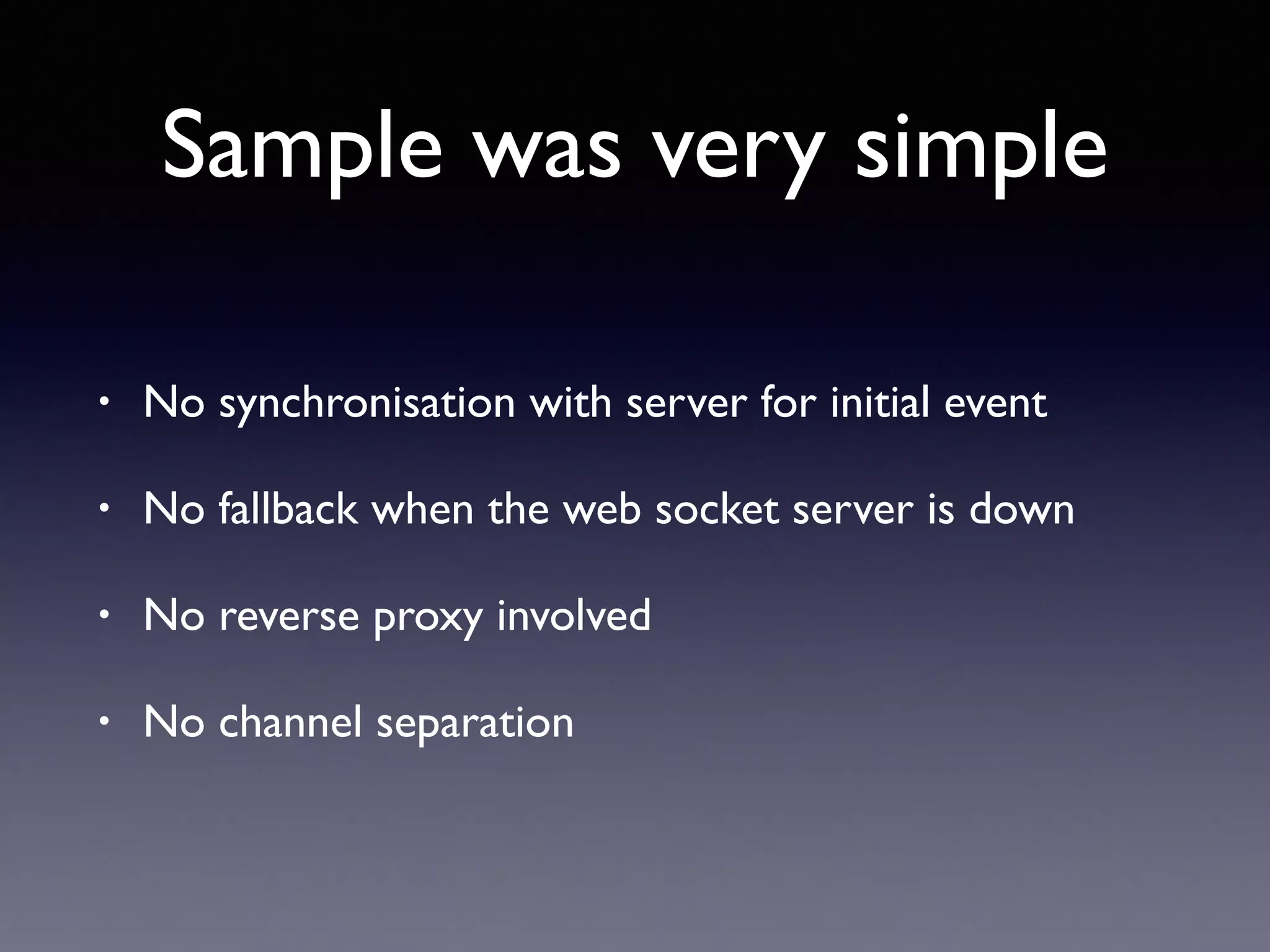
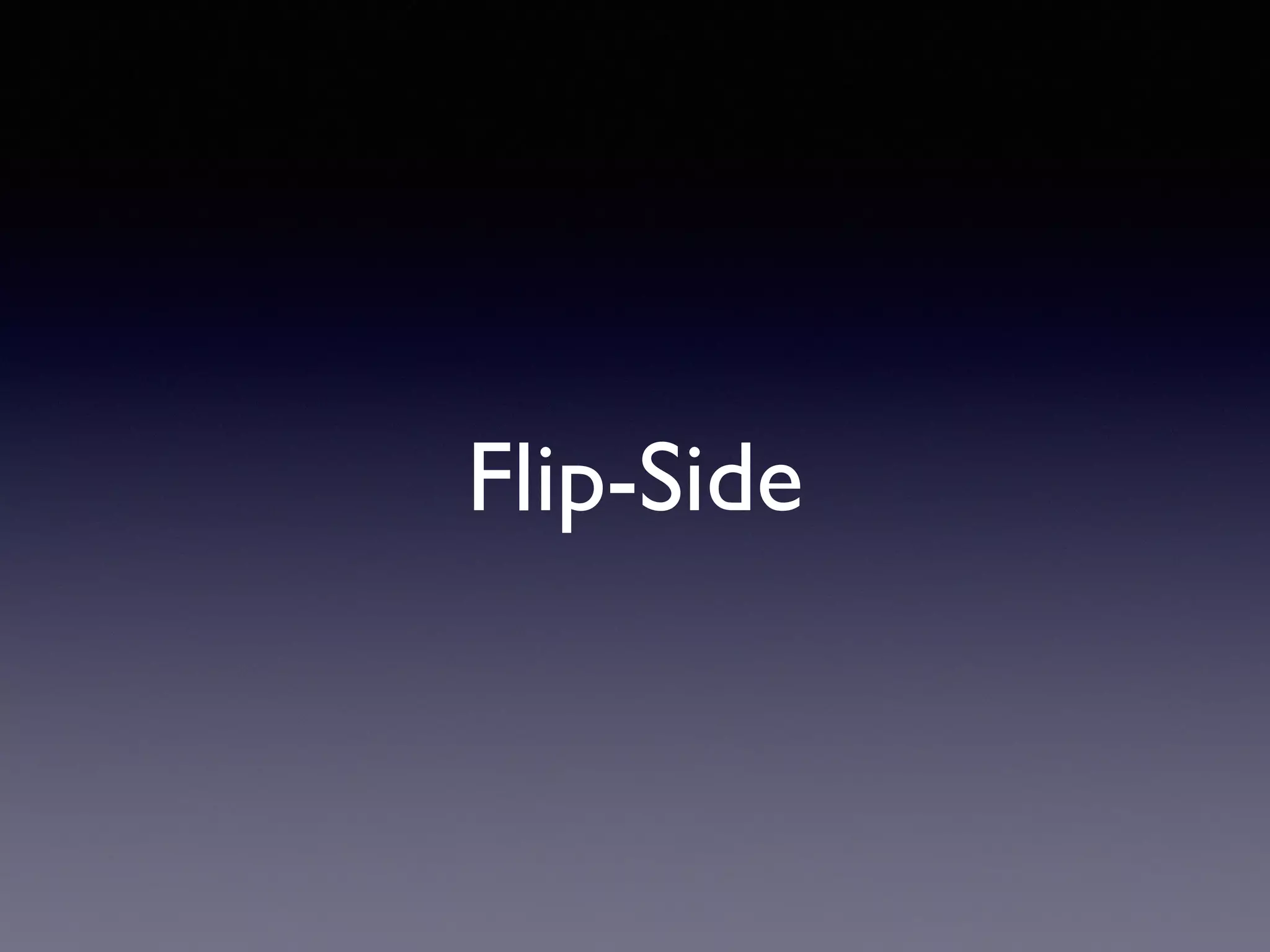
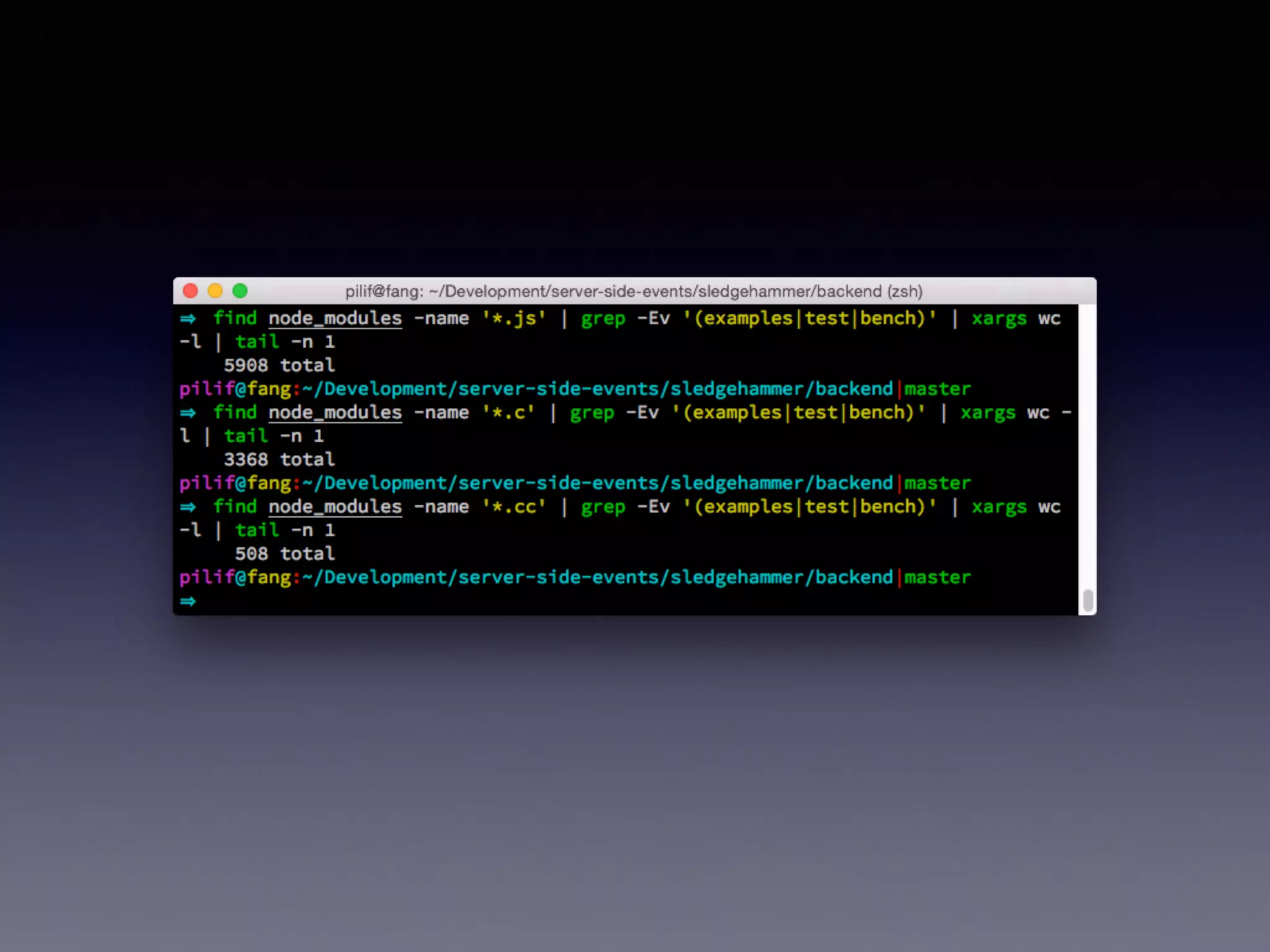
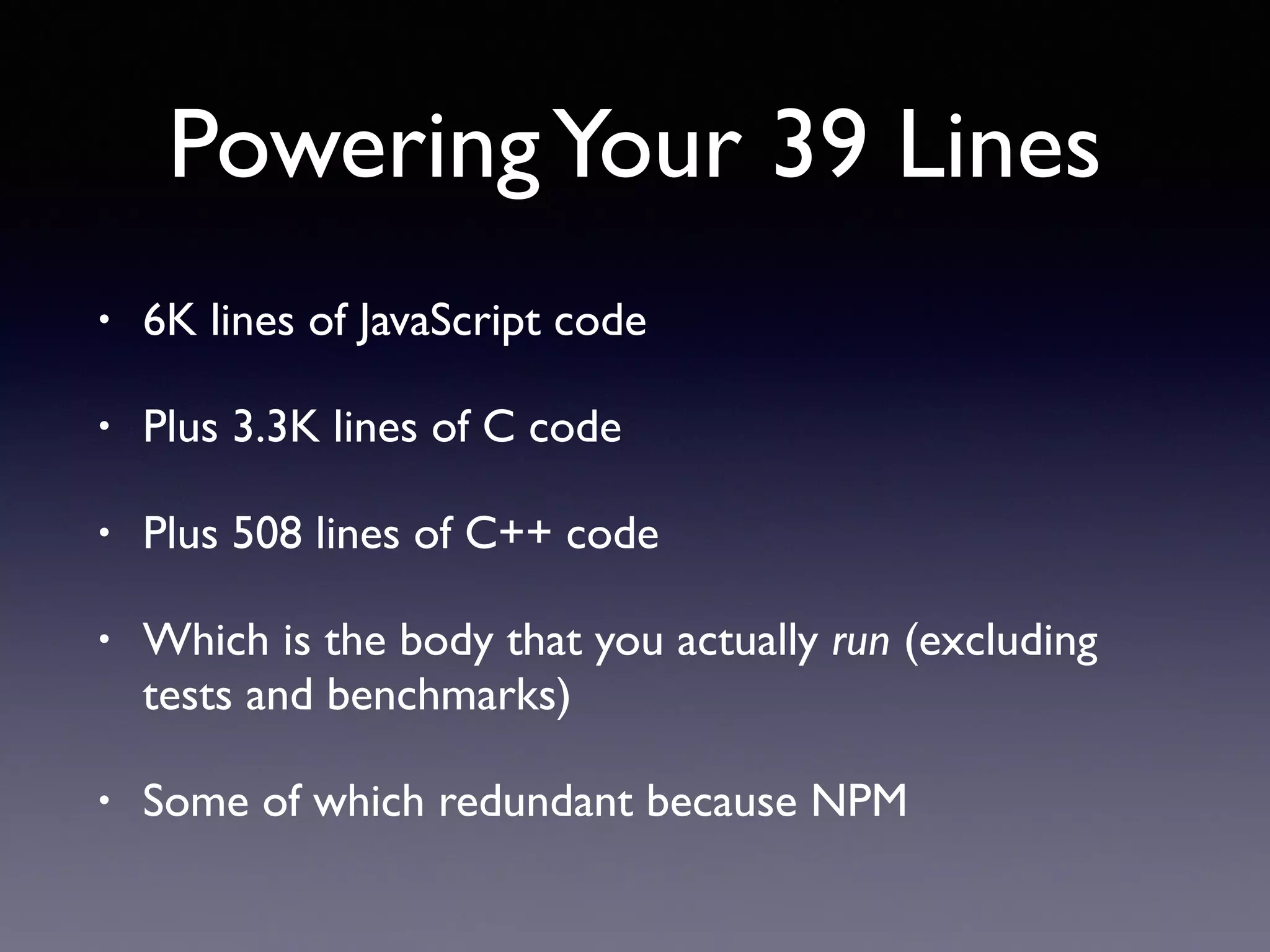
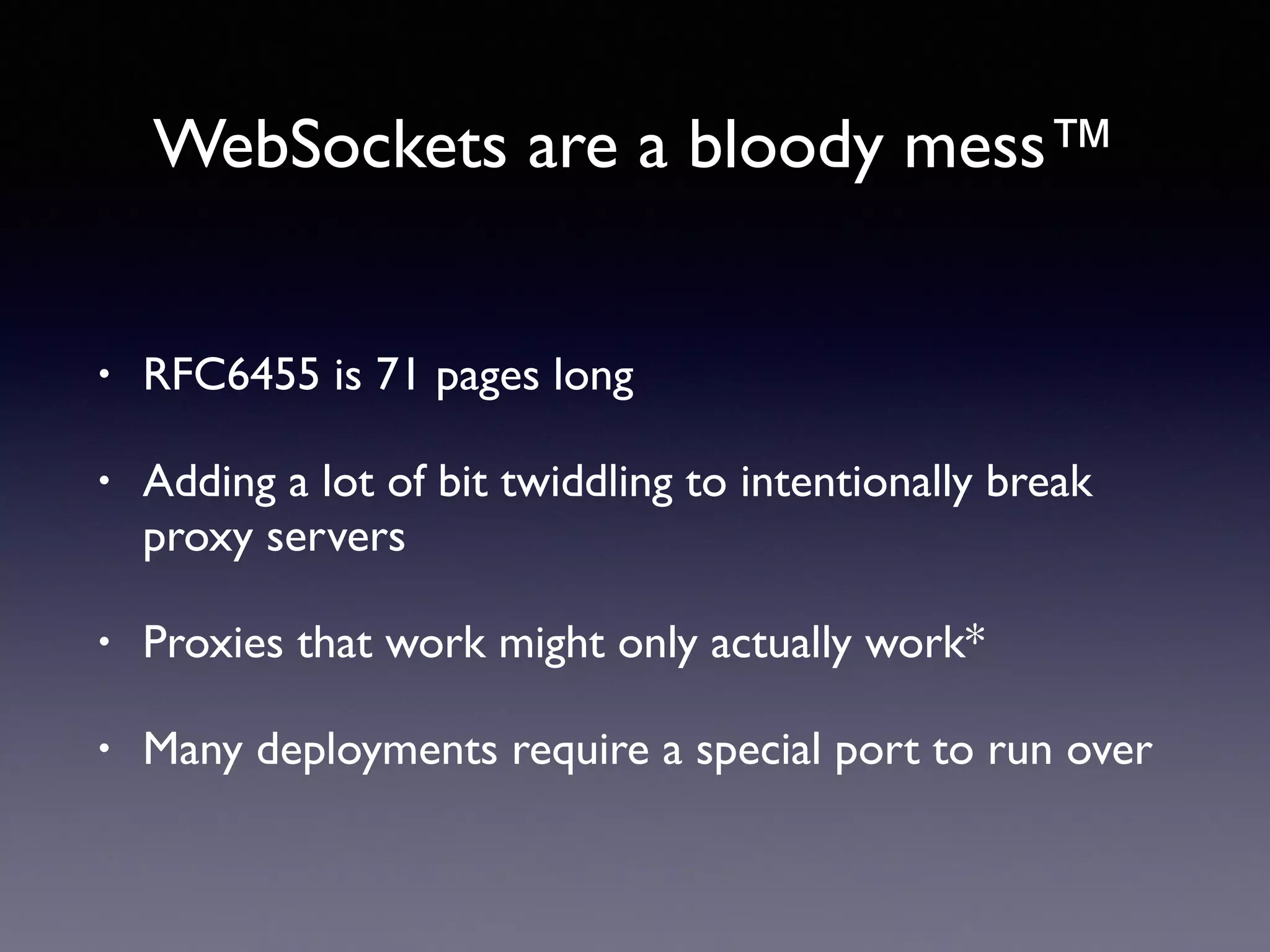
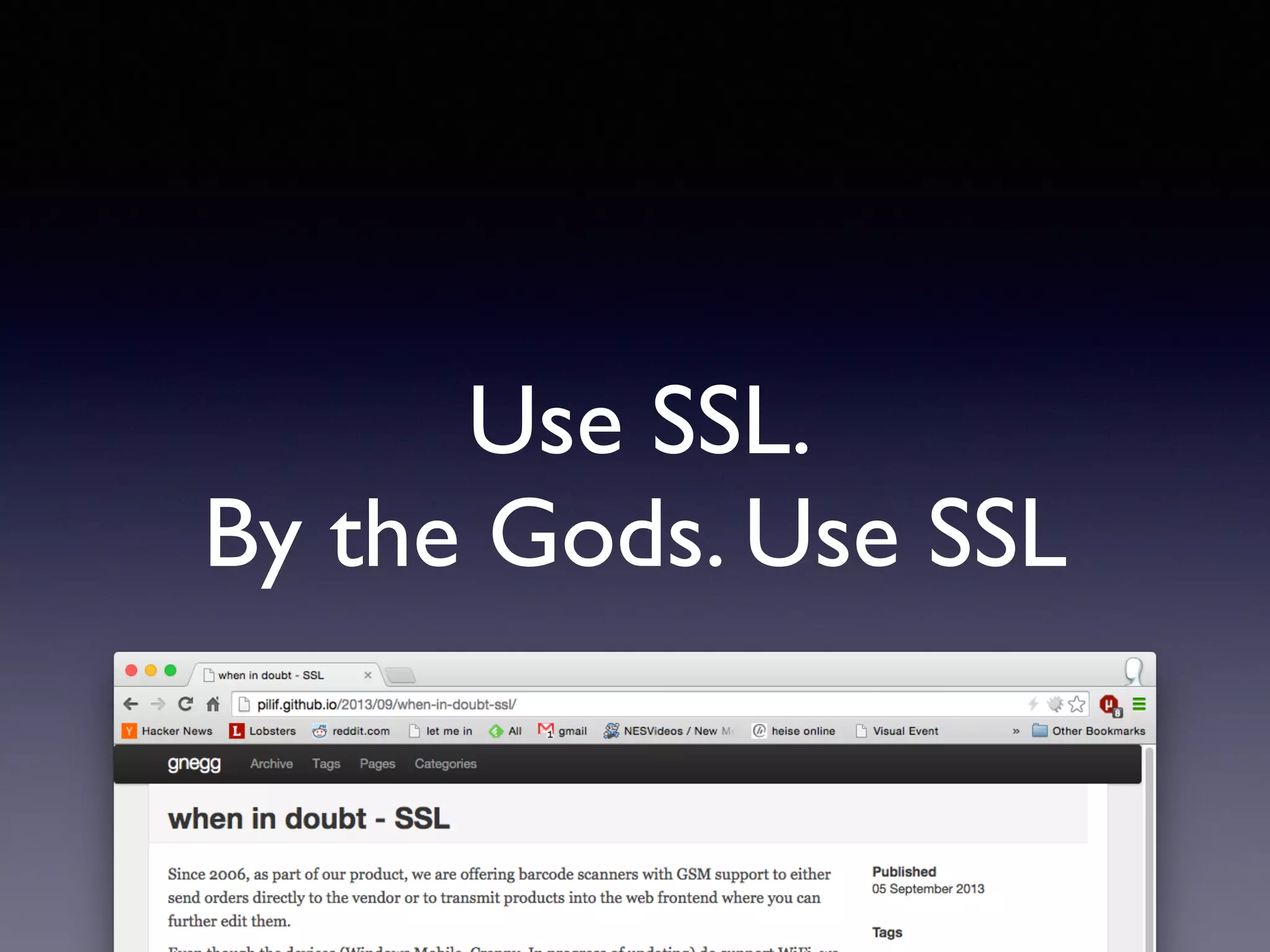
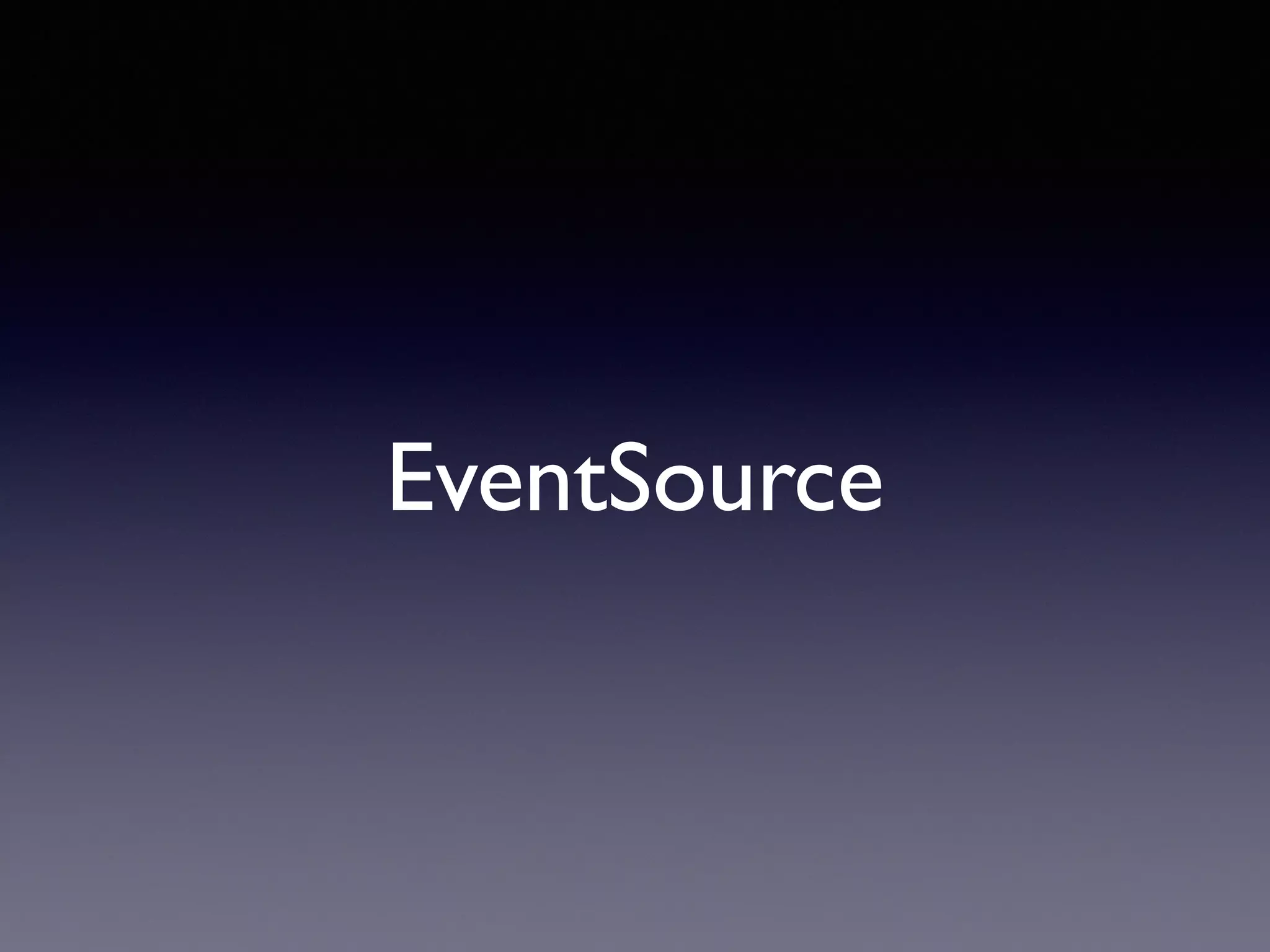
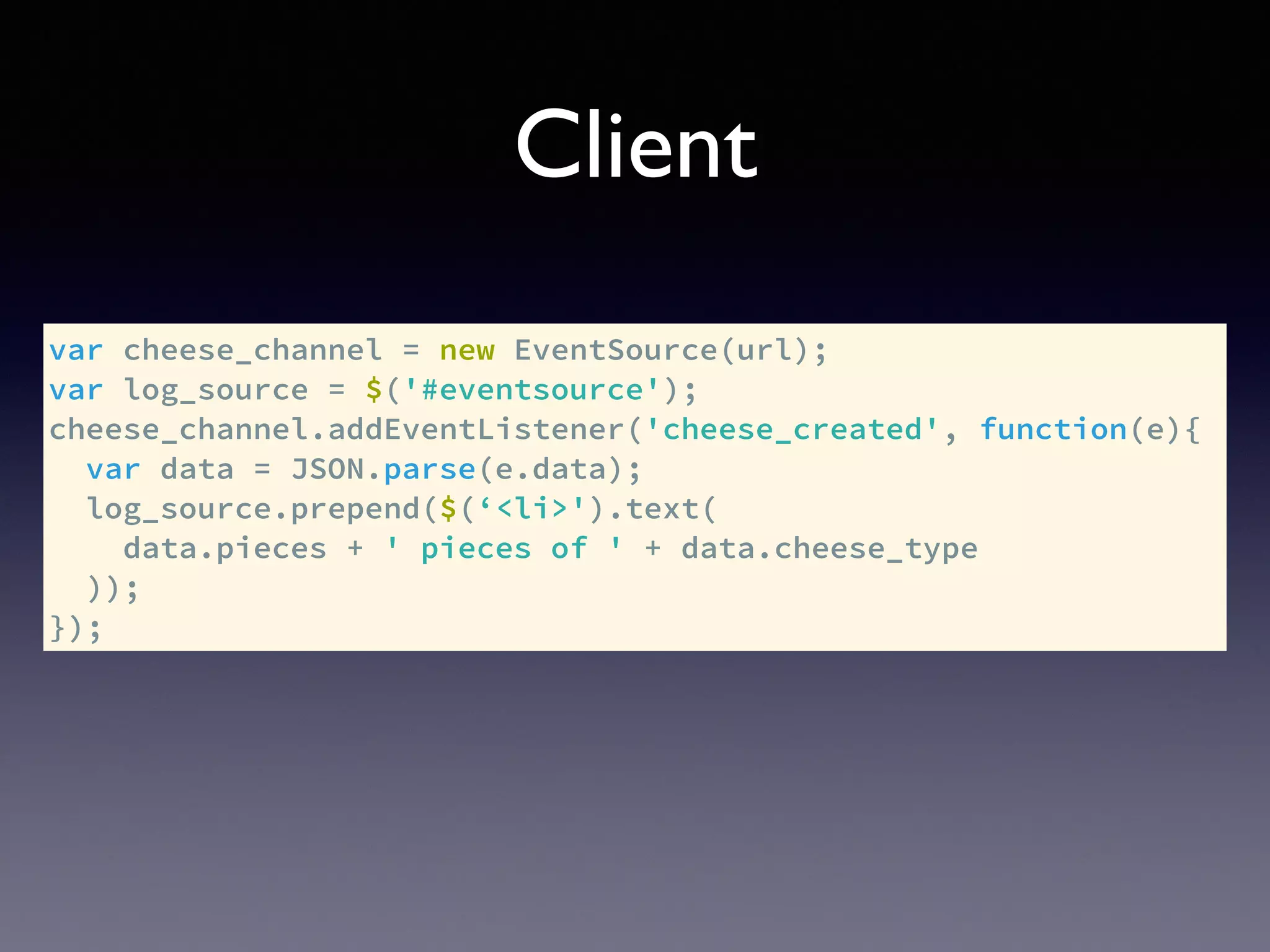
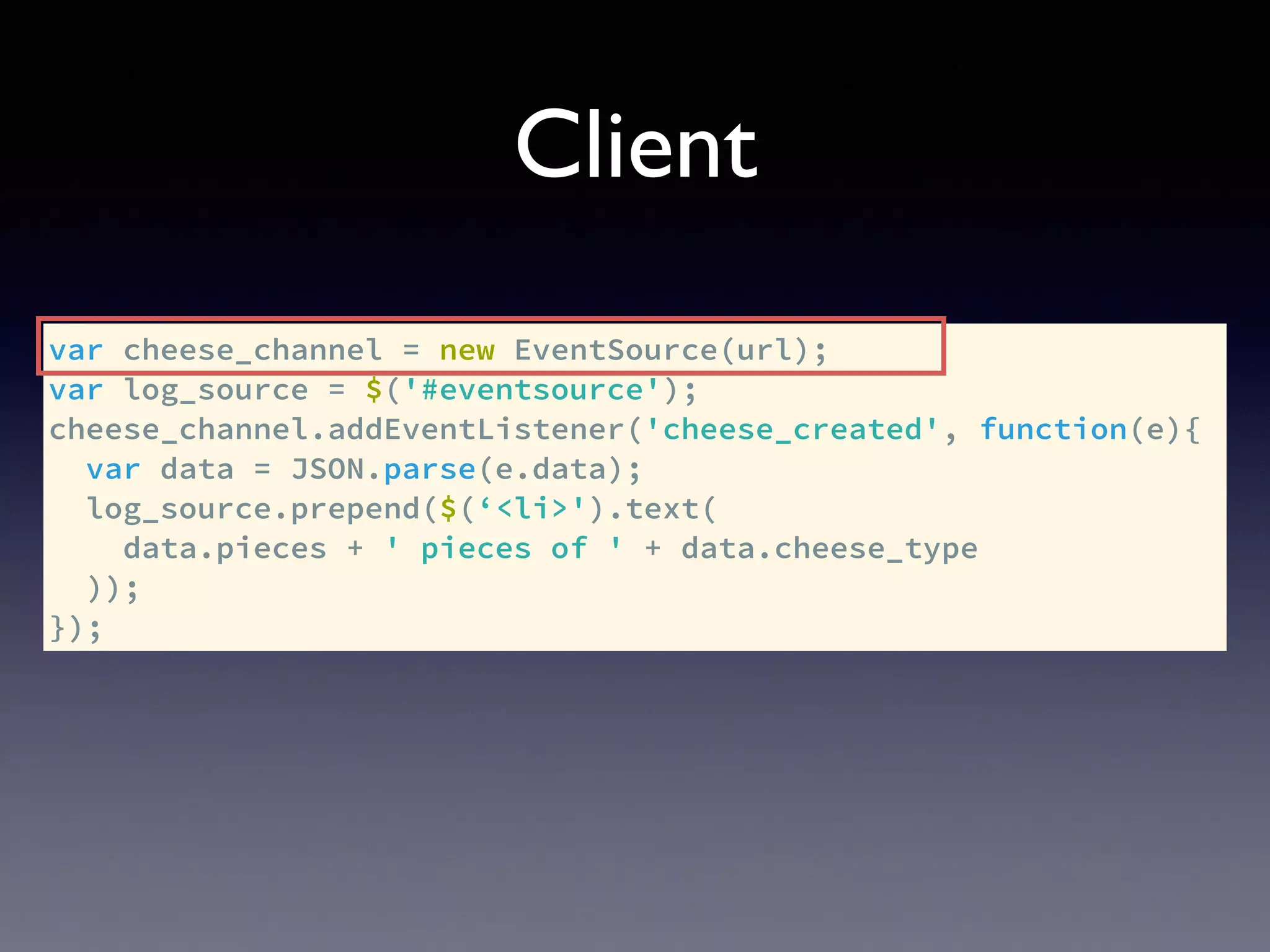
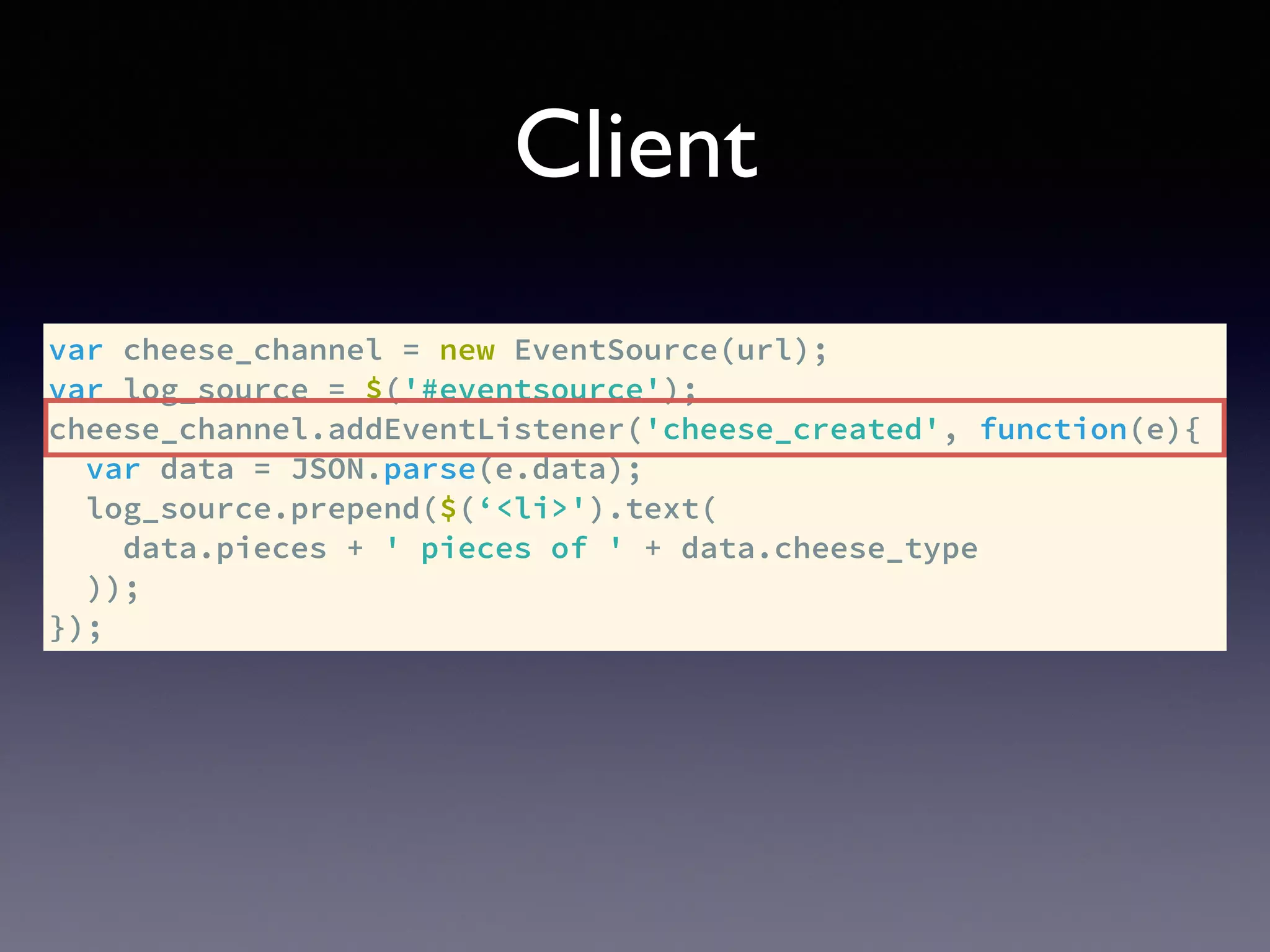
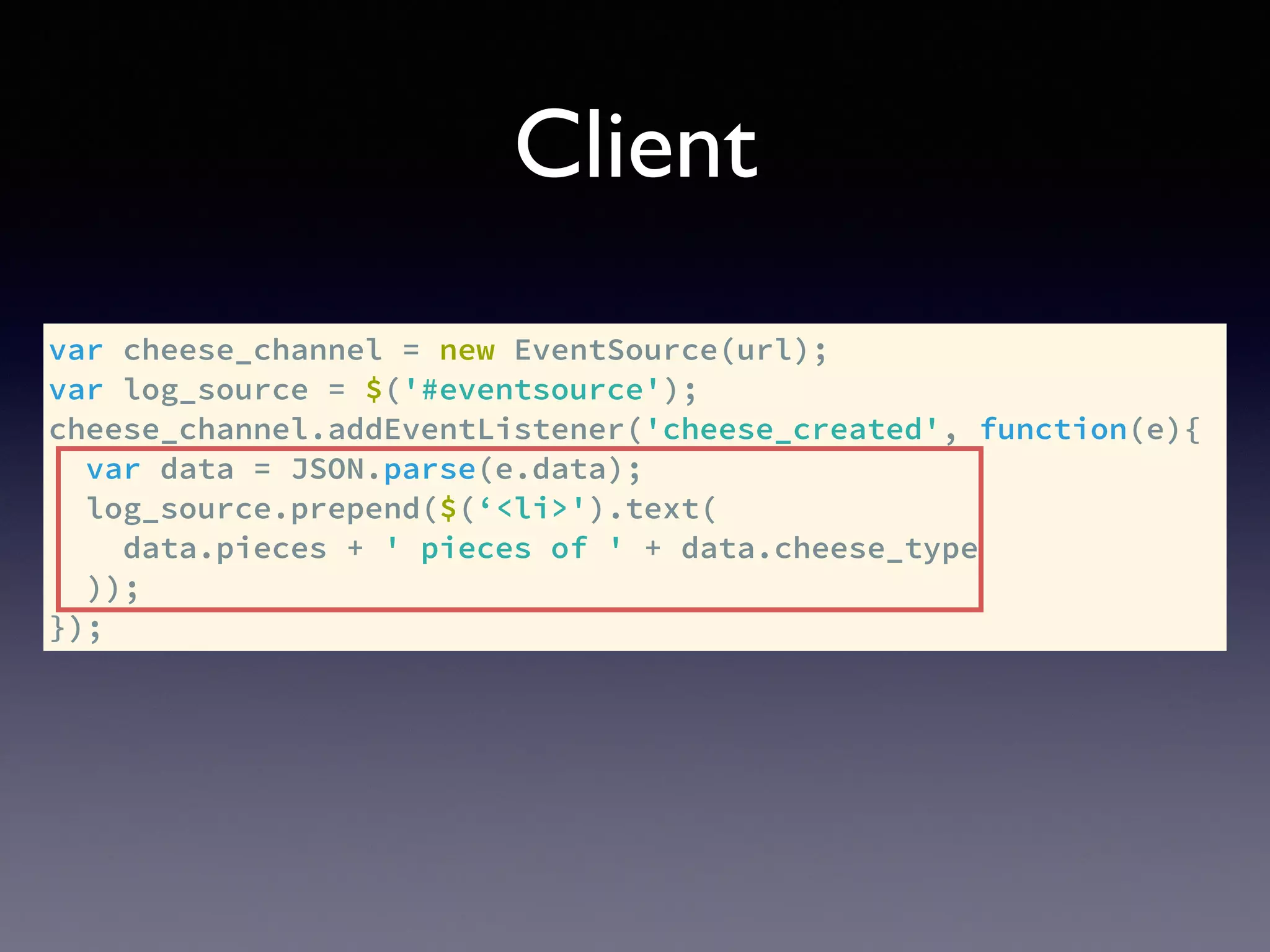
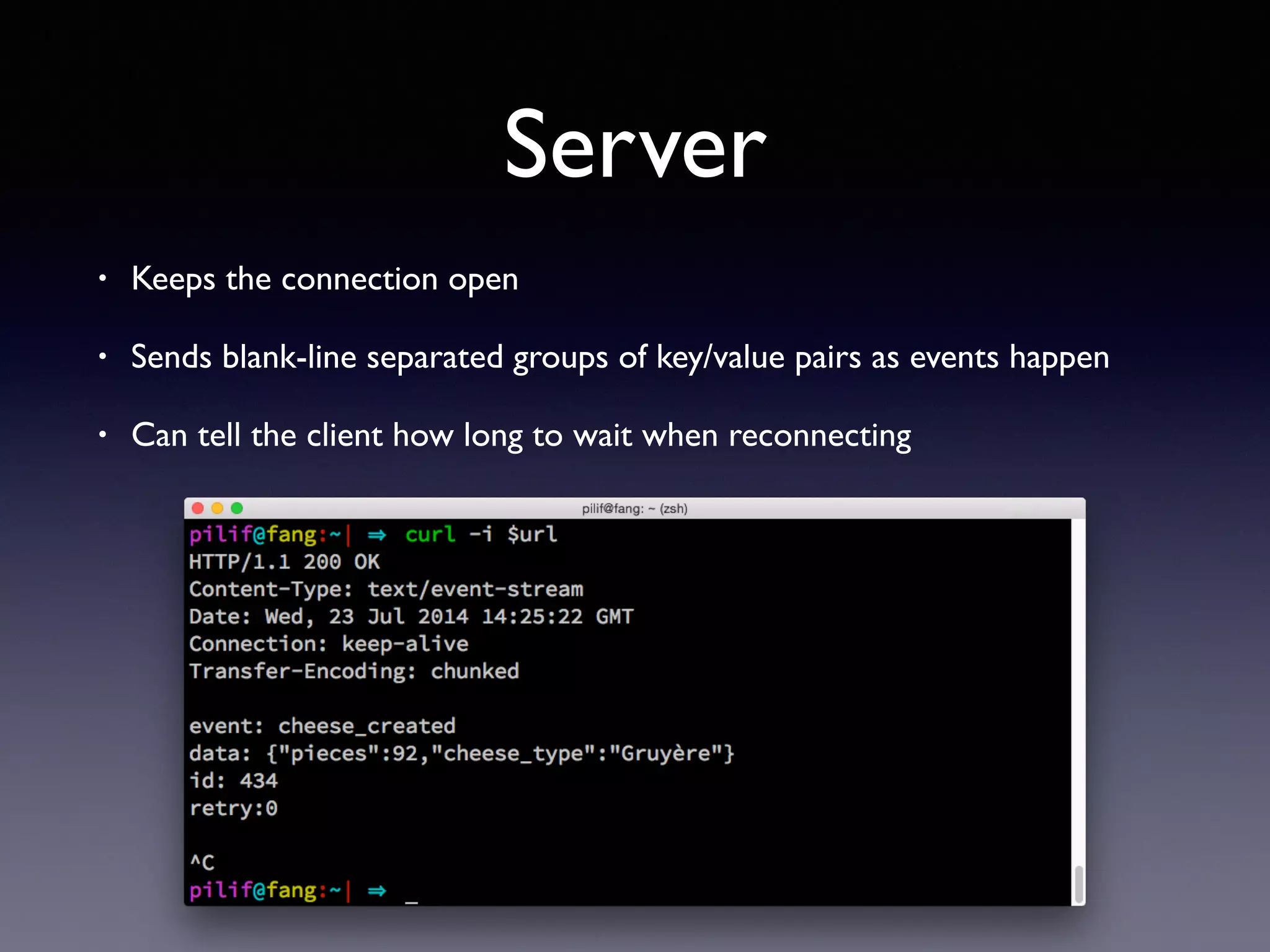
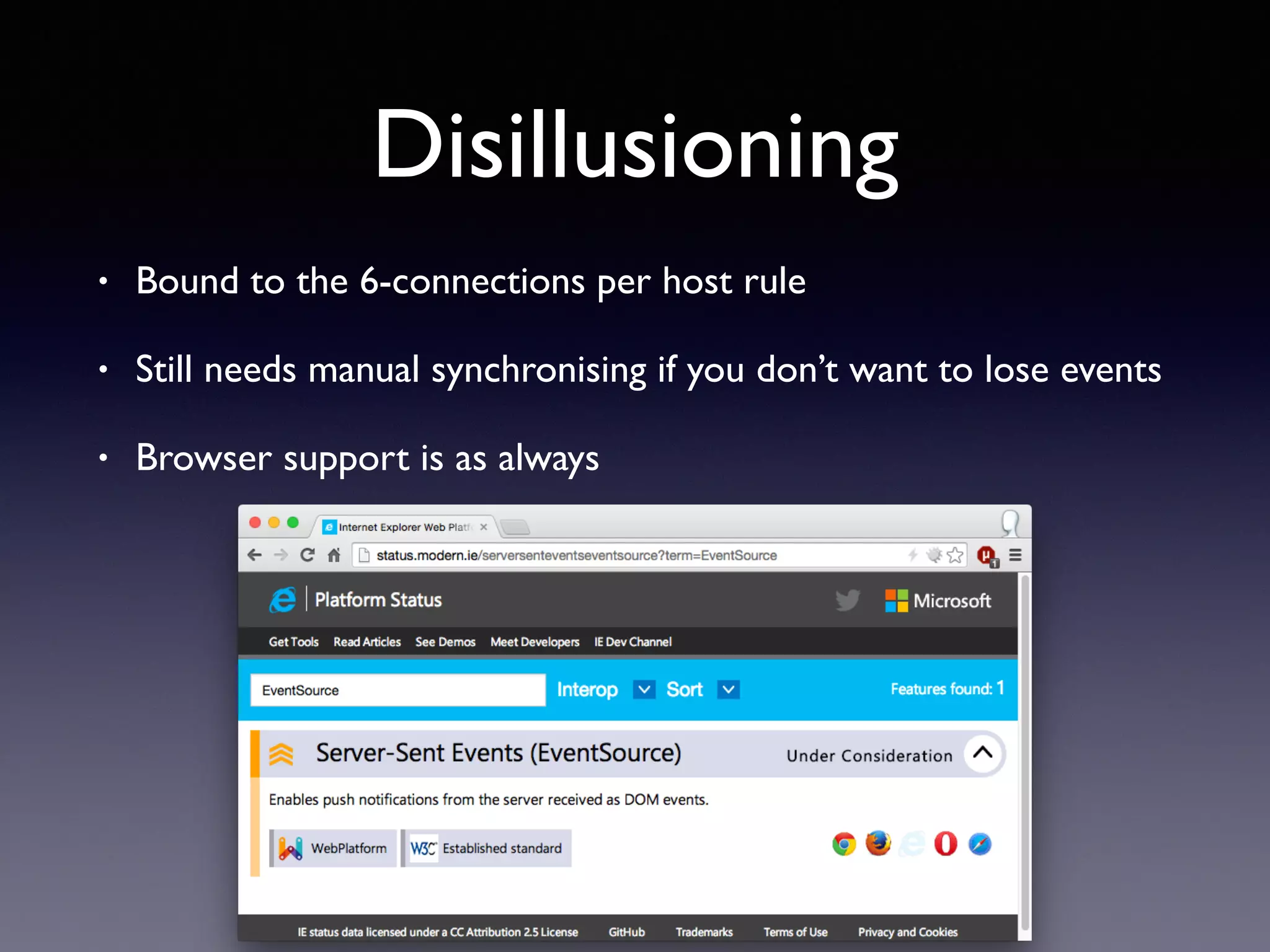
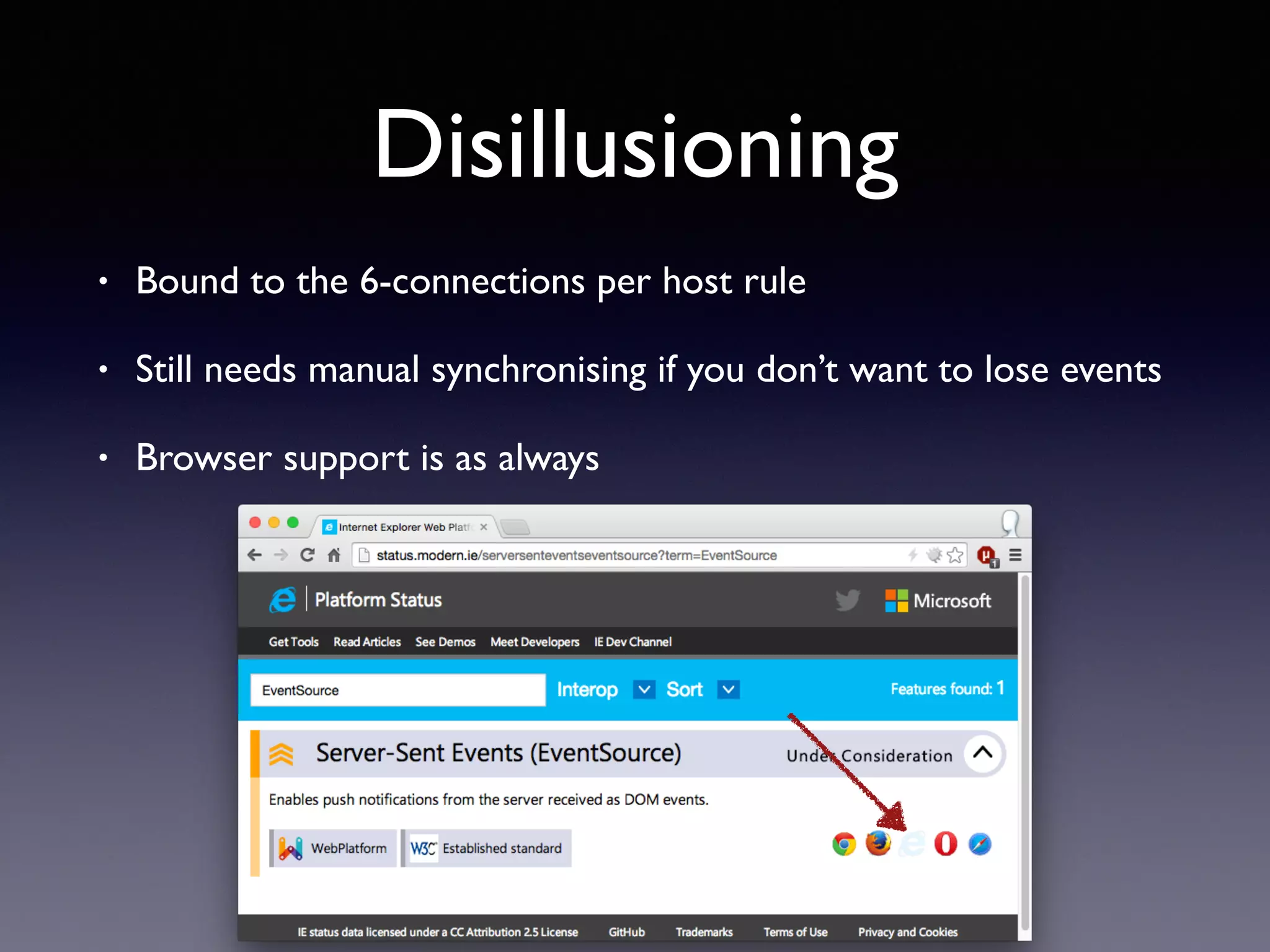
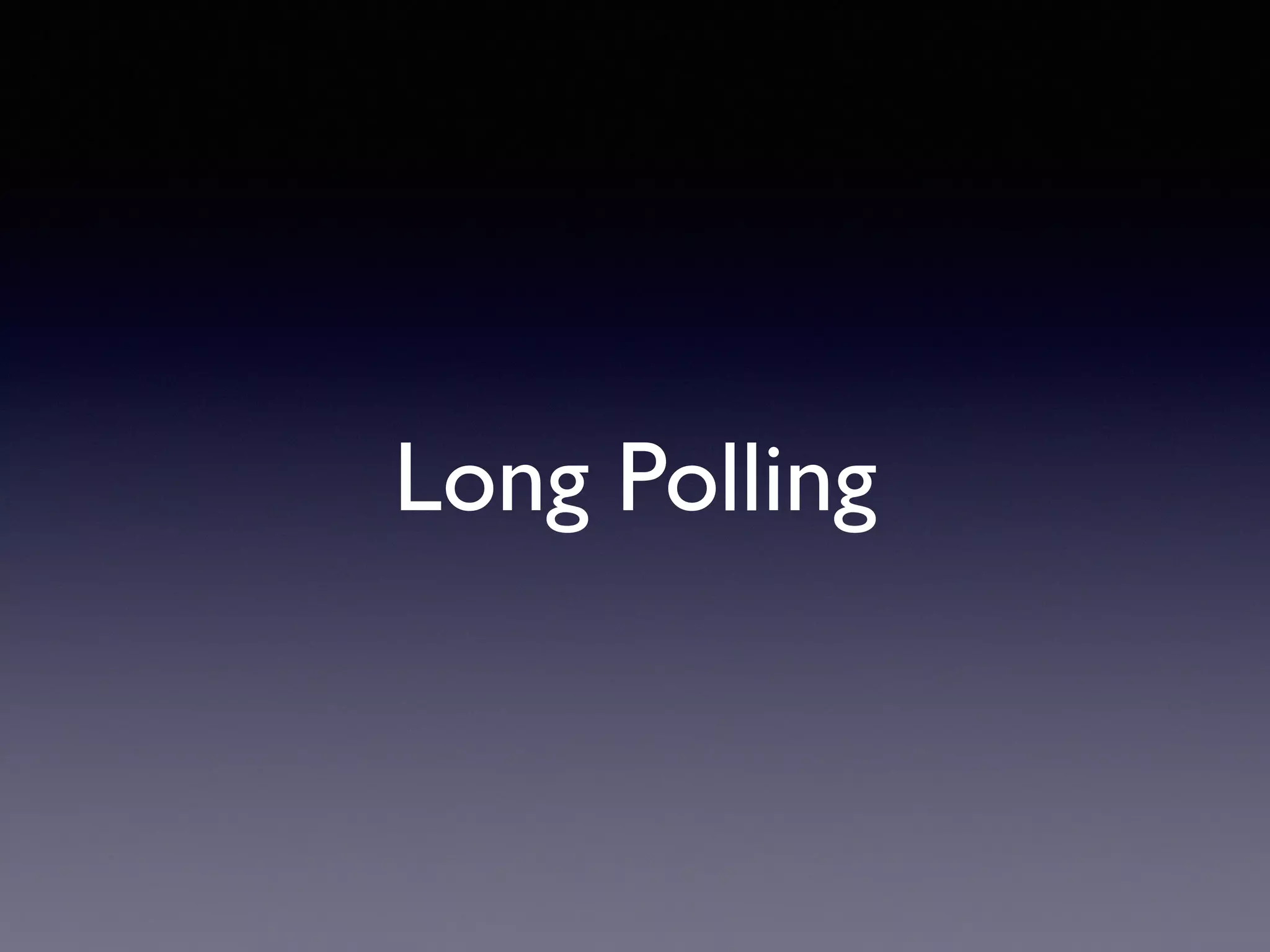
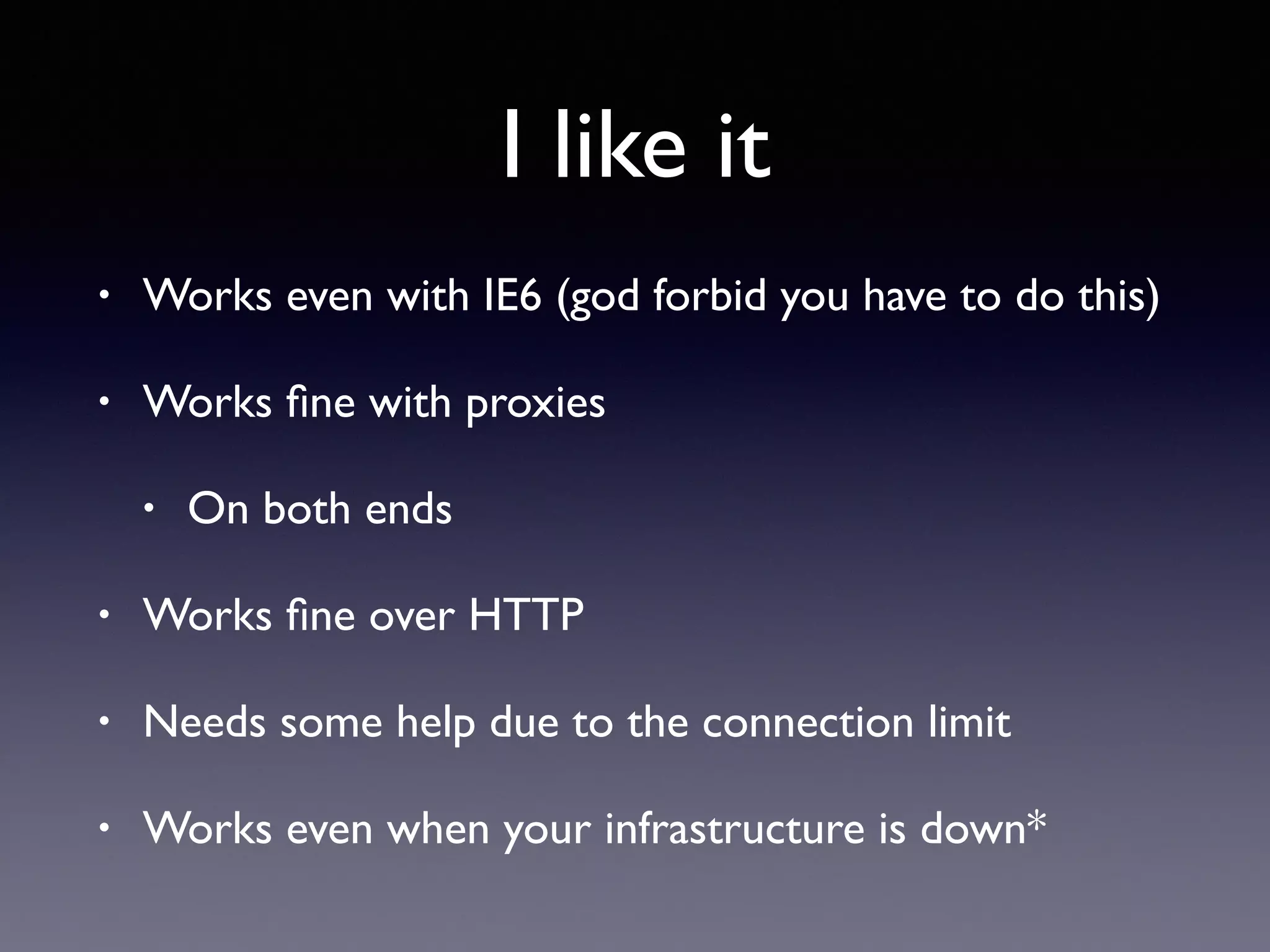
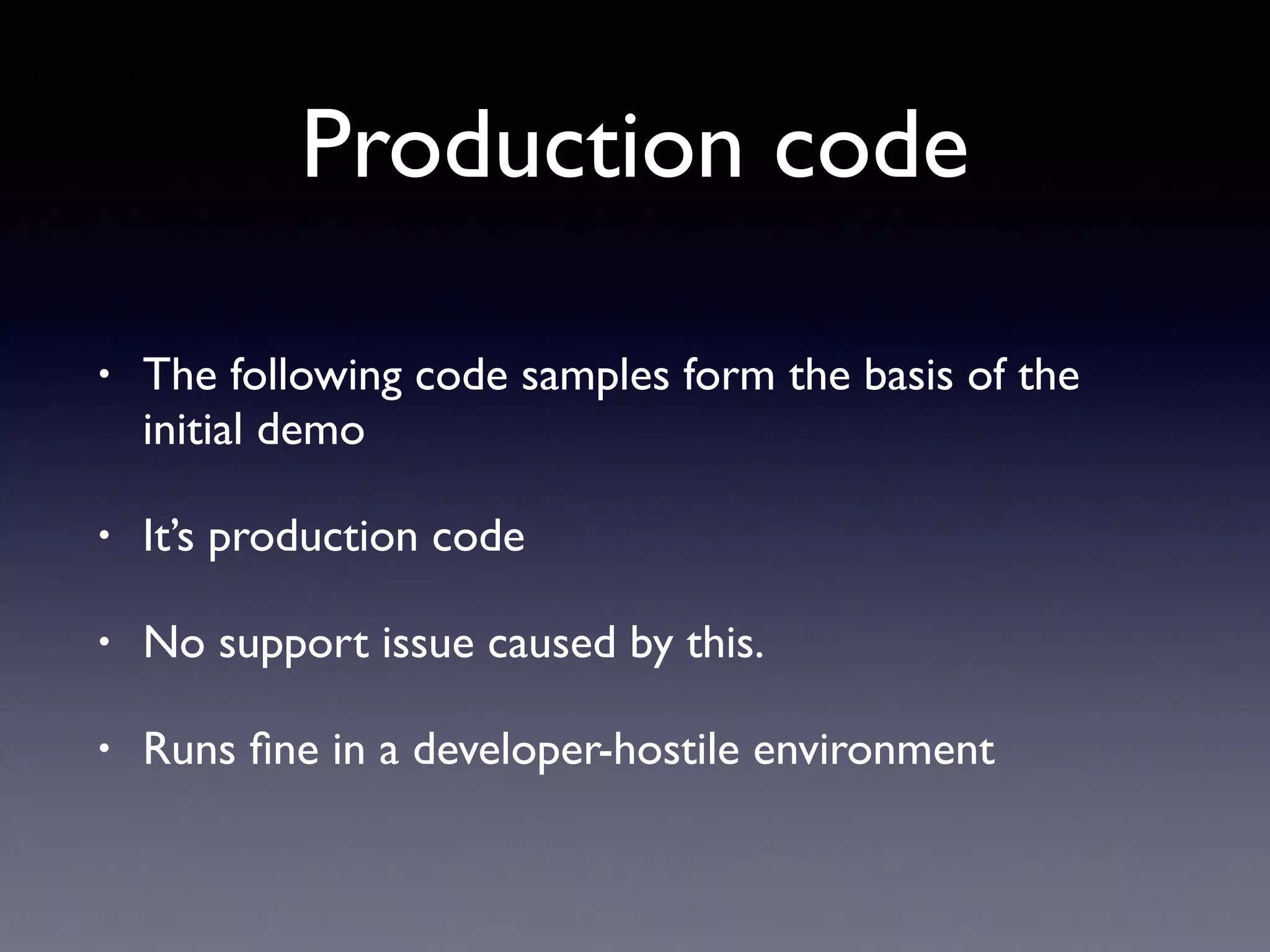
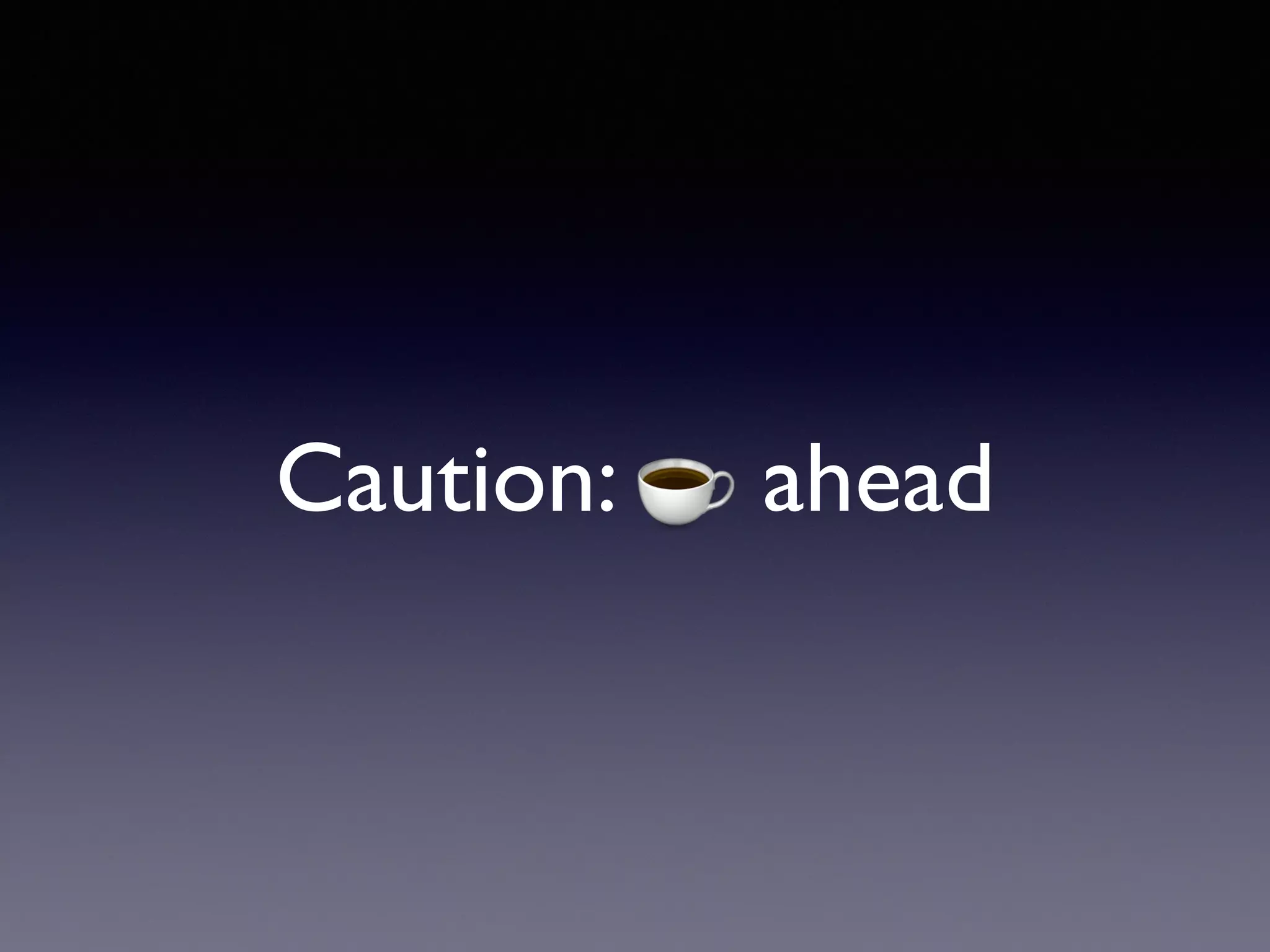
![Synchronising using the
database
events_since_id = (channel, id, cb)->
q = """
select * from events
where channel_id = $1 and id > $2
order by id asc
"""
query q, [channel, id], cb
events_since_time = (channel, ts, cb)->
q = """
select * from events o
where channel_id = $1
and ts > (SELECT TIMESTAMP WITH TIME ZONE 'epoch'
+ $2 * INTERVAL '1 second’
)
order by id asc
"""
query q, [channel, ts], cb](https://image.slidesharecdn.com/server-side-events-140727092852-phpapp01/75/Server-Side-Events-50-2048.jpg)
![The meat
handle_subscription = (c, message)->
fetch_events channel, last_event_id, (err, evts)->
return http_error 500, 'Failed to get event data' if err
abort_processing = write res, evts, true
last_event_id = evts[evts.length-1].id if (evts and evts.length > 0)
if abort_processing
unsubscribe channel, handle_subscription
clear_waiting()
res.end()
fetch_events channel, last_event_id, (err, evts)->
return http_error res, 500, 'Failed to get event data: ' + err if err
last_event_id = evts[evts.length-1].id if (evts and evts.length > 0)
if waiting() or (evts and evts.length > 0)
abort_processing = write(res, evts, not waiting());
if waiting() or abort_processing
unsubscribe channel, handle_subscription
res.end()
set_waiting()
subscribe channel, handle_subscription](https://image.slidesharecdn.com/server-side-events-140727092852-phpapp01/75/Server-Side-Events-51-2048.jpg)
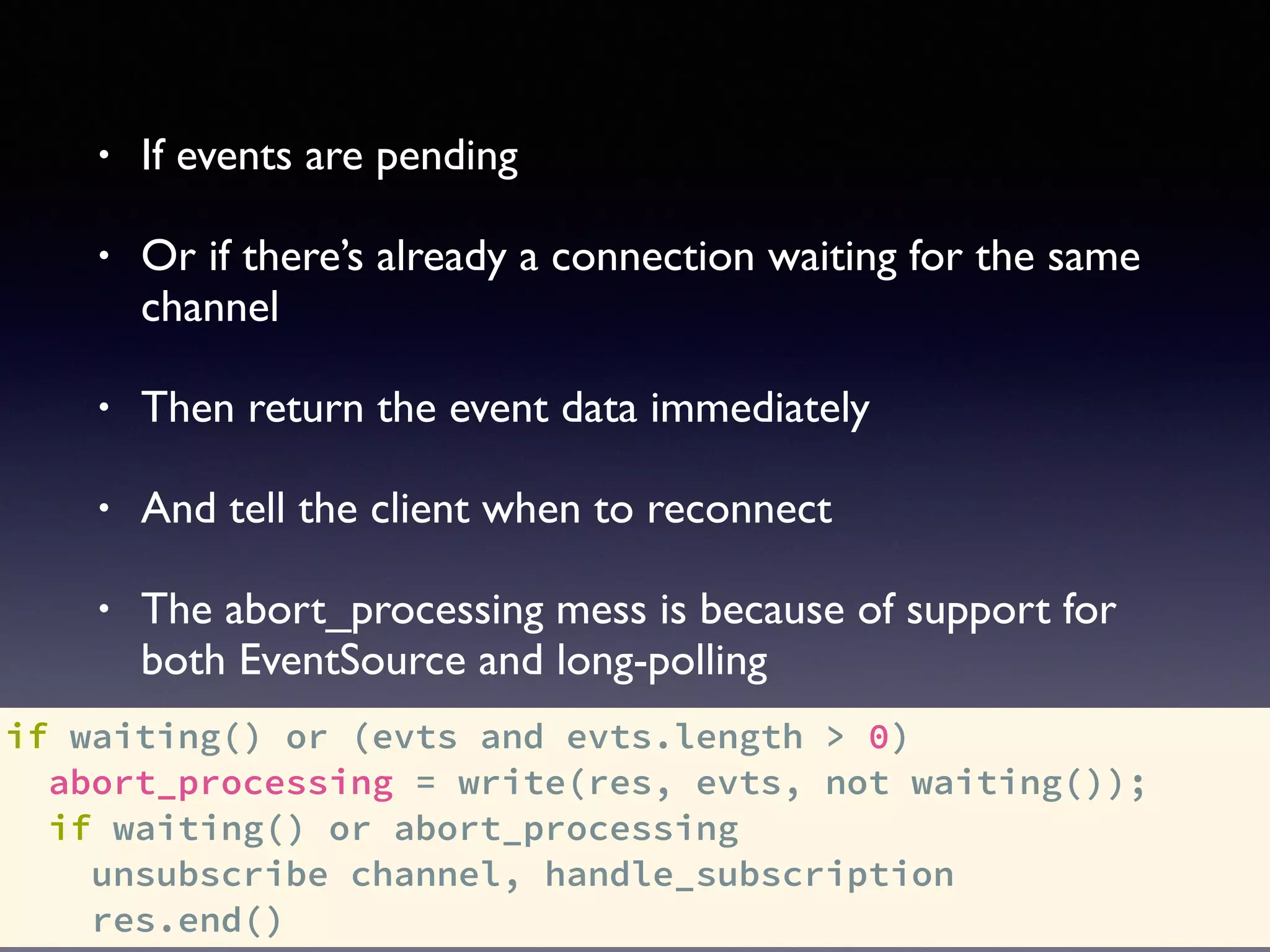
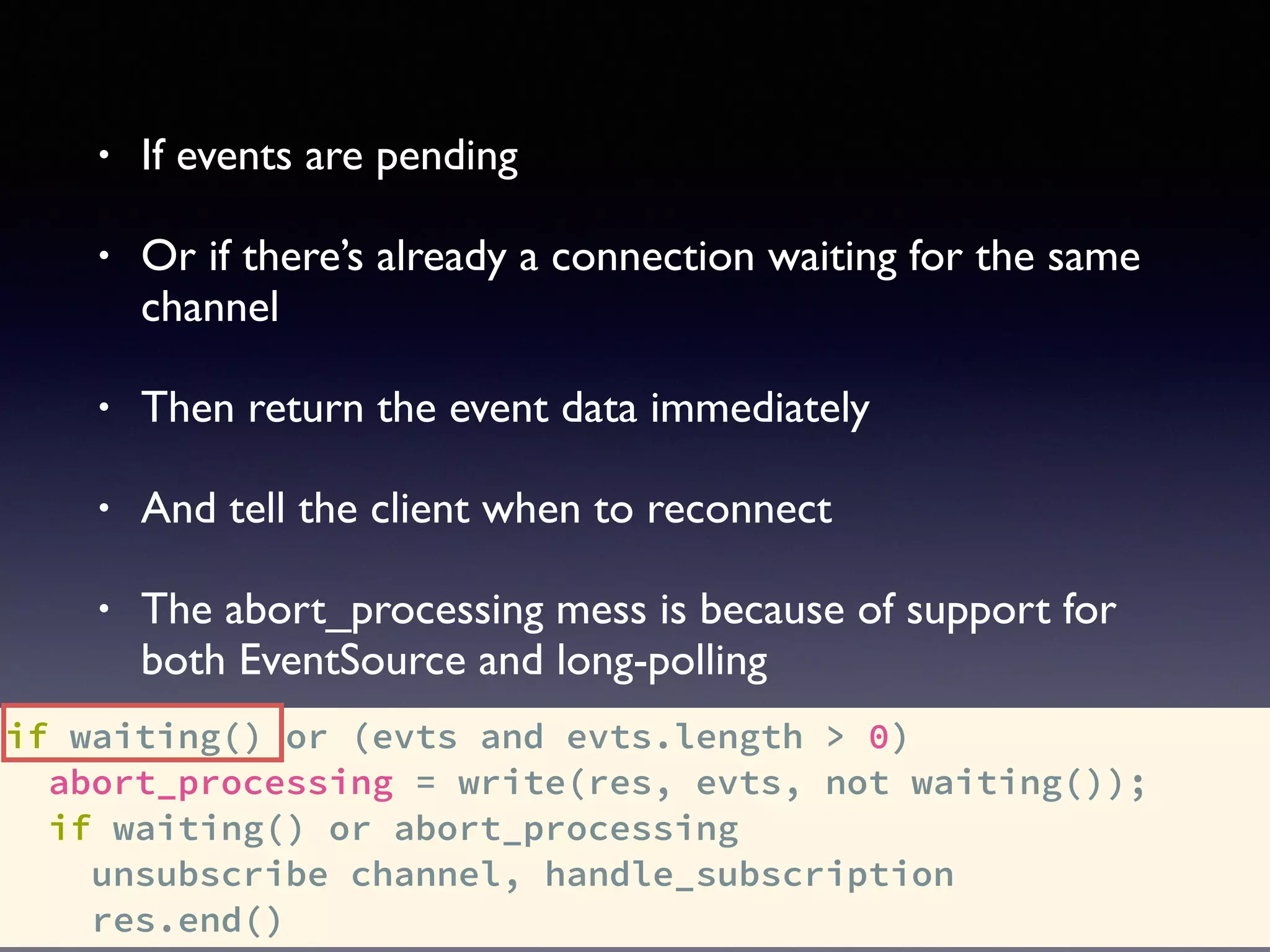
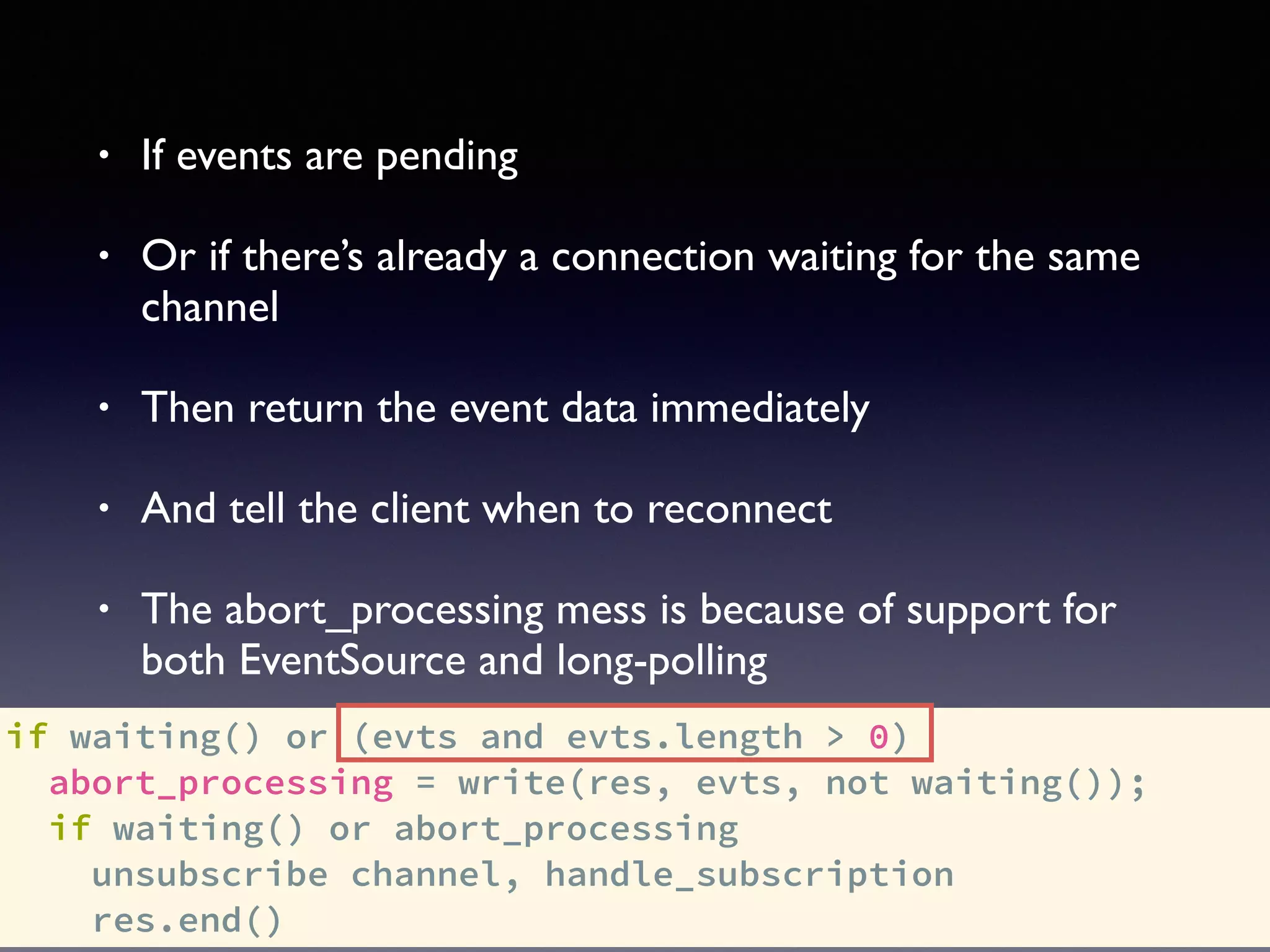
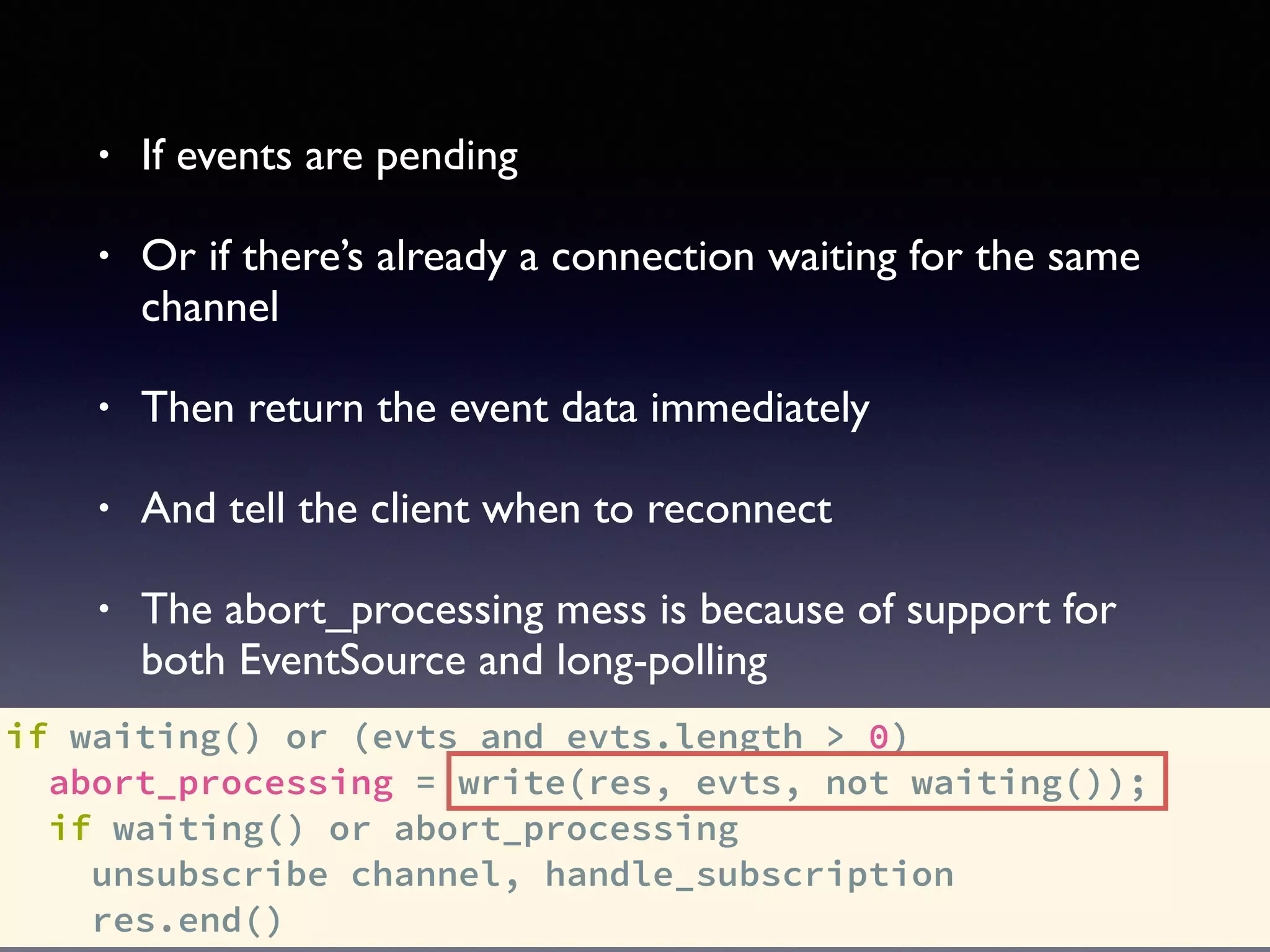
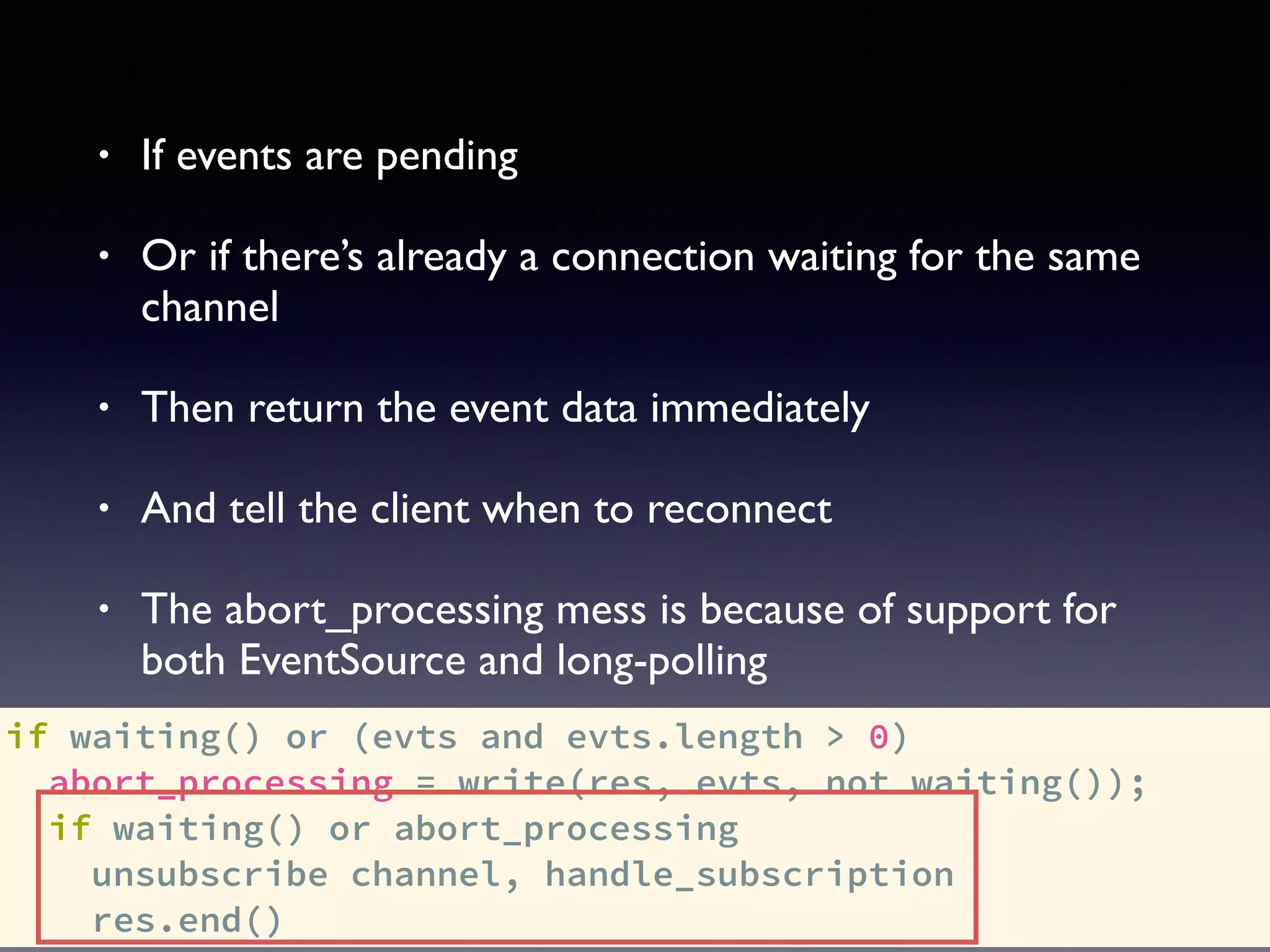
![handle_subscription = (c, message)->
fetch_events channel, last_event_id, (err, evts)->
return http_error 500, 'Failed to get event data' if err
abort_processing = write res, evts, true
last_event_id = evts[evts.length-1].id if (evts and evts.length > 0)
if abort_processing
unsubscribe channel, handle_subscription
clear_waiting()
res.end()
set_waiting()
subscribe channel, handle_subscription
Waiting](https://image.slidesharecdn.com/server-side-events-140727092852-phpapp01/75/Server-Side-Events-57-2048.jpg)
![handle_subscription = (c, message)->
fetch_events channel, last_event_id, (err, evts)->
return http_error 500, 'Failed to get event data' if err
abort_processing = write res, evts, true
last_event_id = evts[evts.length-1].id if (evts and evts.length > 0)
if abort_processing
unsubscribe channel, handle_subscription
clear_waiting()
res.end()
set_waiting()
subscribe channel, handle_subscription
Waiting](https://image.slidesharecdn.com/server-side-events-140727092852-phpapp01/75/Server-Side-Events-58-2048.jpg)
![handle_subscription = (c, message)->
fetch_events channel, last_event_id, (err, evts)->
return http_error 500, 'Failed to get event data' if err
abort_processing = write res, evts, true
last_event_id = evts[evts.length-1].id if (evts and evts.length > 0)
if abort_processing
unsubscribe channel, handle_subscription
clear_waiting()
res.end()
set_waiting()
subscribe channel, handle_subscription
Waiting](https://image.slidesharecdn.com/server-side-events-140727092852-phpapp01/75/Server-Side-Events-59-2048.jpg)
![handle_subscription = (c, message)->
fetch_events channel, last_event_id, (err, evts)->
return http_error 500, 'Failed to get event data' if err
abort_processing = write res, evts, true
last_event_id = evts[evts.length-1].id if (evts and evts.length > 0)
if abort_processing
unsubscribe channel, handle_subscription
clear_waiting()
res.end()
set_waiting()
subscribe channel, handle_subscription
Waiting](https://image.slidesharecdn.com/server-side-events-140727092852-phpapp01/75/Server-Side-Events-60-2048.jpg)
![handle_subscription = (c, message)->
fetch_events channel, last_event_id, (err, evts)->
return http_error 500, 'Failed to get event data' if err
abort_processing = write res, evts, true
last_event_id = evts[evts.length-1].id if (evts and evts.length > 0)
if abort_processing
unsubscribe channel, handle_subscription
clear_waiting()
res.end()
set_waiting()
subscribe channel, handle_subscription
Waiting
LOL - Boolean
parameter!!!](https://image.slidesharecdn.com/server-side-events-140727092852-phpapp01/75/Server-Side-Events-61-2048.jpg)
![handle_subscription = (c, message)->
fetch_events channel, last_event_id, (err, evts)->
return http_error 500, 'Failed to get event data' if err
abort_processing = write res, evts, true
last_event_id = evts[evts.length-1].id if (evts and evts.length > 0)
if abort_processing
unsubscribe channel, handle_subscription
clear_waiting()
res.end()
set_waiting()
subscribe channel, handle_subscription
Waiting](https://image.slidesharecdn.com/server-side-events-140727092852-phpapp01/75/Server-Side-Events-62-2048.jpg)

![Client is more complicated
poll: =>
url = "#{@endpoint}/#{@channel}/#{@wait_id}"
$.ajax url,
cache: false,
dataType: 'json',
headers:
'Last-Event-Id': @last_event_id
success: (data, s, xhr) =>
return unless @enabled
@fireAll data
reconnect_in = parseInt xhr.getResponseHeader('x-ps-reconnect-in'), 10
reconnect_in = 10 unless reconnect_in >= 0
setTimeout @poll, reconnect_in*1000 if @enabled
error: (xhr, textStatus, error) =>
return unless @enabled
# 504 means nginx gave up waiting. This is totally to be
# expected and we can just treat it as an invitation to
# reconnect immediately. All other cases are likely bad, so
# we remove a bit of load by waiting a really long time
# 12002 is the ie proprietary way to report an WinInet timeout
# if it was registry-hacked to a low ReadTimeout.
# This isn't a server-error, so we can just reconnect.
rc = if (xhr.status in [504, 12002]) || (textStatus == 'timeout') then 0 else 10000
setTimeout @poll, rc if @enabled](https://image.slidesharecdn.com/server-side-events-140727092852-phpapp01/75/Server-Side-Events-64-2048.jpg)
![Client is more complicated
poll: =>
url = "#{@endpoint}/#{@channel}/#{@wait_id}"
$.ajax url,
cache: false,
dataType: 'json',
headers:
'Last-Event-Id': @last_event_id
success: (data, s, xhr) =>
return unless @enabled
@fireAll data
reconnect_in = parseInt xhr.getResponseHeader('x-ps-reconnect-in'), 10
reconnect_in = 10 unless reconnect_in >= 0
setTimeout @poll, reconnect_in*1000 if @enabled
error: (xhr, textStatus, error) =>
return unless @enabled
# 504 means nginx gave up waiting. This is totally to be
# expected and we can just treat it as an invitation to
# reconnect immediately. All other cases are likely bad, so
# we remove a bit of load by waiting a really long time
# 12002 is the ie proprietary way to report an WinInet timeout
# if it was registry-hacked to a low ReadTimeout.
# This isn't a server-error, so we can just reconnect.
rc = if (xhr.status in [504, 12002]) || (textStatus == 'timeout') then 0 else 10000
setTimeout @poll, rc if @enabled](https://image.slidesharecdn.com/server-side-events-140727092852-phpapp01/75/Server-Side-Events-65-2048.jpg)
![Client is more complicated
poll: =>
url = "#{@endpoint}/#{@channel}/#{@wait_id}"
$.ajax url,
cache: false,
dataType: 'json',
headers:
'Last-Event-Id': @last_event_id
success: (data, s, xhr) =>
return unless @enabled
@fireAll data
reconnect_in = parseInt xhr.getResponseHeader('x-ps-reconnect-in'), 10
reconnect_in = 10 unless reconnect_in >= 0
setTimeout @poll, reconnect_in*1000 if @enabled
error: (xhr, textStatus, error) =>
return unless @enabled
# 504 means nginx gave up waiting. This is totally to be
# expected and we can just treat it as an invitation to
# reconnect immediately. All other cases are likely bad, so
# we remove a bit of load by waiting a really long time
# 12002 is the ie proprietary way to report an WinInet timeout
# if it was registry-hacked to a low ReadTimeout.
# This isn't a server-error, so we can just reconnect.
rc = if (xhr.status in [504, 12002]) || (textStatus == 'timeout') then 0 else 10000
setTimeout @poll, rc if @enabled](https://image.slidesharecdn.com/server-side-events-140727092852-phpapp01/75/Server-Side-Events-66-2048.jpg)
![Client is more complicated
poll: =>
url = "#{@endpoint}/#{@channel}/#{@wait_id}"
$.ajax url,
cache: false,
dataType: 'json',
headers:
'Last-Event-Id': @last_event_id
success: (data, s, xhr) =>
return unless @enabled
@fireAll data
reconnect_in = parseInt xhr.getResponseHeader('x-ps-reconnect-in'), 10
reconnect_in = 10 unless reconnect_in >= 0
setTimeout @poll, reconnect_in*1000 if @enabled
error: (xhr, textStatus, error) =>
return unless @enabled
# 504 means nginx gave up waiting. This is totally to be
# expected and we can just treat it as an invitation to
# reconnect immediately. All other cases are likely bad, so
# we remove a bit of load by waiting a really long time
# 12002 is the ie proprietary way to report an WinInet timeout
# if it was registry-hacked to a low ReadTimeout.
# This isn't a server-error, so we can just reconnect.
rc = if (xhr.status in [504, 12002]) || (textStatus == 'timeout') then 0 else 10000
setTimeout @poll, rc if @enabled](https://image.slidesharecdn.com/server-side-events-140727092852-phpapp01/75/Server-Side-Events-67-2048.jpg)
![Client is more complicated
poll: =>
url = "#{@endpoint}/#{@channel}/#{@wait_id}"
$.ajax url,
cache: false,
dataType: 'json',
headers:
'Last-Event-Id': @last_event_id
success: (data, s, xhr) =>
return unless @enabled
@fireAll data
reconnect_in = parseInt xhr.getResponseHeader('x-ps-reconnect-in'), 10
reconnect_in = 10 unless reconnect_in >= 0
setTimeout @poll, reconnect_in*1000 if @enabled
error: (xhr, textStatus, error) =>
return unless @enabled
# 504 means nginx gave up waiting. This is totally to be
# expected and we can just treat it as an invitation to
# reconnect immediately. All other cases are likely bad, so
# we remove a bit of load by waiting a really long time
# 12002 is the ie proprietary way to report an WinInet timeout
# if it was registry-hacked to a low ReadTimeout.
# This isn't a server-error, so we can just reconnect.
rc = if (xhr.status in [504, 12002]) || (textStatus == 'timeout') then 0 else 10000
setTimeout @poll, rc if @enabled](https://image.slidesharecdn.com/server-side-events-140727092852-phpapp01/75/Server-Side-Events-68-2048.jpg)
![Client is more complicated
poll: =>
url = "#{@endpoint}/#{@channel}/#{@wait_id}"
$.ajax url,
cache: false,
dataType: 'json',
headers:
'Last-Event-Id': @last_event_id
success: (data, s, xhr) =>
return unless @enabled
@fireAll data
reconnect_in = parseInt xhr.getResponseHeader('x-ps-reconnect-in'), 10
reconnect_in = 10 unless reconnect_in >= 0
setTimeout @poll, reconnect_in*1000 if @enabled
error: (xhr, textStatus, error) =>
return unless @enabled
# 504 means nginx gave up waiting. This is totally to be
# expected and we can just treat it as an invitation to
# reconnect immediately. All other cases are likely bad, so
# we remove a bit of load by waiting a really long time
# 12002 is the ie proprietary way to report an WinInet timeout
# if it was registry-hacked to a low ReadTimeout.
# This isn't a server-error, so we can just reconnect.
rc = if (xhr.status in [504, 12002]) || (textStatus == 'timeout') then 0 else 10000
setTimeout @poll, rc if @enabled](https://image.slidesharecdn.com/server-side-events-140727092852-phpapp01/75/Server-Side-Events-69-2048.jpg)
